
Home » Blog » Bluewater sailboats » The best bluewater sailboats under 40 feet (we analyzed 2,000 boats to find out)

The best bluewater sailboats under 40 feet (we analyzed 2,000 boats to find out)
By Author Fiona McGlynn
Posted on Last updated: August 17, 2023
What are the best bluewater sailboats under 40 feet?
Last year we analyzed 2,000 offshore designs to bring you a list of the most popular bluewater sailboats .
However, most people are searching for a boat in a particular size class. So, we decided to do a double-click and look at the best sailboats under 40 feet for offshore sailing.
If you’re interested in an even smaller boat, there are plenty of great options under 30 feet in our list of the best small sailboats for sailing around the world .
The characteristics that make a sailboat a bluewater sailboat are a hotly debated topic, so we wanted to use real-world data and find out what cruisers are using to cross oceans and sail around the world.
We looked at 2,000 boats that entered the Pacific Puddle Jump (PPJ) over the last 12 years. For those of you who aren’t familiar with the PPJ, it’s a rally that crosses the Pacific ocean. We took part in 2017 and had a ball!
Also, if you’re looking to buy one of the bluewater boats on this list, you might want to check out our post on the best places to buy used boats and how to find free or cheap boats for sale .
Just be aware that a bluewater boat isn’t necessarily offshore-ready. Our top five picks are all older boats and will undoubtedly require work.
Every cruiser we know made substantial repairs and additions before going offshore: adding watermakers , life rafts, solar panels, and more.
Also, always have a boat inspected by a professional and accredited marine surveyor before buying it or taking it offshore.
So, without further preamble, here are the best bluewater sailboats under 40 feet.
The best bluewater sailboats under 40 feet
1. the westsail 32.
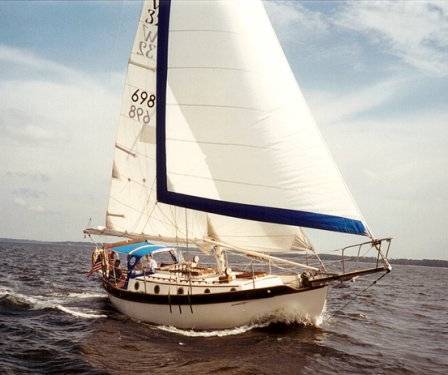
The Westsail 32 is one of the most iconic bluewater cruisers. Built by the Westsail Corporation in the 1970s, this plucky, small sailboat has developed a cult following over the decades. Since 2009, 19 have set out to cross the Pacific in the PPJ rallies.
The Westsail 32 is known for its sturdy construction, seaworthiness, and classic looks. In fact, it set the standard for what a real bluewater cruiser should look like. In 1973, the Westsail 32 was featured in Time magazine and inspired many Americans to go cruising.
Though popular, this boat has earned the unenviable nickname “ Wetsnail 32″, a reference to its poor ability to windward and sluggish performance. But Westsail 32 owners don’t care that they won’t be winning any races.
What the boat lacks in speed it makes up for in classic looks and excellent offshore cruising characteristics. Many owners have crossed oceans and circumnavigated the globe in their Westsail 32s.
| LOA | 32.00 ft / 9.75 m |
| First built | 1971 |
| Builder | Westsail (USA) |
| Designer | W. Crealock / W. Atkin |
| Hull type | Long keel, trans. hung rudder |
| Rig type | Cutter |
| Displacement | 19,500 lb / 8,845 kg |
2. Tayana 37
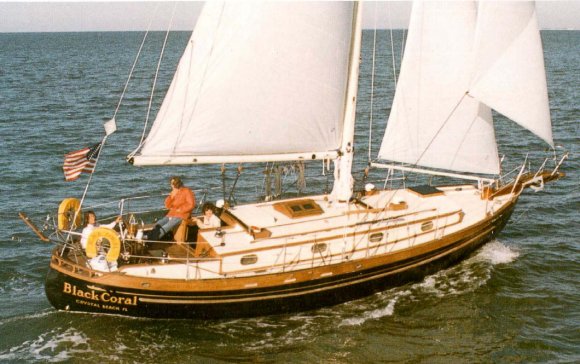
The Tayana 37 is a wildly popular Bob Perry design. It first rolled off the production line in 1976 and there are now several hundred of them sailing the world’s oceans.
Above the waterline, the Tayana 37 boasts beautiful traditional lines. However, Perry wanted to avoid the unenviable (read: sluggish) performance characteristics, associated with double-enders.
So, he designed the Tayana 37 with a cut-away long keel and moderate displacement, maintaining the classic look, while achieving reasonable performance.
The Tayana 37 has a devoted following of offshore enthusiasts. Since 2009, 12 Tayana 37s have set out to cross the Pacific in the PPJ rallies.
Read more about the Tayana 37 in this Practical Sailor review .
| LOA | 36.67 ft / 11.18 m |
| First built | 1976 |
| Builder | Ta Yang (TWN) |
| Designer | R. Perry |
| Hull type | Long keel |
| Rig type | Cutter |
| Displacement | 22,500 lb / 10,206 kg |
3. Hans Christian 38T
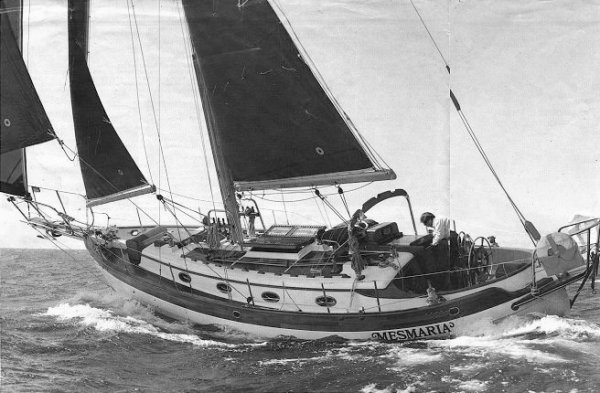
The Hans Christian 38T is a full-keeled, heavy displacement bluewater boat with a long bowsprit and a clipper bow, giving it a distinctive appearance. It was first introduced in 1976 and was produced until the early 1990s.
If you hadn’t already guessed, the “T” in the name stands for “Traditional”. Like many boats on this list, it takes a cue from Crealock’s famous Westsail 32 which sparked a craze in the 1970s and 80s for Scandinavian-style doubled-enders.
It’s gained a reputation as a capable and seaworthy cruising yacht. Many owners have crossed oceans and completed circumnavigations in Hans Christian 38Ts.
By our count, eight Hans Christian 38Ts have participated in Pacific Puddle Jump rallies over the last 12 years.
| LOA | 37.92 ft / 11.56 m |
| First built | 1976 |
| Builder | Anderson Yachts Ltd. (TAIWAN) |
| Designer | Harwood Ives |
| Hull type | Long keel |
| Rig type | Cutter |
| Displacement | 26,500 lb / 12,020 kg |
4. Island Packet 380
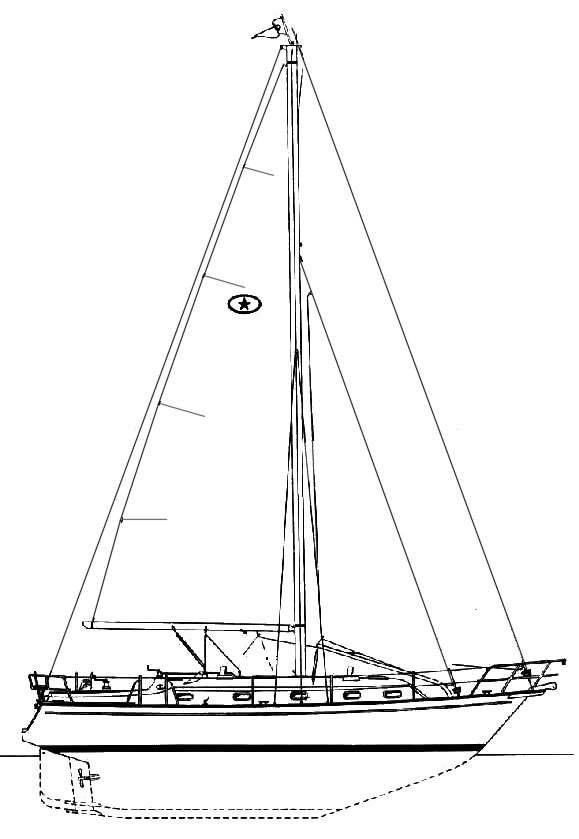
I’ve always considered Island Packets the Rolls-Royce of the bluewater boat world. Their distinctive cream-colored topsides make them easy to spot and their robust bluewater construction makes them the envy of many far-flung anchorages.
Designed by Bob Johnson and built by Island Packet Yachts in Florida, the Island Packet 380 was first introduced in 1998. 169 were built before 2004, over which time it gained a reputation as a capable and comfortable offshore cruiser.
Having been built in the ’90s and early 2000s, this is a relatively newer boat. In many ways, it offers the best of both worlds, a classic-looking boat with all the modern cruising conveniences.
The Island Packet 380 design prioritizes safety and stability. It also has several offshore features including standard twin bow rollers, a divided anchor locker, and ample storage for cruising gear.
Life below deck is comfortable too. With a 13-foot (4 meter) beam there’s plenty of room for liveaboard amenities.
The Island Packet 380 is a popular choice for long-distance cruising and offshore passages. Since 2009, six Island Packet 380s have set out to cross the Pacific in PPJ rallies.
Read more about the Island Packet 380 in this review by Yachting Monthly .
| LOA | 39.58 ft / 12.06 m |
| First built | 1998 |
| Builder | Island Packet Yachts (USA) |
| Designer | Bob Johnson |
| Hull type | Long keel |
| Rig type | Cutter |
| Displacement | 21,000 lb / 9,525 kg |
5. Ingrid 38
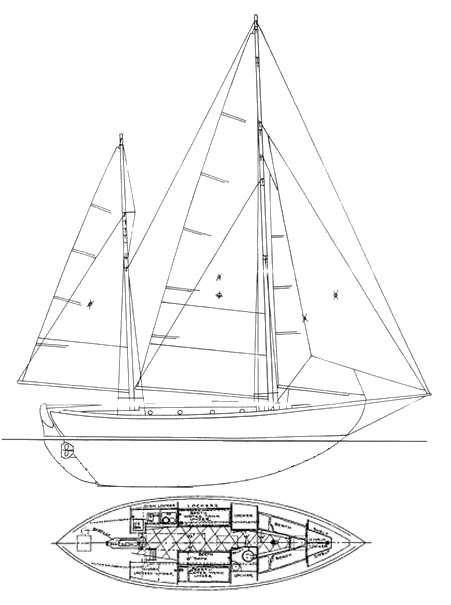
The Ingrid 38 is a double-ended sailboat that was originally designed for wood construction in 1938.
In 1971, Bluewater Boat Co. began building a fiberglass version. The design proved hugely popular and more than 140 were built.
With a full keep and heavy displacement, the Ingrid 38 epitomizes the traditional bluewater cruiser. Yet, it remains a well-loved design today. Since 2009, six Ingrid 38s have set out to cross the Pacific in PPJ rallies.
| LOA | 38.00 ft / 11.58 m |
| First built | 1938 |
| Builder | Bluewater Boat Company (USA) |
| Designer | William Atkin |
| Hull type | Long Keel |
| Rig type | Cutter |
| Displacement | 26,000 lb / 11,793 kg |
Description
Fiona McGlynn is an award-winning boating writer who created Waterborne as a place to learn about living aboard and traveling the world by sailboat. She has written for boating magazines including BoatUS, SAIL, Cruising World, and Good Old Boat. She’s also a contributing editor at Good Old Boat and BoatUS Magazine. In 2017, Fiona and her husband completed a 3-year, 13,000-mile voyage from Vancouver to Mexico to Australia on their 35-foot sailboat.
Terms and Conditions - Privacy Policy

5 Best Liveaboard Bluewater Sailboats

Last Updated by
Daniel Wade
December 28, 2023
Liveaboard bluewater sailboats are both comfortable to live on and capable of making long, offshore ocean voyages.
The best liveaboard bluewater sailboats must strike a balance between comfort and seakeeping abilities. These boats are generally heavy and stable and roomy enough to spend time in. They must also include the necessary hardware to make cooking, sleeping, and bathing possible in choppy conditions.
Table of contents
Bluewater Liveaboard Sailboat Design
What makes a good bluewater liveaboard sailboat , and how is it different from a coastal cruiser? There are a few aspects of purpose-built bluewater sailboats that make them different from most production vessels. The first and (possibly) most important is the hull design.
The classic bluewater sailboat hull shape features a long, deep, full keel. The keel acts as a hydroplane and keeps the boat stable on course in all sea conditions. Deep keel sailboats aren't the only kind of bluewater-capable vessels, but they're a tried and tested design.
Other vessels gain stability from having a wide beam. Beamy sailboats are far more comfortable in rolling seas, as they tend to buffett and pitch much less than leaner, narrow boats. Most ideal liveaboard bluewater sailboats balance length and beam carefully to make the most of the space and hull shape.
Space is another important quality to consider when choosing the best bluewater liveaboard sailboat. Interior space comes first, as living quarters are a key element of comfort.
Cockpit space should also be considered, especially if more than one person comes aboard. Most liveaboard bluewater sailboats sacrifice cockpit space for cabin space.
A comfortable liveaboard sailboat should include several amenities, including a head (toilet), a shower, two sinks, a galley with a stove, an icebox, a place to eat, and a place to sleep. Ideally, the dining area is separate from the primary sleeping area.
A separate chart table is ideal as well because it keeps food and clutter away from important navigational equipment. A chart table is less important on liveaboard sailboats that spend the majority of their time docked. That said, the chart table functions well as a spot for a microwave, toaster oven, or TV when you're not underway.
A separate forward V-berth, known as a master cabin, is a big plus on liveaboard boats. Separating the sleeping area from the rest of the cabin can increase comfort and coziness.
However, on a bluewater sailboat, a side berth near the hatch is essential as well. This is because you may need to quickly take control of the vessel after waking up, and it's best to sleep close to the helm.
Power and Water
Power and water shouldn't be overlooked when choosing a bluewater liveaboard. Many liveaboards spend most of their time docked and hooked up to shore power, water, and sewage. But bluewater liveaboards are designed for cruising, which means everything must be self-contained.
The best bluewater sailboats have sufficient freshwater storage tanks for several weeks on the water. Some have desalination (water maker) machines, which require electricity to run.
Solar panels are an excellent option for power generation, and they can be installed on almost any sailboat.
But all bluewater sailboats should have battery banks and a gasoline or diesel generator built into the system. On many vessels, the inboard engine also functions as a generator.
Safety is an essential factor to consider when choosing a cruising sailboat , especially if it doubles as your primary residence. Basic safety equipment such as bilge pumps and radios should be maintained and tested regularly. Backups and spare parts should also be kept aboard.
Other safety features, such as watertight hatches, can keep your cabin safe and dry during inclement weather. Self-draining cockpits are helpful when sailing offshore, as spray and waves drain from the exposed cockpit without the use of electric or mechanical pumps. If the drain ports are kept clean, no bailing is ever necessary.
Radar is another useful safety feature that, while not mandatory, can keep you in-the-know and alert you to the presence of nearby ships. Radar is especially useful at night, as the automatic alarms can wake you whenever a potential obstacle appears nearby.
Bluewater Sailboats for Living Aboard and Cruising
Living aboard a sailboat is one of the most interesting and rewarding lifestyles available today. It's even more alluring when you can sail your vessel across oceans, which is what bluewater sailboats are designed to do.
A liveaboard cruising sailboat combines comfort, seakeeping ability, and ease of handling in a compact and thoughtfully-designed package. Here are the best liveaboard sailboats for bluewater cruising.
1. Pacific Seacraft Flicka 20
{{boat-info="/boats/pacific-seacraft-flicka-20"}}
The Flicka 20 is the smallest and most interesting sailboat on our list. At only 20 feet overall in length, the interior accommodations of this vessel are spartan at best and suitable for minimalist living.
What makes the Flicka 20 stand out is its exceptional bluewater performance. This sailboat is truly an ultracompact pocket cruiser. With a full ballast keel, self-draining cockpit, and wide beam, the Flicka 20 is more capable offshore than some boats almost twice its size.
This sailboat has the profile of a traditional keel cruiser. From a distance, it would be easy to mistake for a much larger vessel. Its hull shape, manageable Bermuda rig, and small size make it a perfect starter sailboat for single handed offshore cruising.
Inside, you have (almost) everything you need to live comfortably, albeit in a minimalist way. The cabin features standing headroom throughout, which is highly unusual for a 20-foot sailboat. On the port side, you're greeted with a small but functional galley. On the starboard side, there's a small head with a toilet and a shower.
The Flicka 20 displaces a hardy 5,500 lbs. Due to its large keel, there's no centerboard trunk to obstruct interior space. A V-berth upfront makes up the sleeping accommodations, and some models feature settees on both sides with a pop-up dining and chart table in between.
The Pacific Seacraft Flicka 20 has achieved somewhat of a cult status amongst bluewater sailboat enthusiasts. Only about 400 were built, so purchasing a Flicka 20 is somewhat of a rare and expensive proposition. That said, the benefits of owning a 20-foot bluewater liveaboard sailboat are hard to beat.
Cheap slip fees, low maintenance costs, and simplicity are the major selling points of this vessel. It's trailerable behind most heavy-duty pickup trucks and technically small enough to store on the street or in a driveway.
2. Pacific Seacraft Allegra 24
{{boat-info="/boats/pacific-seacraft-allegra-24"}}
If the Flicka 20 is too small for your taste, try the Pacific Seacraft Allegra 24. It follows the same design principles of the Flicka 20, but with four feet of additional space for cabin amenities and seaworthiness.
Four feet may not sound like a lot, but it makes a world of difference on a sailboat. The additional space on the Allegra 24 adds room to the head, extends the port and starboard settees, and increases the size of the galley.
If you like the idea of a small, semi-trailerable offshore sailboat with liveaboard amenities, you'll love the Allegra 24. This stout sailboat has almost miraculous handling and seakeeping qualities while retaining the benefits of small overall size.
With the Allegra 24, you'll be able to make virtually any offshore passage and save on slip fees, maintenance costs, and overall labor. This vessel is easy to sail single handed and large enough for a minimalistic couple to live, eat, and sleep comfortably.
The Pacific Seacraft Allegra 24 is not ideal for people who need space for pets, children, or guests, as the interior is quite small when compared to other sailboats. That said, there's enough room for an occasional passenger, and the cockpit is comfortable enough for four adults to sit and interact.
3. O'Day 28
{{boat-info="/boats/oday-28"}}
The O'Day 28 is a popular sailboat that makes a great liveaboard cruising platform. This affordable vessel was produced between 1978 and 1986, and over 500 examples were produced over the years.
All in all, the O'Day 28 is a stout cruising sailboat that's suitable for offshore and coastal sailing. It features a raked stern and hidden rudder, and a helm that's similar to what you'd find on much larger boats.
The O'Day has a large fuel tank for its inboard engine and an even larger 25-gallon freshwater capacity, which is excellent for offshore cruising. Additional tanks can be added in storage spaces, making the O'Day 28 suitable for long voyages.
The cabin of the O'Day 28 is spacious and includes everything you'd need to live aboard comfortably, along with plenty of storage space throughout. The wide beam of the O'Day 28 gives it lots of space, so the cabin doesn't feel cramped for its size.
Two models of the O'Day 28 were built; one featured a swing keel, and the other had a fixed swing keel. The swing keel model is ideal for coastal cruising and shallow-water sailing, while the fixed keel O'Day 28 is more suited for bluewater cruising.
That said, both keel variants make fine offshore sailboats. The cabin of the O'Day 28 features a large galley with a stove and icebox, two large settee berths, a large center table ahead, and a V-berth forward. The head serves as a separator to the forward cabin, giving the V-berth an extra layer of privacy.
4. William Atkin "Eric" 32
{{boat-info="/boats/atkin-co-eric-32"}}
"Eric," designed in the 1920s by famous marine architect William Atkin, is a radical departure from typical modern liveaboard sailboats. However, as a bluewater liveaboard sailboat, this vessel likely outshines all the others on this list in almost every conceivable way.
Eric is a 32-foot traditional wooden ketch. This planked full- keel sailboat displaces over 19,000 lbs and has a draft of about five feet. The basic design of the hull is based on early Norweigian fishing boats, which were known for their resilience in rough North Sea storms.
Eric is a traditional gaff-rigged vessel with two short masts and a long bowsprit. Though complex to rig, it sails beautifully in all weather conditions. One of the earliest examples built survived a hurricane offshore in the 1930s, and subsequent models have completed numerous long-range ocean voyages.
Eric is a purpose-built long-range ocean cruiser. Interior accommodations are spacious and designed for comfort and utility. Unlike most sailboats of the time, Eric features a full head with shower, a 'master cabin' style V-berth forward, a full galley with an icebox, and standing headroom throughout.
William Atkin's Eric is, by all definitions, an ocean-crossing sailboat designed to take between one and four adults just about as far as they want to go. It has all the qualities of an oceangoing sailboat in a compact package, along with excellent seakeeping characteristics.
The primary drawback of this 32-foot Atkin sailboat is maintenance. Most of these hulls were constructed using traditional oak planking, which lasts forever if taken care of but requires skilled maintenance. The planks are caulked using cotton wadding, and they'll need recaulking if the boat stays out of the water for too long and "dries up."
If you're looking for a beautiful and historic liveaboard sailboat with serious offshore cruising capabilities, consider an Atkin Eric 32. Although somewhat rare, examples of this design occasionally pop up for sale on the used market.
5. Pearson 35
{{boat-info="/boats/oday-28"}}, {{boat-info="/boats/pearson-35"}}
The Pearson 35 crosses the rubicon into the 'big boat' category, as it has everything you'd expect of a large oceangoing sailboat. The vessel also has a unique displacement keel with an additional swing keel at the base.
The Pearson 35 is a roomy sailboat with excellent seakeeping abilities and a large sail plan. It's a typical Bermuda-rigged sloop with a tall mast and the usual sheet and halyard arrangement. As a result, it's fun to sail and easy to handle. It's also a fast boat, making it ideal for longer voyages.
The swing keel certainly doesn't make the Pearson 35 a shoal-draft sailboat. It has a modified full keel which (with the swing keel retracted) draws 3 feet 9 inches. With the additional swing keel down, the draft of the Pearson 35 increases to over 7 feet.
The Pearson 35 is a heavy boat with good sea keeping abilities. It was introduced in 1968, and over 500 units were produced. That makes it one of the more popular sailboats in its class, and plenty of Pearson 35s are still sailing around the United States.
Down below in the cabin, the Pearson 35 is roomy and comfortable. It features a full galley, an enclosed head with a shower and sink, and several berthing areas, including a forward V-berth. Plenty of storage is available throughout the cabin, making the Pearson 35 an excellent choice for living aboard.
There's something empowering about piloting a 35-foot sailboat through rough weather. The size of the boat provides both safety and a sense of security, which can help you keep a clear head during stressful situations at sea. The vessel is beamy as well, making it less likely to heel aggressively and increasing roll comfort in dicey seas.
Overall, the Pearson 35 is an excellent choice for a liveaboard bluewater sailboat. It's a large boat in comparison to the others on this list, and it's known for easy handling and excellent windward performance. The Pearson 35 is a common sailboat that's widely available on the used market.
Related Articles
I've personally had thousands of questions about sailing and sailboats over the years. As I learn and experience sailing, and the community, I share the answers that work and make sense to me, here on Life of Sailing.
by this author
Best Sailboats
Most Recent

What Does "Sailing By The Lee" Mean?
October 3, 2023

The Best Sailing Schools And Programs: Reviews & Ratings
September 26, 2023
Important Legal Info
Lifeofsailing.com is a participant in the Amazon Services LLC Associates Program, an affiliate advertising program designed to provide a means for sites to earn advertising fees by advertising and linking to Amazon. This site also participates in other affiliate programs and is compensated for referring traffic and business to these companies.
Similar Posts

Affordable Sailboats You Can Build at Home
September 13, 2023

Best Small Sailboats With Standing Headroom

Best Bluewater Sailboats Under $50K
Popular posts.

Best Liveaboard Catamaran Sailboats

Can a Novice Sail Around the World?
Elizabeth O'Malley
June 15, 2022

4 Best Electric Outboard Motors

How Long Did It Take The Vikings To Sail To England?

10 Best Sailboat Brands (And Why)
December 20, 2023

7 Best Places To Liveaboard A Sailboat
Get the best sailing content.
Top Rated Posts
Lifeofsailing.com is a participant in the Amazon Services LLC Associates Program, an affiliate advertising program designed to provide a means for sites to earn advertising fees by advertising and linking to Amazon. This site also participates in other affiliate programs and is compensated for referring traffic and business to these companies. (866) 342-SAIL
© 2024 Life of Sailing Email: [email protected] Address: 11816 Inwood Rd #3024 Dallas, TX 75244 Disclaimer Privacy Policy
- Yachting World
- Digital Edition

43 of the best bluewater sailboat designs of all time
- January 5, 2022
How do you choose the right yacht for you? We highlight the very best bluewater sailboat designs for every type of cruising

Which yacht is the best for bluewater boating? This question generates even more debate among sailors than questions about what’s the coolest yacht , or the best for racing. Whereas racing designs are measured against each other, cruising sailors get very limited opportunities to experience different yachts in real oceangoing conditions, so what is the best bluewater sailboat?
Here, we bring you our top choices from decades of designs and launches. Over the years, the Yachting World team has sailed these boats, tested them or judged them for European Yacht of the Year awards, and we have sifted through the many to curate a selection that we believe should be on your wishlist.
Making the right choice may come down to how you foresee your yacht being used after it has crossed an ocean or completed a passage: will you be living at anchor or cruising along the coast? If so, your guiding requirements will be space, cabin size, ease of launching a tender and anchoring closer to shore, and whether it can comfortably accommodate non-expert-sailor guests.
Article continues below…

The perfect boat: what makes an ideal offshore cruising yacht?
Choosing a boat for offshore cruising is not a decision to be taken lightly. I have researched this topic on…

European Yacht of the Year 2019: Best luxury cruisers
Before the sea trials began, I would have put money on a Hallberg-Rassy or the Wauquiez winning an award. The…
All of these considerations have generated the inexorable rise of the bluewater catamaran – monohulls can’t easily compete on these points. We have a full separate feature on the best bluewater multihulls of all time and here we mostly focus on monohulls. The only exceptions to that rule are two multihulls which made it into our best bluewater sailboats of 2022 list.
As so much of making the right choice is selecting the right boat for the venture in mind, we have separated out our edit into categories: best for comfort; for families; for performance; and for expedition or high latitudes sailing .
Best bluewater sailboats of 2022
The new flagship Allures 51.9, for example, is a no-nonsense adventure cruising design built and finished to a high standard. It retains Allures’ niche of using aluminium hulls with glassfibre decks and superstructures, which, the yard maintains, gives the optimum combination of least maintenance and less weight higher up. Priorities for this design were a full beam aft cabin and a spacious, long cockpit. Both are excellent, with the latter, at 6m long, offering formidable social, sailing and aft deck zones.
It likes some breeze to come to life on the wheel, but I appreciate that it’s designed to take up to five tonnes payload. And I like the ease with which you can change gears using the furling headsails and the positioning of the powerful Andersen winches inboard. The arch is standard and comes with a textile sprayhood or hard bimini.
Below decks you’ll find abundant headroom and natural light, a deep U-shape galley and cavernous stowage. For those who like the layout of the Amel 50 but would prefer aluminium or shoal draught, look no further.
Allures 51.9 price: €766,000
The Ovni 370 is another cunning new aluminum centreboard offering, a true deck saloon cruiser for two. The designers say the biggest challenge was to create a Category A ocean going yacht at this size with a lifting keel, hence the hull had to be very stable.
Enjoyable to helm, it has a practical, deep cockpit behind a large sprayhood, which can link to the bimini on the arch. Many of its most appealing features lie in the bright, light, contemporary, clever, voluminous interior, which has good stowage and tankage allocation. There’s also a practical navstation, a large workroom and a vast separate shower. I particularly like the convertible saloom, which can double as a large secure daybed or pilot berth.
Potentially the least expensive Category A lift keel boat available, the Ovni will get you dreaming of remote places again.
Ovni 370 price: €282,080

There’s no shortage of spirit in the Windelo 50. We gave this a sustainability award after it’s founders spent two years researching environmentally-friendly composite materials, developing an eco-composite of basalt fibre and recycled PET foam so it could build boats that halve the environmental impact of standard glassfibre yachts.
The Windelo 50 is an intriguing package – from the styling, modular interior and novel layout to the solar field on the roof and the standard electric propulsion, it is completely fresh.
Windelo 50 price: €795,000
Best bluewater sailboat of 2022 – Outremer 55
I would argue that this is the most successful new production yacht on the market. Well over 50 have already sold (an equipped model typically costs €1.6m) – and I can understand why. After all, were money no object, I had this design earmarked as the new yacht I would most likely choose for a world trip.
Indeed 55 number one Sanya, was fully equipped for a family’s world cruise, and left during our stay for the Grand Large Odyssey tour. Whereas we sailed Magic Kili, which was tricked up with performance options, including foam-cored deckheads and supports, carbon crossbeam and bulkheads, and synthetic rigging.
At rest, these are enticing space ships. Taking one out to sea is another matter though. These are speed machines with the size, scale and loads to be rightly weary of. Last month Nikki Henderson wrote a feature for us about how to manage a new breed of performance cruising cats just like this and how she coaches new owners. I could not think of wiser money spent for those who do not have ample multihull sailing experience.
Under sail, the most fun was obviously reserved for the reaching leg under asymmetric, where we clocked between 11-16 knots in 15-16 knots wind. But it was the stability and of those sustained low teen speeds which really hit home – passagemaking where you really cover miles.
Key features include the swing helms, which give you views from outboard, over the coachroof or from a protected position in the cockpit through the coachroof windows, and the vast island in the galley, which is key to an open plan main living area. It helps provide cavernous stowage and acts as the heart of the entertaining space as it would in a modern home. As Danish judge Morten Brandt-Rasmussen comments: “Apart from being the TGV of ocean passages the boat offers the most spacious, open and best integration of the cockpit and salon areas in the market.”
Outremer has done a top job in packing in the creature comforts, stowage space and payload capacity, while keeping it light enough to eat miles. Although a lot to absorb and handle, the 55 offers a formidable blend of speed and luxury cruising.
Outremer 55 price: €1.35m
Best bluewater sailboats for comfort
This is the successor to the legendary Super Maramu, a ketch design that for several decades defined easy downwind handling and fostered a cult following for the French yard. Nearly a decade old, the Amel 55 is the bridge between those world-girdling stalwarts and Amel’s more recent and totally re-imagined sloop designs, the Amel 50 and 60.
The 55 boasts all the serious features Amel aficionados loved and valued: a skeg-hung rudder, solidly built hull, watertight bulkheads, solid guardrails and rampart bulwarks. And, most noticeable, the solid doghouse in which the helmsman sits in perfect shelter at the wheel.
This is a design to live on comfortably for long periods and the list of standard features just goes on and on: passarelle; proper sea berths with lee cloths; electric furling main and genoa; and a multitude of practical items that go right down to a dishwasher and crockery.
There’s no getting around the fact these designs do look rather dated now, and through the development of easier sail handling systems the ketch rig has fallen out of fashion, but the Amel is nothing short of a phenomenon, and if you’ve never even peeked on board one, you really have missed a treat.

Photo: Sander van der Borch
Contest 50CS
A centre cockpit cruiser with true longevity, the Contest 50CS was launched by Conyplex back in 2003 and is still being built by the family-owned Dutch company, now in updated and restyled form.
With a fully balanced rudder, large wheel and modern underwater sections, the Contest 50CS is a surprisingly good performer for a boat that has a dry weight of 17.5 tonnes. Many were fitted with in-mast furling, which clearly curtails that performance, but even without, this boat is set up for a small crew.
Electric winches and mainsheet traveller are all easy to reach from the helm. On our test of the Contest 50CS, we saw for ourselves how two people can gybe downwind under spinnaker without undue drama. Upwind, a 105% genoa is so easy to tack it flatters even the weediest crewmember.
Down below, the finish level of the joinery work is up there among the best and the interior is full of clever touches, again updated and modernised since the early models. Never the cheapest bluewater sailing yacht around, the Contest 50CS has remained in demand as a brokerage buy. She is a reassuringly sure-footed, easily handled, very well built yacht that for all those reasons has stood the test of time.
This is a yacht that would be well capable of helping you extend your cruising grounds, almost without realising it.
Read more about the Contest 50CS and the new Contest 49CS

Photo: Rick Tomlinson
Hallberg-Rassy 48 Mk II
For many, the Swedish Hallberg-Rassy yard makes the quintessential bluewater cruiser for couples. With their distinctive blue cove line, these designs are famous for their seakindly behaviour, solid-as-a-rock build and beautifully finished, traditional interiors.
To some eyes, Hallberg-Rassys aren’t quite cool enough, but it’s been company owner Magnus Rassy’s confidence in the formula and belief in incremental ‘step-by-step’ evolution that has been such an exceptional guarantor of reliable quality, reputation and resale value.
The centre cockpit Hallberg-Rassy 48 epitomises the concept of comfort at sea and, like all the Frers-designed Hallberg-Rassys since the 1990s, is surprisingly fleet upwind as well as steady downwind. The 48 is perfectly able to be handled by a couple (as we found a few years back in the Pacific), and could with no great effort crack out 200-mile days.
The Hallberg-Rassy 48 was launched nearly a decade ago, but the Mk II from 2014 is our pick, updated with a more modern profile, larger windows and hull portlights that flood the saloon and aft cabin with light. With a large chart table, secure linear galley, heaps of stowage and space for bluewater extras such as machinery and gear, this yacht pretty much ticks all the boxes.

Discovery 55
First launched in 2000, the Discovery 55 has stood the test of time. Designed by Ron Holland, it hit a sweet spot in size that appealed to couples and families with world girdling plans.
Elegantly styled and well balanced, the 55 is also a practical design, with a deep and secure cockpit, comfortable seating, a self-tacking jib, dedicated stowage for the liferaft , a decent sugar scoop transom that’s useful for swimming or dinghy access, and very comfortable accommodation below. In short, it is a design that has been well thought out by those who’ve been there, got the bruises, stubbed their toes and vowed to change things in the future if they ever got the chance.
Throughout the accommodation there are plenty of examples of good detailing, from the proliferation of handholds and grabrails, to deep sinks in the galley offering immediate stowage when under way and the stand up/sit down showers. Stowage is good, too, with plenty of sensibly sized lockers in easily accessible positions.
The Discovery 55 has practical ideas and nifty details aplenty. She’s not, and never was, a breakthrough in modern luxury cruising but she is pretty, comfortable to sail and live on, and well mannered.

Photo: Latitudes Picture Library
You can’t get much more Cornish than a Rustler. The hulls of this Stephen Jones design are hand-moulded and fitted out in Falmouth – and few are more ruggedly built than this traditional, up-for-anything offshore cruiser.
She boasts an encapsulated lead keel, eliminating keel bolts and creating a sump for generous fuel and water tankage, while a chunky skeg protects the rudder. She is designed for good directional stability and load carrying ability. These are all features that lend this yacht confidence as it shoulders aside the rough stuff.
Most of those built have had a cutter rig, a flexible arrangement that makes sense for long passages in all sea and weather conditions. Down below, the galley and saloon berths are comfortable and sensible for living in port and at sea, with joinery that Rustler’s builders are rightly proud of.
As modern yachts have got wider, higher and fatter, the Rustler 42 is an exception. This is an exceptionally well-mannered seagoing yacht in the traditional vein, with elegant lines and pleasing overhangs, yet also surprisingly powerful. And although now over 20 years old, timeless looks and qualities mean this design makes her look ever more like a perennial, a modern classic.
The definitive crossover size, the point at which a yacht can be handled by a couple but is just large enough to have a professional skipper and be chartered, sits at around the 60ft mark. At 58ft 8in, the Oyster 575 fitted perfectly into this growing market when launched in 2010. It went on to be one of the most popular models from the yard, and is only now being superseded by the newer Rob Humphreys-designed Oyster 565 (just launched this spring).
Built in various configurations with either a deep keel, shoal draught keel or centreboard with twin rudders, owners could trade off better performance against easy access to shallower coves and anchorages. The deep-bodied hull, also by Rob Humphreys, is known for its easy motion at sea.
Some of the Oyster 575’s best features include its hallmark coachroof windows style and centre cockpit – almost everyone will know at first glance this is an Oyster – and superb interior finish. If she has a flaw, it is arguably the high cockpit, but the flip side is the galley headroom and passageway berth to the large aft stateroom.
This design also has a host of practical features for long-distance cruising, such as high guardrails, dedicated liferaft stowage, a vast lazarette for swallowing sails, tender, fenders etc, and a penthouse engine room.

Privilege Serie 5
A true luxury catamaran which, fully fitted out, will top €1m, this deserves to be seen alongside the likes of the Oyster 575, Gunfleet 58 and Hallberg-Rassy 55. It boasts a large cockpit and living area, and a light and spacious saloon with an emphasis on indoor-outdoor living, masses of refrigeration and a big galley.
Standout features are finish quality and solid build in a yacht designed to take a high payload, a secure walkaround deck and all-round views from the helm station. The new Privilege 510 that will replace this launches in February 2020.
Gunfleet 43
It was with this Tony Castro design that Richard Matthews, founder of Oyster Yachts, launched a brand new rival brand in 2012, the smallest of a range stretching to the flagship Gunfleet 74. The combination of short overhangs and centre cockpit at this size do make the Gunfleet 43 look modern if a little boxy, but time and subsequent design trends have been kind to her lines, and the build quality is excellent. The saloon, galley and aft cabin space is exceptional on a yacht of this size.

Photo: David Harding
Conceived as a belt-and-braces cruiser, the Kraken 50 launched last year. Its unique points lie underwater in the guise of a full skeg-hung rudder and so-called ‘Zero Keel’, an encapsulated long keel with lead ballast.
Kraken Yachts is the brainchild of British businessman and highly experienced cruiser Dick Beaumont, who is adamant that safety should be foremost in cruising yacht design and build. “There is no such thing as ‘one yacht for all purposes’… You cannot have the best of all worlds, whatever the salesman tells you,” he says.
Read our full review of the Kraken 50 .

Wauquiez Centurion 57
Few yachts can claim to be both an exciting Med-style design and a serious and practical northern European offshore cruiser, but the Wauquiez Centurion 57 tries to blend both. She slightly misses if you judge solely by either criterion, but is pretty and practical enough to suit her purpose.
A very pleasant, well-considered yacht, she is impressively built and finished with a warm and comfortable interior. More versatile than radical, she could be used for sailing across the Atlantic in comfort and raced with equal enjoyment at Antigua Sailing Week .

A modern classic if ever there was one. A medium to heavy displacement yacht, stiff and easily capable of standing up to her canvas. Pretty, traditional lines and layout below.

Photo: Voyage of Swell
Well-proven US legacy design dating back to the mid-1960s that once conquered the Transpac Race . Still admired as pretty, with slight spoon bow and overhanging transom.

Capable medium displacement cruiser, ideal size and good accommodation for couples or family cruising, and much less costly than similar luxury brands.

Photo: Peter Szamer
Swedish-built aft cockpit cruiser, smaller than many here, but a well-built and finished, super-durable pocket ocean cruiser.

Tartan 3700
Designed as a performance cruiser there are nimbler alternatives now, but this is still an extremely pretty yacht.
Broker ’ s choice

Discovery 55 Brizo
This yacht has already circumnavigated the globe and is ‘prepared for her next adventure,’ says broker Berthon. Price: £535,000 + VAT

Oyster 575 Ayesha
‘Stunning, and perfectly equipped for bluewater cruising,’ says broker Ancasta International. Price: £845,000 (tax not paid)

Oyster 575 Pearls of Nautilus
Nearly new and with a high spec, this Oyster Brokerage yacht features American white oak joinery and white leather upholstery and has a shoal draught keel. Price: $1.49m
Best bluewater yachts for performance
The Frers-designed Swan 54 may not be the newest hull shape but heralded Swan’s latest generation of displacement bluewater cruisers when launched four years ago. With raked stem, deep V hull form, lower freeboard and slight curve to the topsides she has a more timeless aesthetic than many modern slab-sided high volume yachts, and with that a seakindly motion in waves. If you plan to cover many miles to weather, this is probably the yacht you want to be on.

Photo: Carlo Borlenghi
Besides Swan’s superlative build quality, the 54 brings many true bluewater features, including a dedicated sail locker. There’s also a cockpit locker that functions as a utility cabin, with potential to hold your generator and washing machine, or be a workshop space.
The sloping transom opens out to reveal a 2.5m bathing platform, and although the cabins are not huge there is copious stowage space. Down below the top-notch oak joinery is well thought through with deep fiddles, and there is a substantial nav station. But the Swan 54 wins for handling above all, with well laid-out sail controls that can be easily managed between a couple, while offering real sailing enjoyment to the helmsman.

Photo: Graham Snook
The Performance Cruiser winner at the 2019 European Yacht of the Year awards, the Arcona 435 is all about the sailing experience. She has genuine potential as a cruiser-racer, but her strengths are as an enjoyable cruiser rather than a full-blown liveaboard bluewater boat.
Build quality is excellent, there is the option of a carbon hull and deck, and elegant lines and a plumb bow give the Arcona 435 good looks as well as excellent performance in light airs. Besides slick sail handling systems, there are well thought-out features for cruising, such as ample built-in rope bins and an optional semi-closed stern with stowage and swim platform.

Outremer 51
If you want the space and stability of a cat but still prioritise sailing performance, Outremer has built a reputation on building catamarans with true bluewater characteristics that have cruised the planet for the past 30 years.
Lighter and slimmer-hulled than most cruising cats, the Outremer 51 is all about sailing at faster speeds, more easily. The lower volume hulls and higher bridgedeck make for a better motion in waves, while owners report that being able to maintain a decent pace even under reduced canvas makes for stress-free passages. Deep daggerboards also give good upwind performance.
With bucket seats and tiller steering options, the Outremer 51 rewards sailors who want to spend time steering, while they’re famously well set up for handling with one person on deck. The compromise comes with the interior space – even with a relatively minimalist style, there is less cabin space and stowage volume than on the bulkier cats, but the Outremer 51 still packs in plenty of practical features.

The Xc45 was the first cruising yacht X-Yachts ever built, and designed to give the same X-Yachts sailing experience for sailors who’d spent years racing 30/40-footer X- and IMX designs, but in a cruising package.
Launched over 10 years ago, the Xc45 has been revisited a few times to increase the stowage and modernise some of the styling, but the key features remain the same, including substantial tanks set low for a low centre of gravity, and X-Yachts’ trademark steel keel grid structure. She has fairly traditional styling and layout, matched with solid build quality.
A soft bilge and V-shaped hull gives a kindly motion in waves, and the cockpit is secure, if narrow by modern standards.

A three or four cabin catamaran that’s fleet of foot with high bridgedeck clearance for comfortable motion at sea. With tall daggerboards and carbon construction in some high load areas, Catana cats are light and quick to accelerate.

Sweden Yachts 45
An established bluewater design that also features in plenty of offshore races. Some examples are specced with carbon rig and retractable bowsprits. All have a self-tacking jib for ease. Expect sweeping areas of teak above decks and a traditionally wooded interior with hanging wet locker.

A vintage performer, first launched in 1981, the 51 was the first Frers-designed Swan and marked a new era of iconic cruiser-racers. Some 36 of the Swan 51 were built, many still actively racing and cruising nearly 40 years on. Classic lines and a split cockpit make this a boat for helming, not sunbathing.

Photo: Julien Girardot / EYOTY
The JPK 45 comes from a French racing stable, combining race-winning design heritage with cruising amenities. What you see is what you get – there are no superfluous headliners or floorboards, but there are plenty of ocean sailing details, like inboard winches for safe trimming. The JPK 45 also has a brilliantly designed cockpit with an optional doghouse creating all-weather shelter, twin wheels and superb clutch and rope bin arrangement.

Photo: Andreas Lindlahr
For sailors who don’t mind exchanging a few creature comforts for downwind planing performance, the Pogo 50 offers double-digit surfing speeds for exhilarating tradewind sailing. There’s an open transom, tiller steering and no backstay or runners. The Pogo 50 also has a swing keel, to nose into shallow anchorages.

Seawind 1600
Seawinds are relatively unknown in Europe, but these bluewater cats are very popular in Australia. As would be expected from a Reichel-Pugh design, this 52-footer combines striking good looks and high performance, with fine entry bows and comparatively low freeboard. Rudders are foam cored lifting designs in cassettes, which offer straightforward access in case of repairs, while daggerboards are housed under the deck.
Best bluewater sailboats for families
It’s unsurprising that, for many families, it’s a catamaran that meets their requirements best of increased space – both living space and separate cabins for privacy-seeking teenagers, additional crew or visiting family – as well as stable and predictable handling.

Photo: Nicholas Claris
Undoubtedly one of the biggest success stories has been the Lagoon 450, which, together with boats like the Fountaine Pajot 44, helped drive up the popularity of catamaran cruising by making it affordable and accessible. They have sold in huge numbers – over 1,000 Lagoon 450s have been built since its launch in 2010.
The VPLP-designed 450 was originally launched with a flybridge with a near central helming position and upper level lounging areas (450F). The later ‘sport top’ option (450S) offered a starboard helm station and lower boom (and hence lower centre of gravity for reduced pitching). The 450S also gained a hull chine to create additional volume above the waterline. The Lagoon features forward lounging and aft cockpit areas for additional outdoor living space.
Besides being a big hit among charter operators, Lagoons have proven themselves over thousands of bluewater miles – there were seven Lagoon 450s in last year’s ARC alone. In what remains a competitive sector of the market, Lagoon has recently launched a new 46, with a larger self-tacking jib and mast moved aft, and more lounging areas.

Photo: Gilles Martin-Raget
Fountaine Pajot Helia 44
The FP Helia 44 is lighter, lower volume, and has a lower freeboard than the Lagoon, weighing in at 10.8 tonnes unloaded (compared to 15 for the 450). The helm station is on a mezzanine level two steps up from the bridgedeck, with a bench seat behind. A later ‘Evolution’ version was designed for liveaboard cruisers, featuring beefed up dinghy davits and an improved saloon space.
Available in three or four cabin layouts, the Helia 44 was also popular with charter owners as well as families. The new 45 promises additional volume, and an optional hydraulically lowered ‘beach club’ swim platform.

Photo: Arnaud De Buyzer / graphikup.com
The French RM 1370 might be less well known than the big brand names, but offers something a little bit different for anyone who wants a relatively voluminous cruising yacht. Designed by Marc Lombard, and beautifully built from plywood/epoxy, the RM is stiff and responsive, and sails superbly.
The RM yachts have a more individual look – in part down to the painted finish, which encourages many owners to personalise their yachts, but also thanks to their distinctive lines with reverse sheer and dreadnought bow. The cockpit is well laid out with the primary winches inboard for a secure trimming position. The interior is light, airy and modern, although the open transom won’t appeal to everyone.
For those wanting a monohull, the Hanse 575 hits a similar sweet spot to the popular multis, maximising accommodation for a realistic price, yet with responsive performance.
The Hanse offers a vast amount of living space thanks to the ‘loft design’ concept of having all the living areas on a single level, which gives a real feeling of spaciousness with no raised saloon or steps to accommodation. The trade-off for such lofty head height is a substantial freeboard – it towers above the pontoon, while, below, a stepladder is provided to reach some hatches.
Galley options include drawer fridge-freezers, microwave and coffee machine, and the full size nav station can double up as an office or study space.
But while the Hanse 575 is a seriously large boat, its popularity is also down to the fact that it is genuinely able to be handled by a couple. It was innovative in its deck layout: with a self-tacking jib and mainsheet winches immediately to hand next to the helm, one person could both steer and trim.
Direct steering gives a feeling of control and some tangible sailing fun, while the waterline length makes for rapid passage times. In 2016 the German yard launched the newer Hanse 588 model, having already sold 175 of the 575s in just four years.

Photo: Bertel Kolthof
Jeanneau 54
Jeanneau leads the way among production builders for versatile all-rounder yachts that balance sail performance and handling, ergonomics, liveaboard functionality and good looks. The Jeanneau 54 , part of the range designed by Philippe Briand with interior by Andrew Winch, melds the best of the larger and smaller models and is available in a vast array of layout options from two cabins/two heads right up to five cabins and three heads.
We’ve tested the Jeanneau 54 in a gale and very light winds, and it acquitted itself handsomely in both extremes. The primary and mainsheet winches are to hand next to the wheel, and the cockpit is spacious, protected and child-friendly. An electric folding swim and sun deck makes for quick fun in the water.

Nautitech Open 46
This was the first Nautitech catamaran to be built under the ownership of Bavaria, designed with an open-plan bridgedeck and cockpit for free-flowing living space. But with good pace for eating up bluewater miles, and aft twin helms rather than a flybridge, the Nautitech Open 46 also appeals to monohull sailors who prefer a more direct sailing experience.

Made by Robertson and Caine, who produce catamarans under a dual identity as both Leopard and the Sunsail/Moorings charter cats, the Leopard 45 is set to be another big seller. Reflecting its charter DNA, the Leopard 45 is voluminous, with stepped hulls for reduced waterline, and a separate forward cockpit.
Built in South Africa, they are robustly tested off the Cape and constructed ruggedly enough to handle heavy weather sailing as well as the demands of chartering.

Photo: Olivier Blanchet
If space is king then three hulls might be even better than two. The Neel 51 is rare as a cruising trimaran with enough space for proper liveaboard sailing. The galley and saloon are in the large central hull, together with an owner’s cabin on one level for a unique sensation of living above the water. Guest or family cabins lie in the outer hulls for privacy and there is a cavernous full height engine room under the cabin sole.
Performance is notably higher than an equivalent cruising cat, particularly in light winds, with a single rudder giving a truly direct feel in the helm, although manoeuvring a 50ft trimaran may daunt many sailors.

Beneteau Oceanis 46.1
A brilliant new model from Beneteau, this Finot Conq design has a modern stepped hull, which offers exhilarating and confidence-inspiring handling in big breezes, and slippery performance in lighter winds.
The Beneteau Oceanis 46.1 was the standout performer at this year’s European Yacht of the Year awards, and, in replacing the popular Oceanis 45, looks set to be another bestseller. Interior space is well used with a double island berth in the forepeak. An additional inboard unit creates a secure galley area, but tank capacity is moderate for long periods aboard.

Beneteau Oceanis 473
A popular model that offers beam and height in a functional layout, although, as with many boats of this age (she was launched in 2002), the mainsheet is not within reach of the helmsman.

Jeanneau Sun Odyssey 49
The Philippe Briand-designed Sun Odyssey range has a solid reputation as family production cruisers. Like the 473, the Sun Odyssey 49 was popular for charter so there are plenty of four-cabin models on the market.

Nautitech 441
The hull design dates back to 1995, but was relaunched in 2012. Though the saloon interior has dated, the 441 has solid practical features, such as a rainwater run-off collection gutter around the coachroof.

Atlantic 42
Chris White-designed cats feature a pilothouse and forward waist-high working cockpit with helm position, as well as an inside wheel at the nav station. The Atlantic 42 offers limited accommodation by modern cat standards but a very different sailing experience.
Best bluewater sailing yachts for expeditions
Bestevaer 56.
All of the yachts in our ‘expedition’ category are aluminium-hulled designs suitable for high latitude sailing, and all are exceptional yachts. But the Bestevaer 56 is a spectacular amount of boat to take on a true adventure. Each Bestevaer is a near-custom build with plenty of bespoke options for owners to customise the layout and where they fall on the scale of rugged off-grid adventurer to 4×4-style luxury fit out.

The Bestevaer range began when renowned naval architect Gerard Dijkstra chose to design his own personal yacht for liveaboard adventure cruising, a 53-footer. The concept drew plenty of interest from bluewater sailors wanting to make longer expeditions and Bestevaers are now available in a range of sizes, with the 56-footer proving a popular mid-range length.
The well-known Bestevaer 56 Tranquilo (pictured above) has a deep, secure cockpit, voluminous tanks (700lt water and over 1,100lt fuel) and a lifting keel plus water ballast, with classically styled teak clad decks and pilot house. Other owners have opted for functional bare aluminium hull and deck, some choose a doghouse and others a pilothouse.

Photo: Jean-Marie Liot
The Boreal 52 also offers Land Rover-esque practicality, with utilitarian bare aluminium hulls and a distinctive double-level doghouse/coachroof arrangement for added protection in all weathers. The cockpit is clean and uncluttered, thanks to the mainsheet position on top of the doghouse, although for visibility in close manoeuvring the helmsman will want to step up onto the aft deck.
Twin daggerboards, a lifting centreboard and long skeg on which she can settle make this a true go-anywhere expedition yacht. The metres of chain required for adventurous anchoring is stowed in a special locker by the mast to keep the weight central. Down below has been thought through with equally practical touches, including plenty of bracing points and lighting that switches on to red light first to protect your night vision.

Photo: Morris Adant / Garcia Yachts
Garcia Exploration 45
The Garcia Exploration 45 comes with real experience behind her – she was created in association with Jimmy Cornell, based on his many hundreds of thousands of miles of bluewater cruising, to go anywhere from high latitudes to the tropics.
Arguably less of a looker than the Bestevaer, the Garcia Exploration 45 features a rounded aluminium hull, centreboard with deep skeg and twin daggerboards. The considerable anchor chain weight has again been brought aft, this time via a special conduit to a watertight locker in front of the centreboard.
This is a yacht designed to be lived on for extended periods with ample storage, and panoramic portlights to give a near 360° view of whichever extraordinary landscape you are exploring. Safety features include a watertight companionway door to keep extreme weather out and through-hull fittings placed above the waterline. When former Vendée Globe skipper Pete Goss went cruising , this was the boat he chose to do it in.

Photo: svnaima.com
A truly well-proven expedition design, some 1,500 Ovnis have been built and many sailed to some of the most far-flung corners of the world. (Jimmy Cornell sailed his Aventura some 30,000 miles, including two Drake Passage crossings, one in 50 knots of wind).

Futuna Exploration 54
Another aluminium design with a swinging centreboard and a solid enclosed pilothouse with protected cockpit area. There’s a chunky bowsprit and substantial transom arch to house all manner of electronics and power generation.
Previous boats have been spec’d for North West Passage crossings with additional heating and engine power, although there’s a carbon rig option for those that want a touch of the black stuff. The tanks are capacious, with 1,000lt capability for both fresh water and fuel.
If you enjoyed this….
Yachting World is the world’s leading magazine for bluewater cruisers and offshore sailors. Every month we have inspirational adventures and practical features to help you realise your sailing dreams. Build your knowledge with a subscription delivered to your door. See our latest offers and save at least 30% off the cover price.
- BOAT OF THE YEAR
- Newsletters
- Sailboat Reviews
- Boating Safety
- Sails and Rigging
- Maintenance
- Sailing Totem
- Sailor & Galley
- Living Aboard
- Destinations
- Gear & Electronics
- Charter Resources
- Ultimate Boat Giveaway

10 New Cruising Sailboats Under 35 Feet
- By Cruising World Staff
- Updated: November 3, 2020
It wasn’t so long ago that 30- to 35-foot cruising sailboats were likely to be the largest yachts found in many a harbor. And while 40-something and even 50-something footers are all the rage at boat shows today, there’s a lot to be said for setting sail on a boat big enough to carry family and friends, but still small enough to be easily maintained and handled alone from time to time. Small cruising sailboats are simple to dock or tie up to a mooring, and finding long-term marina space is easier as well.
Choosing a cruising sailboat, no matter the size, is a big decision. And it helps to have a trusted list of boats to get started. Here, then, is a look at 10 of the best daysailers , weekenders and coastal cruising sailboats under 35 feet that are all in production and can be purchased new.
Alerion Sport 30
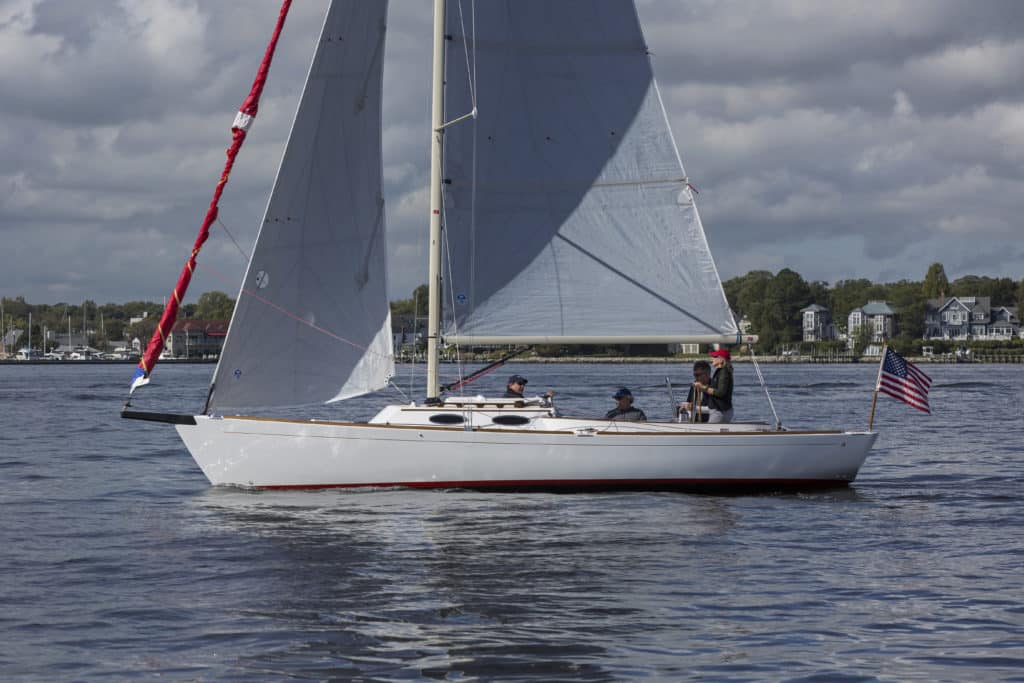
A quarter-century ago, Garry Hoyt launched what would come to be known as the daysailer genre with the introduction of the Alerion Express 28, a boat designed by the late Carl Schumacher that featured a minimal interior and a large cockpit where an owner and guests could enjoy the simple joy of sailing. Traditional and lovely looking—but with a quite modern underbody and a powerful sail plan—Hoyt, ever the marketer, proclaimed the boat to be “the prettiest girl at the dance.”
Since then, a number of siblings ranging from 20 to 41 feet have been added to the Alerion family, including the Alerion Sport 30, which retains the graceful sheer line, oval ports and stylish overhangs of the original Schumacher design. Yet with input from naval architect Langan Design Partners, it also embraces a solid measure of performance-oriented DNA.
Read more about the Alerion Sport 30 »
Bavaria Cruiser 34
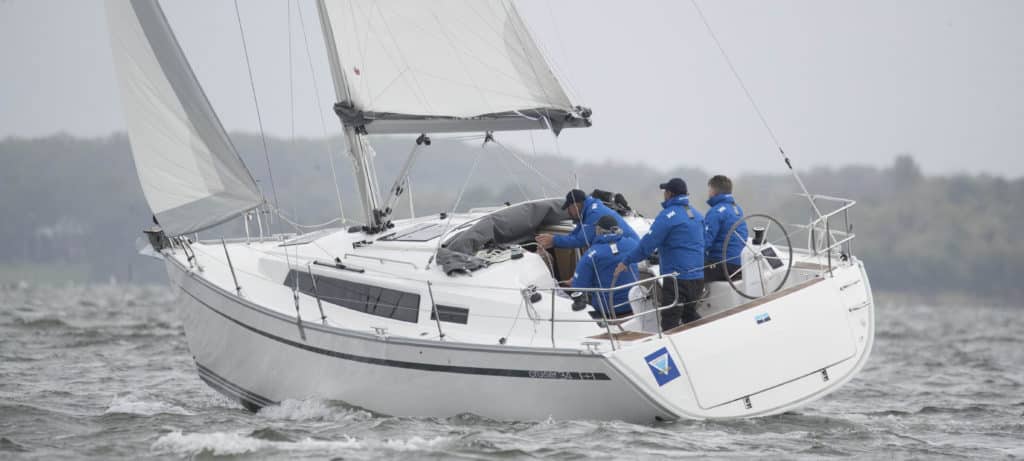
In every Boat of the Year contest, it seems, a boat rises up after sea trials to make a lasting impression on the judges. For 2018, that boat was the Bavaria Cruiser 34.
Says Boat of the Year Judge Tim Murphy, “The Bavaria was a lovely boat to sail. It has a single rudder, and she answered her helm just beautifully in the conditions we had today. We started off with around 10 knots of breeze that built to 13 to 15 knots. As a sailboat, it was just a pleasurable sailing experience, among the best we had during our judging. It was among the boats that felt like a really happy sailing experience.
Read more about the Bavaria Cruiser 34 »
Beneteau Oceanis 30.1
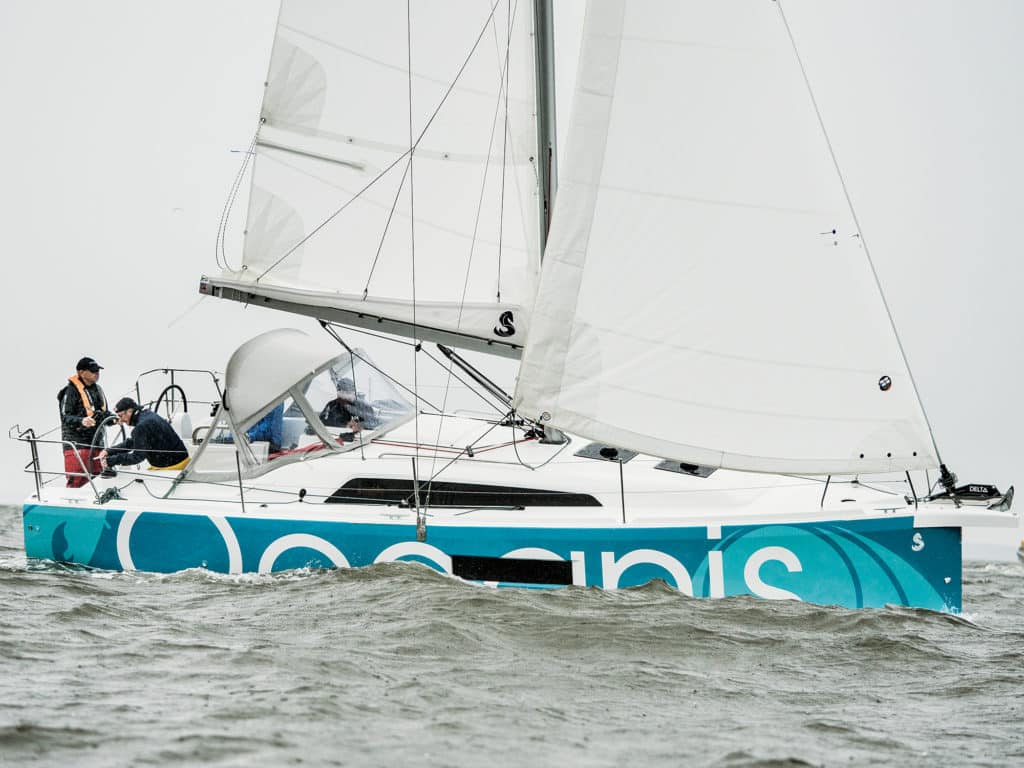
Sailed as part of the 2020 Boat of the Year sea trials, the 31-foot-3-inch Beneteau Oceanis 30.1 was the compact yacht best-equipped and spec’d out as a dedicated cruising boat, and not coincidentally, it was also awarded the title of Best Performance Cruiser for 2020. But don’t let her cozy interior accommodations fool you; this is also one peppy little vessel.
Read more about the Beneteau Oceanis 30.1 »
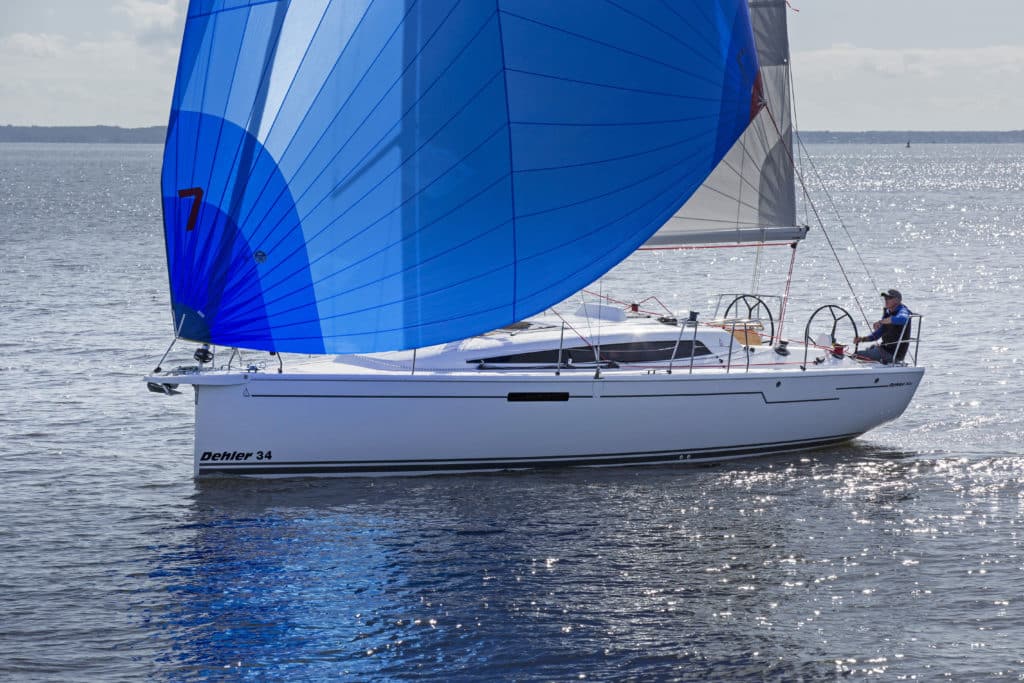
The 2017 Boat of the Year (BOTY) contest featured a stellar crop of crossover cruiser/racers; however, when all the testing was said and done, our independent panel of judges was sold on the Dehler 34, naming it the year’s Best Performance Cruiser. Designed by the highly regarded Judel/Vrolijk naval-architecture consortium, whose reputation was fostered by longtime success in international yacht-racing circles, the 34-footer combined contemporary good looks and a sweet turn of speed with better-than-average comfort and accommodations below. It didn’t hurt that the boat, nicely equipped at $215,000, was the least-expensive entry in the entire 2017 fleet. All in all, it proved to be a winning formula.
Read more about the Dehler 34 »
Dufour Grand Large 360
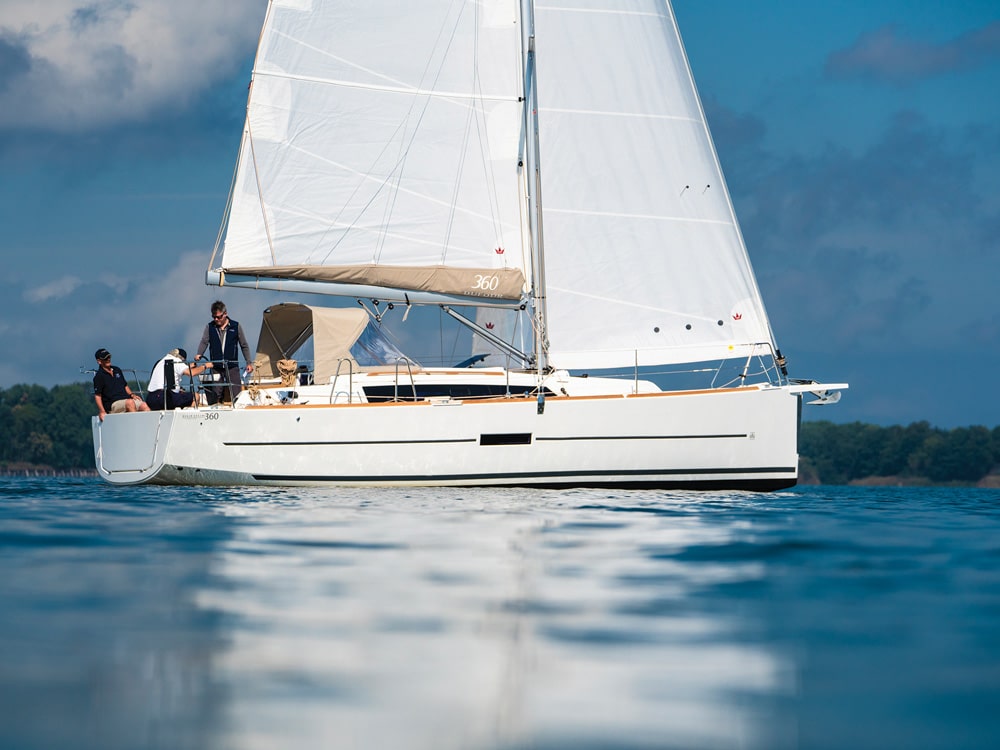
Dufour Yachts introduced its new 360 Grand Large model to CW’s Boat of the Year team in 2018 as a coastal cruiser intended for a couple or perhaps a small family. With that in mind, judge Alvah Simon found numerous clever elements to praise within the boat’s 35-foot-2-inch hull—a relatively modest LOA compared to the many 40-, 50- and 60-footers on display at the U.S. Sailboat show in Annapolis, Maryland.
Read more about the Dufour Grand Large 360 »
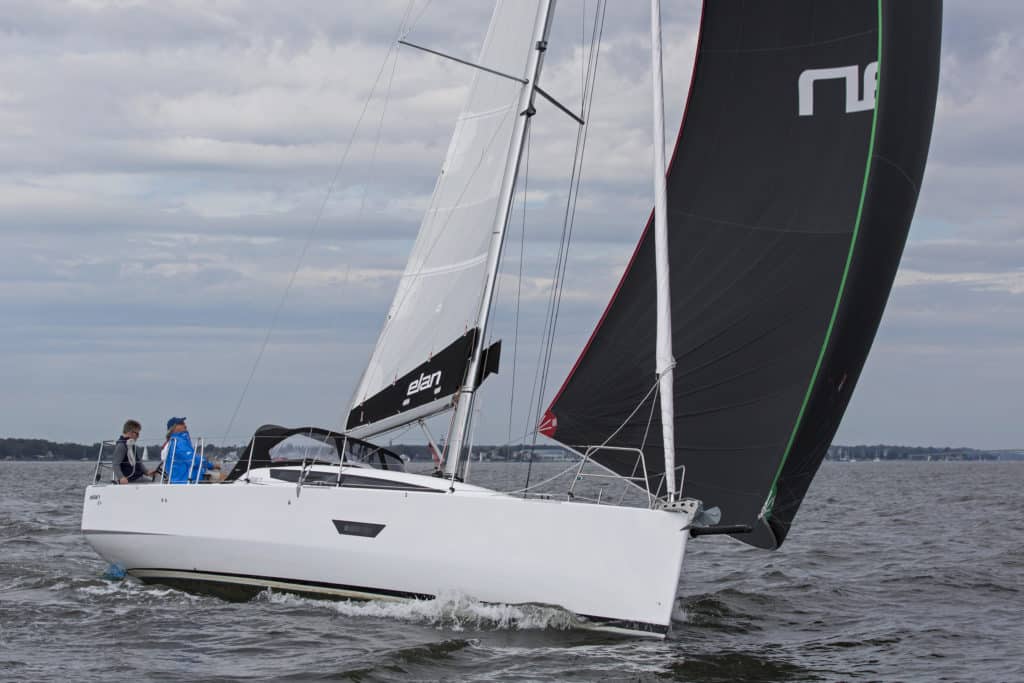
After a roughly 10-year hiatus from the U.S. marketplace, the Slovenian builder Elan is back in a big way. For the 2017 Boat of the Year contest, the company launched a pair of new boats in the States, including the Elan E4, a 34-foot-9-inch performance cruiser with an emphasis on performing, designed by renowned British naval architect Rob Humphreys. The brand has been in business for seven decades and lately is perhaps even better known in America for its skis. Not surprisingly, given its complementary product lines—lots of sailors are fine skiers—its boats are as sleek and sporty as its boards.
Read more about the Elan E4 »
Grand Soleil 34
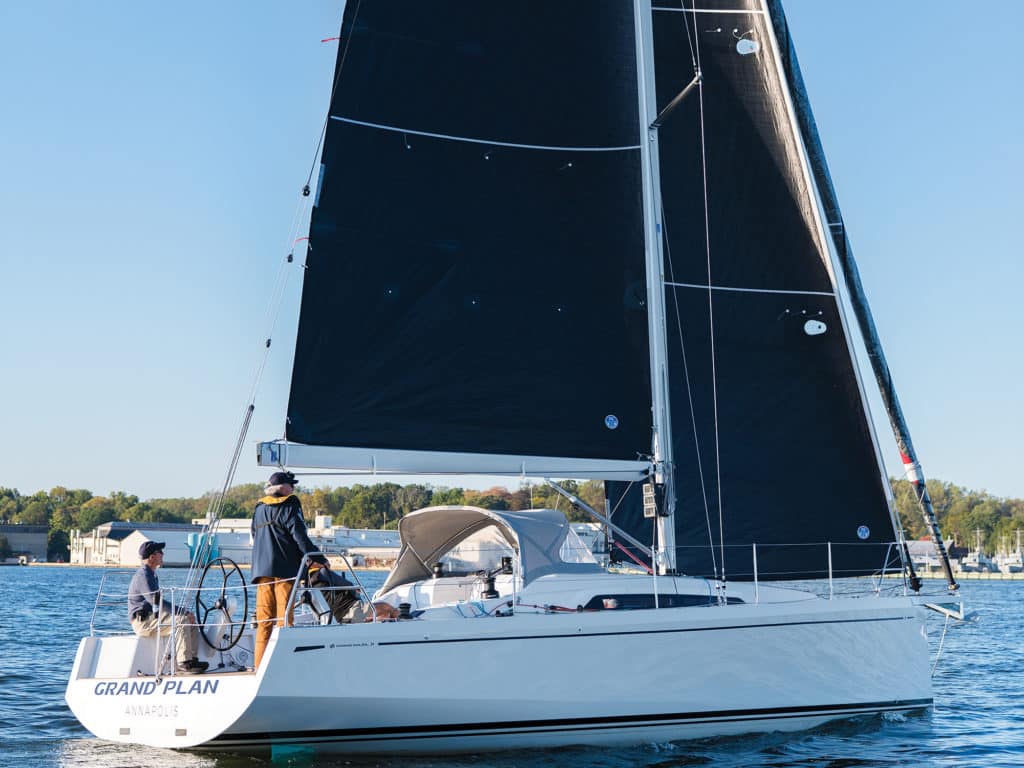
Way back in the 1970s, when the well-known Italian boatyard Grand Soleil was just getting started, its first model was a Finot-designed 34-footer. With over 300 units sold, it was an instant success, and launched the company on an upward trajectory that spanned the intervening decades, mostly with an ongoing series of much larger, more complex racer/cruisers. For 2020, the builder decided to return to its roots with a completely revamped Grand Soleil 34, and it’s a terrific boat.
Read more about the Grand Soleil 34 »
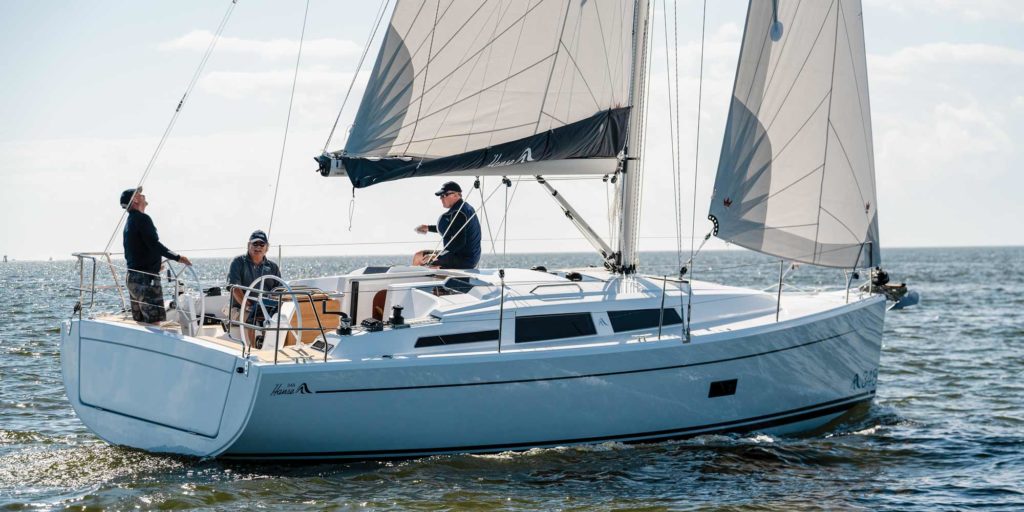
Value. How does one determine it? Price is most certainly a factor. In the case of new boats, and our Boat of the Year competition, it means something more. As sailors, we wish to recognize good boats that not only are affordable but offer other, tangible rewards. The ability to get couples and families out on the water, to have a weekend escape, to take them on coastal vacations and even maybe a sabbatical to the islands, all without breaking the bank. For 2019, the judging panel determined that one boat had the potential to do these things better than the rest, which is why they awarded the Best Value prize to the Hanse 348.
With a price tag under $200,000, during sea trials the Hanse 348 wowed the judging team from the get-go. “In only about 8 knots of breeze, we were seeing 5.7 knots upwind and pointing very nicely, and even registered 6.5 knots once we cracked off,” said Tim Murphy. “It’s a pretty sweet little boat.”
Read more about the Hanse 348 »
Italia 9.98
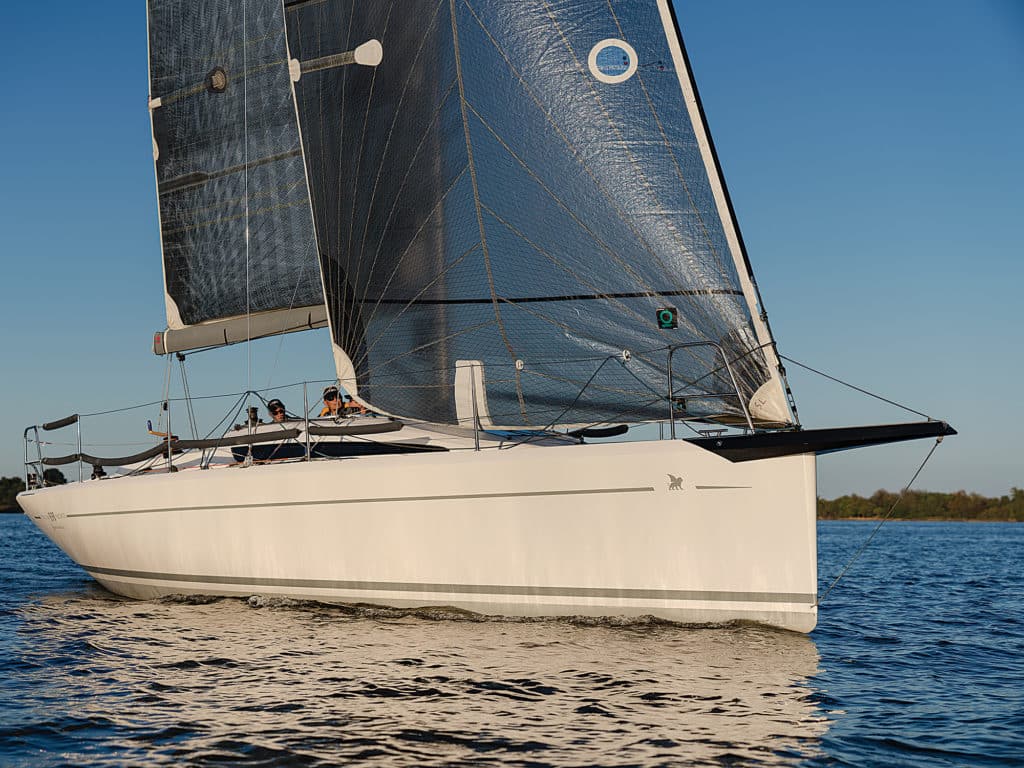
Of the performance cruisers that made their North American debut in 2020, in terms of sheer appearance, the futuristic 34-foot Italia 9.98 was easily the most distinctive. There are actually two versions of the boat: the 34 Club—which is the cruising alternative, the primary features of which are its twin wheels—and the 34 Fuoriserie—the racing model, and the one we tested, with its tiller steering being the identifying characteristic.
Read more about the Italia 9.98 »
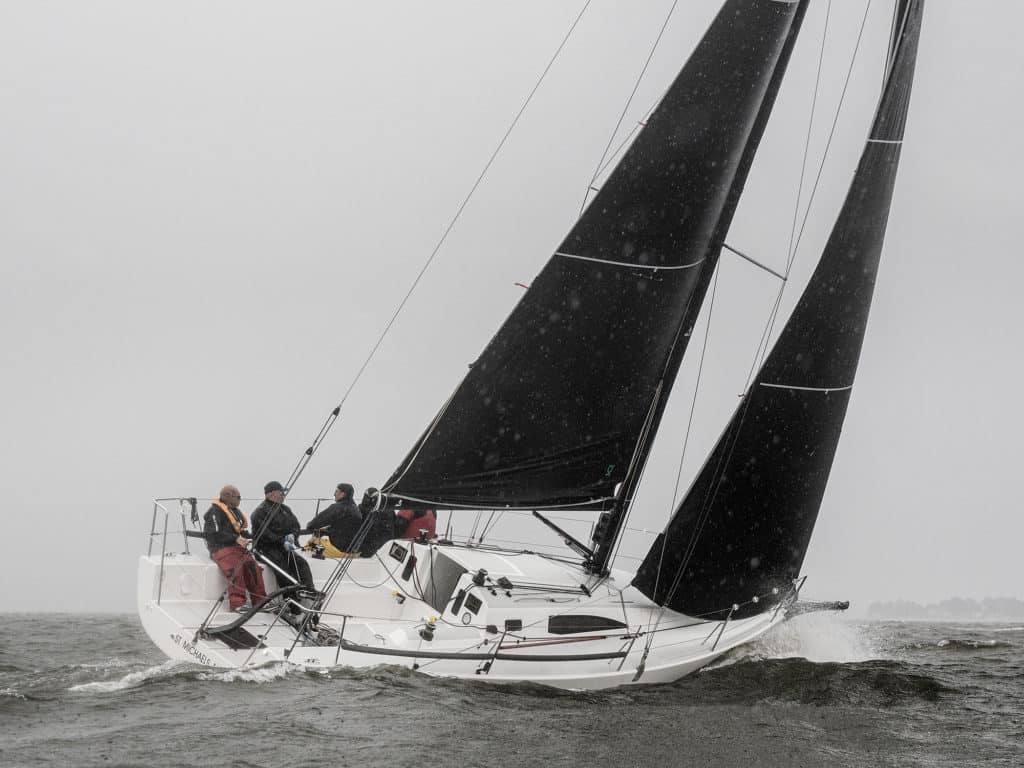
Beginning with the popular little J/24 way back in 1977, J/Boats has become famous for its steady introduction of terrific racing and cruising boats, almost all of which shared one main characteristic: They sailed like a witch. More than four decades later, having built more than 50 separate, mind-boggling models, the Johnstone family that designs, markets and sells the brand shows no signs of slowing down. Their latest offering, for 2020, was another fast and fun racer/cruiser: the 32-foot-7-inch J/99.
Read more about the J/99 »
- More: boty , coastal cruiser , new boats , Sailboats
- More Sailboats

Sailboat Preview: Elan GT6 Explorer

For Sale: 1984 Camper & Nicholsons 58

Alubat Updates OVNI Models

For Sale: Little Harbor 63 Ketch
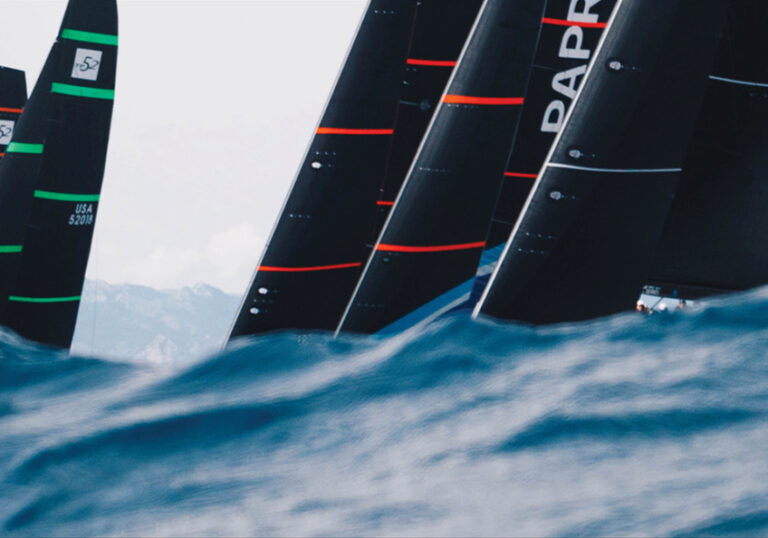
North Sails Parent Company Buys Doyle, Quantum
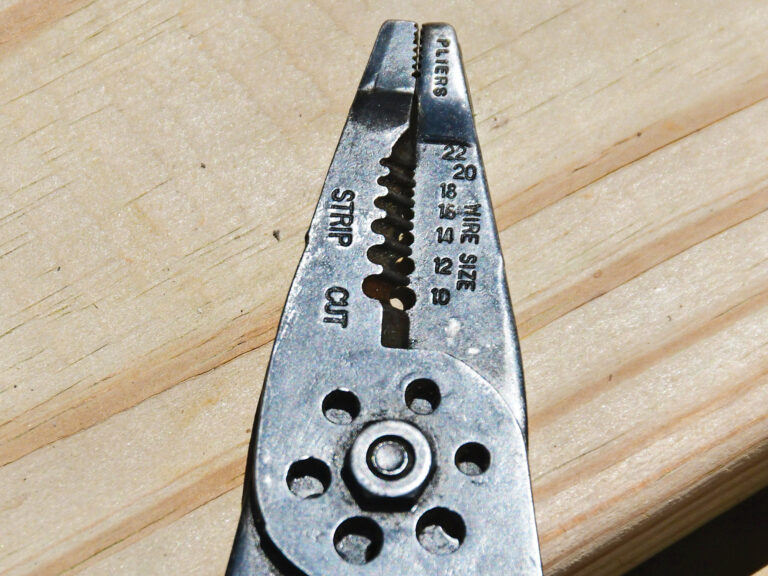
Top Tools for Sailboat Cruising: Must-Have Gear for 2024
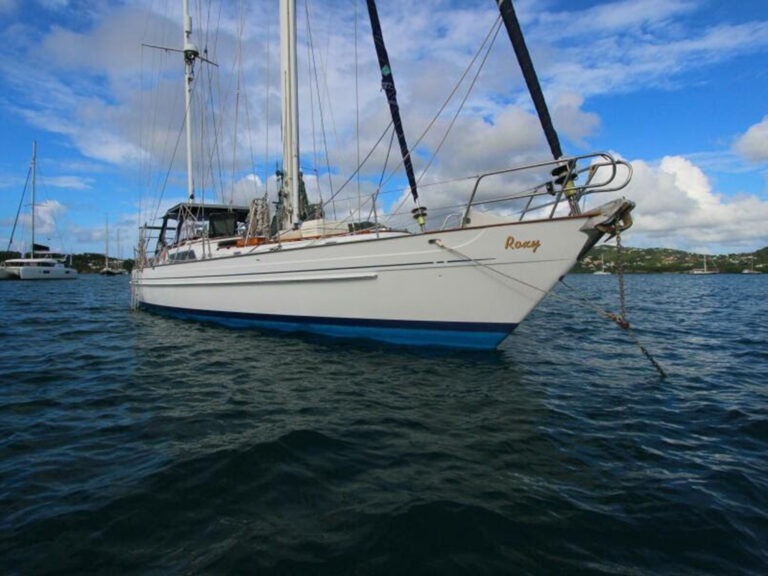
Sailing Avocet : A New Adventure Begins
- Digital Edition
- Customer Service
- Privacy Policy
- Terms of Use
- Email Newsletters
- Cruising World
- Sailing World
- Salt Water Sportsman
- Sport Fishing
- Wakeboarding
Weather Forecast
2:00 pm, 06/12: -11°C - Partly Cloudy
2:00 am, 07/12: -4°C - Clear
2:00 pm, 07/12: -7°C - Partly Cloudy
2:00 am, 08/12: -3°C - Overcast
- Cruising Compass
- Multihulls Today
- Advertising & Rates
- Author Guidelines

British Builder Southerly Yachts Saved by New Owners

Introducing the New Twin-Keel, Deck Saloon Sirius 40DS

New 2024 Bavaria C50 Tour with Yacht Broker Ian Van Tuyl

Annapolis Sailboat Show 2023: 19 New Multihulls Previewed

2023 Newport International Boat Show Starts Today

Notes From the Annapolis Sailboat Show 2022

Energy Afloat: Lithium, Solar and Wind Are the Perfect Combination

Anatomy of a Tragedy at Sea

What if a Sailboat Hits a Whale?!?

Update on the Bitter End Yacht Club, Virgin Gorda, BVI

Charter in Puerto Rico. Enjoy Amazing Food, Music and Culture

With Charter Season Ahead, What’s Up in the BVI?

AIS Mystery: Ships Displaced and Strangely Circling

Holiday Sales. Garmin Marine Stuff up to 20% Off
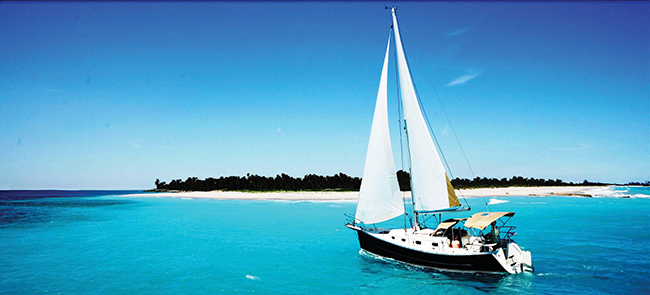
- Cruising News
Pocket Cruisers That Sail Far
It is not the size of your boat that matters, it is the size of your dreams (published June 2018)
Today’s cruising fleet is made up of boats that are much larger than they were only just a decade ago. There is a lot to be said for the comfort and speed of larger cruising boats. And with all of the modern sailing gear and electronics available to us, big boats are much easier to handle than they used to be. But they are also much more complicated and thus more prone to need maintenance and repairs than small, simpler boats of yore.
Small boat cruising now includes boats up to about 35 feet and it is worth noting that some of the largest builders of production sailboats have very few models in the 35 and under category that could be considered a boat you could live aboard. Smaller weekending boats and daysailers are more common in their range.
POCKET CRUISERS The term “pocket cruiser” was coined a generation ago to identify the many small but capable cruisers that were launched at the beginning of the fiberglass age of boat building. Boats like the Pearson Triton, Tartan 27 and Catalina 30 were all considered perfectly suitable boats for a family to cruise for a week or an entire summer.
The early fiberglass pocket cruisers were often designs based on hull shapes that had evolved from the days of wood construction so they had long overhangs, attached rudders and narrow beams. They were cramped and tended to heel over hard in a blow. If the leeward rail went under, you knew it was time to reef.

Today’s boats are designed to sail fairly upright and use beam and even chines to provide a lot of initial stability. Sailing flat is more comfortable for everyone onboard and is faster than pushing the boat too hard and burying the rail. It means the boats can be sailed efficiently without heavy crew on the rail which means a couple can still get great performance without having to bring the whole neighborhood along. Plus, because the deigns are quite light, you end of reefing early and often, which takes the sweat out of managing your pocket cruiser when the breeze picks up. Some companies will even offer in-mast furling on their smaller boats, and that simplifies sailing even more.

Catalina’s 315, built in Florida, is an American classic among the fleet of pocket cruiser. Light and powered with an ample rig, the boat sails very well and is a real pleasure to handle. Catalina continues to build “American Style” into their boats so you will find solid joinery below decks and a lot of traditional features that set them apart from the fleet. Details like solid wood doors and louvers on cabinets turn the little 31-footer into a properly fitted out yacht.

Seaward Yachts are also built in Florida and are part of the Island Packet company with was recently bought by Darrell and Leslie Allen. The Seaward 26 and 32 are unique boats with swing keels and kick-up rudders. The boats were designed in Florida for the shallows of Florida’s west coast and the Bahamas across the Gulf Stream and in those waters they are ideal. But, the designs have also proven popular in the Chesapeake Bay, Southern New England and the Great Lakes. The 26 is a roomy little weekender while the 32 is a cruising boat that can be your home for long cruises.
Germany has become a world leader in production boat building in the last decade and three companies–Hanse, Bavaria and Dehler–have small cruisers that are modern pocket cruisers. The Dehler 29 is one of the most popular racer-cruisers in Europe with large well-established fleets that get together to both race and cruise. The Dehler brand is not that well known in North America but the boats and the builder behind them are first class.
Hanse has quietly but steadily built a market for their boats in North America that now accounts for a significant slice of new boat sales. The Hanse 315 is a perfect little cruiser that is fast, easy to sail, roomy and affordable. It even has twin wheels. Hanse is a high volume builder but they do not skimp on materials, hardware and the quality of the workmanship.

The Tartan 101 and 115 started life under the C&C brand, which is also owned by Tartan. When the company decided to split off the C&C brand, they renamed and re-engineered the two designs to meet traditional Tartan style and construction. Both boats are fast racer-cruisers that have done well in fleets all around America. But, they are also great little cruising boats that will be the right combination of qualities for couples or family who want the best of both worlds.
NOTABLE SMALL BOAT VOYAGES Since the early days of yachts there have been many great adventures and cruises in pocket cruisers so it is fair to say that it is not the size of your boat that matters, it is the size of your dreams. Here are some of my favorites.

Also in the 50s, Englishman John Guzzwell succumbed to the call of the sea. With a modest budget, he built a 21-foot Laurent Giles design that he named Trekka and in this little boat he set off from his home in British Columbia around the world. In 1959, after many adventures and several years, he returned to B.C. as the youngest solo circumnavigator in the smallest vessel to sail around the world.

Also in the Seventies, Yves Gelinas set off on his Alberg 30, Jean-du-Sud , from St. Malo in France with the intention of sailing non-stop around the world via the five great southern Capes. While he had to make a stop to repair his mast, he finished his circumnavigation in Canada having sailed 28,000 miles alone. Gelinas is the inventor of the elegant and simple Cape Horn self-steering windvane and his prototype steered his boat around the world in all conditions.
In the Eighties, young Tanya Aebi convinced her father that instead of attending university she would get a much better education if she sailed solo around the world. Her father agreed and took the tuition money he had saved and bought her a 26 foot fiberglass Folkboat design named Varuna . Learning as she went, Tanya spent two years cruising around the world in the classic tradewind route via Panama and Suez. She returned to her home port in New York City to a hero’s welcome and her book, Maiden Voyage, remains a best seller 30 years later.

More recently, in 2011 and 2012, young Matt Rutherford sailed a borrowed, 27-foot Albin Vega sloop north from his home in Maryland to the Northwest Passage. His mission was to complete a non-stop circumnavigation of the America via the NW Passage and Cape Horn. The grueling and arduous adventures took him 10 months yet he prevailed. And along the way he raised $130,000 for a local Maryland charity.

He is currently, at age 75, sailing a Moore 24 racing boat around the world and has thus far got to Australia. It is his hope, he writes, to complete his sixth solo circumnavigation before he leaves this planet.
Author: Blue Water Sailing

Sail Far Live Free
Top 10 favorite affordable bluewater sailboats.
| CSY 33 |
| Shannon 28 s/v , completing a single handed transatlantic crossing |
| Valiant 32 |
| Welcome home (Fuji 35 cabin) |
| Alajuela 38 |
| Tayana 37 |
| A good look at Mariah 31's transom hung rudder |
| The Westsail 32's full keel means business (photo by ) |
| My kind of math: Baba 30 + tanbark sails = boat porn |
| So functional, so beautiful! |
| HC33t coming at you |
| HC33t sailing far, living free! |
- Blue Water on a Budget: 5 Budget Cruisers for Crossing Oceans
- Go Small and Go Now: 5 Pocket Cruisers to Take you Anywhere
- A Proper StinkPot: Top 5 Pilothouse Motorsailers
- The Voyager's Handbook: The Essential Guide to Blue Water Cruising by Beth Leonard
- How to Sail Around the World: Advice and Ideas for Voyaging Under Sail by Hal Roth
- Twenty Small Boats to Take You Anywhere by John Vigor
Great post... Most of these boats are slow for their waterlines and, for me at least, speed is a factor in safe passagemaking due to the ability to avoid and dodge weather. I want the ability to easily make 7+ knots in all conditions. (I don't take this as a compromise to seakeeping.) One quirk of the HC33: The teak decks were fastened from the bottom up (e.g. through the deck) and the heads were then glassed over. (Not joking.) The tips of the screws pricking your feet is the first clue your decks need replacing. From my dock neighbors entire summer (3 full days per week) this is a truly massive problem to fix and delayed their cruising dream by a year.
timone - Great comments, thanks! I agree, there's a definate choice to make between speed and tank-like toughness. My personal preference for bluewater is a a heavy full keeler, though this may change with experience. Maybe I'm too wrapped up in the asthetics of these classic designs. Good tip on the HC33. I'm leary of teak decks on any boat due to maintenance issues and would prefer any of the above boats without teak decks.
You are on to something with these large dispacement boats. power or sail . they are the best
Semi-bunk. We sailed a Cal 40 all over the SoPac; not the ideal cruiser but certainly seaworthy. Most of our class of 2008 were fin keel, and some form of spade rudder. With the exception of the Valiant and the Tayana, most of these clunkers are better suited to the dock.
Our family sailed the East Coast and Caribbean for two years and I loved our Lord Nelson's teak decks. The teak is first to dry after the morning dew. A small leak disappeared as it swelled in the warm humid tropical weather.
To me to "dodge weather" when you are in the mid of an ocean has little meaning, unless you have a really fast boast like those racers who do the Volvo ocean race. If you are short handed a slow boat will give you a better chance to rest during a storm, which is paramount for safety, while the fast one will wear you out.
A massive...and very expensive problem to fix.
Even ocean racers get caught at sea in bad weather and more the a few have capsized and demasted. No sail boat can outrun the weather. Even motor yachts with huge Diesel engines that can motor at 20-30knots get caught at seas in bad weather. And many times sailing away from shore and weathering the storm at sea is safer then trying to enter a harbor once the blow is there. Many inlets are risky when the current and winds create breaking waves that can swamp a small craft or force it on to the rocky shore attempting to enter. There are times going further away from shore is safer then attempting entry into the harbor. Having a boat that will ride out a storm safely is worth losing a few knots on passage.
Great list! Not sure the HC33 meets your $50k criteria though. I have yet to see it under $75k in decent condition.
Hahn - True enough, finding a HC33t for $50k is a difficult proposition. But the boat is s so beautiful and so well made that I had to include it, even if finding a good one may mean spending $25k more.
Yes the Baba 30 would fit the Boat Porn listing ! I'll tell my wife that's what I'm doing as I sit with blurry vision @ 2am ! Looking at Porn !!
Agreed, the Baba 30 is really beauty. The canoe stern is perfectly in proportion with the rest of the boat and makes for a really sweet profile.
Our good friend has a HC33 and we have a W32. Its amazing how close they are in sailing ability. I think the W32 tracks a tad better and the HC33 is just a hint more nimble, but they are very close in our limited experience. We really love the HC33's pullman berth in the center of the boat but at the same time we don't enjoy the forward head nor do we like the table layout on the HC33 which requires a lot of people to get up if the person furthest in the booth needs to get out. Its a toss up between the HC33 and W32 about interior layout overall. We love the little quarter berth "room" in the HC33 but at the same time you sacrifice a lot of space in the engine room. The W32 gives you a lot better access to the motor. If push came to shove, I'd take the HC33's extra berth instead of the berth in the center of the W32 factory layout. The cockpits are very close in size (read:small). The HC33 has a rounded cabin top that makes sitting on the edges of it more of a pain, but the W32 requires drop boards or water will run into the cockpit. The W32 does win in price competition though. No comparison there. Just wanted to add some thoughts to your post.
Great comments, thanks for sharing Tate. It's always good to hear from someone who has hands-on, side-by-side comparison experience. I agree the forward head on the HC33 isn't ideal, but I do like that it has a stall shower. If price isn't an issue, maybe the real way to decide between the W32 and the HC33 is the size of the crew. The W32 might be the choice for 2, while the HC33 might be better for 3-4 based on having two private sleeping quarters.
Downeaster 32' is a clear contender here, and also wins as most beautiful ;-D and very stable. Also possibly the largest interior per length? Great head room.
Agreed, the Downeaster is a real looker and a lot of boat for 32 feet, particularly given their value pricing on the used market.
I owned a Downeast32. Roomy yes,slow?, yes! Very slow. Had 7 people on her for an overnighter. Storage everywhere. Lots of rear deck space.
I wouldn't say the Downeaster 32 is merely a contender, but possibly an outright winner in the category of "Affordable Bluewater Sailboats",.. ,much more so in fact than 10 boats mentioned in this article,.. at least from the prices I've seen. I honestly don't understand why something like HC33 even gets a mention,.. beautiful? definitely!!!,.. but affordable??!!,, hmm,. not so much.
Fair enough. I included the HC33 because it's one of my all time favorites and the definition of "affordable" is subjective. As I've defined it here, ~$50k. Yes, that's a stretch for the HC33, but I've seen a few approaching that price point. As for the DE32, she's a capable beauty too.
No mention of the Nor'Sea 27.... Should be on the list for sure. :)
I didn't include the Nor'Sea 27 here, but it is in my list of favorite pocket cruisers to take you anywhere .
Hello, I appropriate your reviews. Our family own CSY-33. Now a day, sailing is a completely new sport for me and I wasn't sure what to expect but I've definitely got the bug. thanks all, @Nadia Brightman :)
Glad to hear you're enjoying your CSY 33!
My wife is 5'9" and I 6'3". Which of these wonderful boats would have sufficient headroom and a nice sleeping double for a couple like us?
This is a great post. I just restored a little Hunter 25 and plan to sell it to get something bigger. It's nice to dream! I second the comment about the Downeaster. I love double enders and clipper bows. How about a Bayfield!
Thanks Dan. I like Bayfields (and other Ted Gozzard designs) too, but they're outside my top 10. Thanks for reading.
Bluewater Offshore Cruising Sailboat Bluewater Cruiser New French-built cruiser with a distinctly American look. Here’s an interesting design from Group Finot for Beneteau. I find interesting the fact that this design is not especially “Euro” in its styling. In fact, it’s sort of American looking and good looking too. So, let’s examine this profile in detail. The transom is traditionally raked as opposed to reversed. This eliminates the standard swim step we see so often. But Beneteau has countered this with a drop-down platform that extends about a foot beyond the transom. This platform is raised and lowered by block and tackle. A sliding flush-deck hatch covers the steps when they are not in use. This is an elaborate and very well thought out transom detail that will allow you to bring your dinghy up next to the boat without threatening the gelcoat on the transom edge. This traditionally raked transom really drives the look of this boat. It certainly affects the character of the sheer. I would have liked to see a bolder sweep to this sheer, but it’s fine as is. Note how the tip of the transom is at the waterline. This, combined with the short bow overhang, produces a long sailing length. I think the designers have done a good job of blending the deck structures with the hull. The D/L of this design is 183. L/B is 3.38, making this a moderately beamy boat on the lighter side of medium displacement if we choose 200 to be the middle of current D/Ls for cruising boats. The keel is a bulbed fin giving 5 feet, 11 inches of draft. Note the deep forefoot on this design and the straight line to the canoe body profile. All in all this is a handsome and moderate hull. The interior shows a two-head, two-stateroom layout with the galley in the passageway to the aft cabin. The galley is spread out fore and aft, but it looks to me like there is still plenty of working room. The aft cabin has a large double berth and symmetrically arranged lockers and settees. Why settees? Well, they look good and occupy volume that is not much good for anything else due to the shape of the hull. There is a head with shower stall adjoining the aft cabin. The saloon has a dinette, which to my eye looks on the minimal side. I suppose you could seat four for dinner if you had to, but it would be a tight squeeze. The forward stateroom has a double berth with the toe end cut away to make room for the forward head. I’m not sure how this berth would work for a couple. Obviously, the biggest advantage to center-cockpit boats is the separation of the sleeping accommodations. There is space below the cockpit for the engine room. Putting the cockpit in the middle of the boat allows the designer to place the mainsheet traveler at the end of the boom and place the traveler where it will not interfere with the cockpit layout. This rig is well forward and shows swept spreaders with forward lower shrouds. Unfortunately, the sailplan we have is not carefully drafted so it doesn’t do much for the look of the boat. The photos also show a staysail. This is a very nice looking boat. The windshield is fixed and, while obtrusive in the drawing, looks just fine in the photos. I’m not too keen on the wheel position. It is a bulkhead-mounted wheel offset to starboard, much like we see on cruising catamarans. This means you will sit in one position at the wheel without the benefit of being able to turn 90 degrees or change sides. This wheel arrangement does free up the rest of the cockpit and puts the helmsman securely under the dodger. A teak-capped bulwark adds a rich look to the deck. Beneteau’s boats always deserve a close look. The company obviously puts a lot of market research into its new models. In this case the company has given us a well-designed boat with some unusual features. This is one boat I’ll definitely board Beneteau Wave Rider 42CC at Annapolis.
I wonder if the keel will stay attached
I've saled from the Med to Australia on my own Beneteau Oceanis 42cc and plan to continue the circumnavigation via cape Town to the Caribbean in April 2015. We love our Bene layout... Fun to sail . The center cockpit is Ideal. The aft deck spacious and the aft cabin just wonderful. A huge engine room accommodates all our gear.water maker. Genset. Tools....
Hey, I think a strong case could be made for Bayfield 32 cutters, beautiful boats and pretty bullet proof as well. speed is a bit of an issue! great post!
I single-handed a Bruce Roberts 31 (schooner-rigged) across the Atlantic and back . I was 70 yrs.old, the boat did the work. Also, list the Dreadnought 32 (Tahiti ketch in heavy fg).
I'm intrigued by many of the Roberts designs and metal boats in general, but I don't have any experience with either. The Dreadnought is another really cool and unique double-ender with a lot of character...often available for a bargain price. Thanks for sharing.
Yeah how about some feedback on the Alberg's. They seem worthy & affordable too. Please respond, thx. L
My first true-love in sailboats was the Pearson Triton 28, of course designed by Carl Alberg. As my experience and taste evolved, I began to prefer canoe sterns and slightly more modern designs. The biggest fault I can find with Alberg designs is that many seem to have very narrow beams, making them tight for family cruising. The narrow beams can also contribute to a tender boat. However, Alberg did a fine job of making his designs very sexy with swoopy sheerlines and long overhangs. The Triton, 35 and 37 are all capable and proven offshore boats.
The HC33 shown, Sabbatical. is for sale @ $95,000. Ouch.
Agreed, that's a steep price. I've seen 2 33t's that needed a little TLC sell near $50k. In general, the HC 33t probably has the highest average price of any in my list, but its' such a sweet ride!
You forgot the Allied Seawind 32 for $25,000
Good call! The Seawind II (32') is but one of several Gillmer designs worthy of any "best affordable bluewater cruisers" list. Others include the Southern Cross 28/31/35, Weatherly 32, Aries 32 and Roughwater 32. Perhaps it's time I write a sequel to this post to include the many good recommendations from the comments. Note - I did include the Southern Cross 28 in my post called "Bluewater on a Budget: 5 Budget Cruisers for Crossing Oceans."
there is one you may have over looked! tanzer 10.5 pilot house! not the fastest but with it's swing keel it is a fun wide nice sailing boat!! and great for the island's
I like the Tanzer 10.5, but is she bluewater capable? Definitely a unique look, in a good way. And Tanzer has a good reputation for affordable quality and decent sailing performance.
This is almost the identical boat to a Southerly 10.5 which has made many ocean crossings. Definitely bluewater capable. I own hull # 11 built in 1983 and she has sailed completely around the world spending a lot of time in the South Pacific. She has a righting angle of 140 degrees with the lifting keel up. The hull to deck joint is glassed over on the inside during production resulting in a absolutely solid boat with no joint leaks. The amount of storage is phenomenal for those long passages. I have had her out in 50 knots with no issues. The self tending jib makes single handing easy, and with the keel down to 6.5 feet she handles well.
Could an old Irwin 37 MK I be upgraded so she can be blue water capable? If so...HOW?
I suppose anything COULD be upgraded to bluewater capable, but at what cost? The I37 is known for it's roominess and affordability, but not necessarily offshore capability or robust construction. Irwin's can be fine boats (I owned one for 5 years), but they would not be my choice for bluewater. If you're simply considering passage from Florida to the Bahamas, or some island hopping in the Caribbean, then there are plenty of Irwin's with that under their belt, but an ocean crossing or a run to Bermuda in an I37 should be carefully considered. For more info and specifics about the I37, try Jack Horner's review here: http://www.boatus.com/boatreviews/sail/Irwin37.asp
What about the Irwin 42 Ketch? Is it what you would consider blue water worthy?
What, no mention of the Bill Garden designed Fast Passage 39?
Love the Fast Passage 39 and Garden's original s/v Bolero! Thanks for the addition.
Aah there I am trying hard to decide which one to choose........except I couldn't afford even a model version! So I content myself by saying that at nearly 60 and with no experience wòrth talking about I'm way to old to start now. Youtube and some of the wonderful sailing videos help a bit!
Tashiba 31 is heavy duty double ender good for ocean crossings don't you think? I like the cutaway forefoot.
One of Bob Perry's personal favorite designs, or at least he thinks highly of it. It's also one of his last full keel designs. “I think the Tashiba 31 and 36 mark the best boats I ever designed with modified full keels. The boats were fast, close-winded, stiff, and well balanced. I constantly got calls from owners telling me how they had “beat” a local contemporary design.” (from Yacht Design According to Perry).
Why no mention of the Cabo Rico 34?
James - The Cabo Rico 34 is certainly worthy of this list. In fact, so is the Tiburon 36, the first boat built by Cabo Rico and perhaps a bit more affordable than the 34. The Tiburon is a Crealock design and eventually became the CR 38. Thanks for the addition!
Another good boat is the Gulf 32. Solid build, good tankage, though at this age the 75 gal fuel tank needs serious inspection. William Garden feels it is one of his finest, safest designs!
A boat that is not so well known in European and N.American circles is the Oswald Berckemeyer designed Miura 32.Built strong to cope with South African waters it has been said (though I am not sure how true) that more circumnavigations have been carried out in Miura's than any other class of boat.I owned a Corrida which is the 36foot version of the boat (also designed by Berckemeyer) and I took this boat across the Atlantic without a worry. Strong and fast - I loved that boat.
Hi Mike. I am trying to find drawings, specs and photos of the Corrida 36. Very little available online. Can you point me to anything you are aware of? Thanks.
Did any one mention a DownEast 32? They may be fat and slow, but so is the WestSail 32. Any one agree / dissagree?
Hey I did a post at Urban Nomads about your excellent blog. Check it out here: http://urban-nomads.net/great-boat-living-websites. Thanks for the helpful tips!
The Southern Cross 31 / 35 / 39 really should be on this list. Excellent heavy displacement boats that will take you anywhere.
Agreed. I'm a fan of Southern Cross sailboats and Gilmer designs.
What is your position on an Island Packet 320?
I've never sailed a 320, but I do like IP's in general for their salty style, solid construction and seaworthiness. I particularly like the 320's rig - a cutter is nice for having headsail options and the Hoyt staysail boom keeps things simple. IP's tend to command an upper tier price and aren't known for speed, but if you can get beyond those two factors, the 320 looks to be a nice size and layout for a cruiser.
I love your list. Mine would be very similar, but might include the Endeavour 37. It's hard to beat the price!
I sailed our HC 33 from Alaska to New Zealand on a 5-year cruise. We loved how she handled in heavy weather. We are in the 50+knot "club" and our HC did great while other cruisers suffered dearly. While she isn't fast, she tracked well, and behaved at anchor or hove to. Yes, the teak deck is something to consider, but overall, not a deal breaker in the big picture of off-shore cruising. We sold our HC in New Zealand because I had to return to work. I miss her every day. I am plotting to get another bluewater boat. At this point my short list is another HC or perhaps an Island Packet or Pacific Seacraft. If I were rich, it would be a Najad. These choices are based on our years sailing with other cruisers. While boats are so incredibly expensive, the bottom line is safety at sea, getting parts in exotic locations, and the cost of repairs. The better you are equipped before leaving home port, the less likely you are to have life-threatening problems or serious repairs in expensive locations.
You missed Acapulco 40, so likely never read "One Wave at a Time" by Ed Atkin - regards, Matt
Thanks for the kind word for the Fugi 35. Here's one you can have for under $50k. Needs a little work but is a great boat. miami.craigslist.org/mdc/boa/d/classicblue-water-passage/6479457885.html
I don't see Corbin 39
Thank you for the article it has given me information on my up coming purchase I'm working towards living aboard my own sailboat as I travel the East Coast, Caribbean, South America and West Coast in my retirement years.
I understand this is US based but as a Brit I used to covet the Tradewind 35, a proper long keel, flush decked, cutter rig, blue water cruiser. If money was no object that is the boat for me.
Post a Comment
Popular posts from this blog, go small and go now 5 pocket cruisers to take you anywhere.

Escape to the Sea: How to get from the Great Lakes to the Caribbean

- Skip to primary navigation
- Skip to main content
- Skip to primary sidebar
- Skip to footer
Yacht Cruising Lifestyle
Everything fun you can do from your yacht
20 Bluewater Cruising Sailboats Under $100,000
January 5, 2021 by Travis Turgeon 2 Comments
Choosing the right bluewater yacht for your needs requires a ton of research. With so many designs and features available, it can be overwhelming trying to narrow down your options. The process gets even more complicated when you begin to consider the personal opinions of other sailors.
So how do you know where to start? Every person’s definition of comfortability will vary when it comes to onboard living. What suits a family of four won’t necessarily suit a couple or a single-handed sailor. Your budget, style, and needs are all unique to you and your situation, so it’s essential to know just what to look for when buying a new or used vessel .
To start you off in the right direction, we put together a list of our top choices for bluewater cruising yachts under $100,000.
Allied Princess 36
Built as a long-keel ketch or cutter, the Allied Princess 36 was in production from 1972 to 1982. Around 140 vessels were manufactured in total, so you can occasionally find them on the used market.
While these cruisers’ design and construction are considered sufficient, the excessive use of fiberglass makes the design a bit bland. Although they may not have the most appealing design, these bluewater yachts certainly tick a lot of boxes.
With the full-keel measuring just four-foot six inches, it’s a design that holds steady on its course without pointing as high as a fin-keel design.
Overall, the Allied Princess 36 is a wonderful option for bluewater sailing.
Prices range between $30,000 and $60,000.
Cabo Rico 38
The Cabo Rico 38 is at the top of its class, constructed with a long-keel cutter rig design that gives it outstanding bluewater capabilities for its price point. The vessel was produced in two models – Pilothouse, and Trunk Cabin – although the Pilothouse design is less common.
Cabo Rico i s consistently successful with it s 38 models, and t hey remain one of the most prominent cruising boats on the water.
Internally, this boat has various features required for a bluewater cruiser: Large water and fuel tanks, a solid design with balsa wood cores for thermal and noise insulation, and an overall seaworthy design.
While this boat wasn’t m eant to win races, it is a fantastic choice for a crui sing vessel.
Prices range between $30,000 and $80,000.
Celestial 48
The Celestial 48 is the largest boat on our list and is commonly sought after by the cruising fraternity. The problem is, these vessels are scarce on the used market.
The Celestial 48 is a ketch rig with a shoal-draft, fin-keel design, and a center-cockpit configuration that is comfortable and ideal for bluewater sailing. One of our favorite features is the six-foot, two-inch headroom in the cabin, along with high-capacity water and fuel tanks.
The Celestial 48 was built in China by the Xiamen boatyard, although it’s no longer in production.
If you can find one, the Celestial 48 will make an excellent bluewater cruiser.
Prices start near our $100,000 mark.
The Corbin 39 is manufactured in two designs, aft or center cockpit. Designed and built in Canada by Robert Dufour and Marius Corbin, the 39 is now (sadly) out of production. This cruiser remains a favorite of many and is still commonly searched for on the used market.
One thing to note is that most of the boats were sold as unfinished kits, leaving owners to complete the interiors themselves. For this reason, the standard of interior design finish will vary, so it’s worth checking and comparing with other vessels carefully.
When found, the Corbin 39’s present a very reasonable price tag, but a full survey is essential.
Prices range between $40,000 and $60,000.
The Freedom 36 is one of the smaller yachts on our list, but it has an exciting design that attracts cruisers. The wide beam and long waterline design allow for a much larger interior than most other boats of similar length. As a cruiser, space is a top priority, so this cruiser should be on your list of considerations.
A unique feature of this Freedom yacht is the stayless carbon fiber mast. It looks a little odd for most, with no forestay or backstay and a mast that flexes alarmingly in the wind. It’s a proven design, though, and gives clean lines just like an aircraft wing.
The Freedom 36 is certainly an exciting cruiser to keep an eye on.
Prices range between $40,000 and $80,000.
Gulfstar 44
Known as a capable cruiser or live-aboard boat, the Gulfstar 44 is a spacious yacht that can take you around the world.
Designed with a fin-keel and skeg-rudder, the Gulfstar is comfortable and well built.
Internally, you’ll find a large galley, king-size aft cabin, and spacious fore cabin, with ample room in the saloon. Earlier Gulfstar vessels suffered from inconsistent build quality, but from around 1976 onwards, the company made huge improvements.
For a spacious bluewater sailboat with excellent heavy-weather handling characteristics, the Gulfstar 44 is a great choice.
Prices start around $60,000.
Hans Christian 38
If you’re considering cruising the world in a bluewater yacht, then the Hans Christian 38-T should be added to your shortlist of candidates.
With a full-length keel design and laden with solid teak, this boat weighs in at 12.5 tons, making it a heavy displacement vessel that you can rely on to take you through some of the harshest conditions.
Manufactured in Taiwan, these cruisers can be a chore to acquire. One of the most common downfalls of the Hans 38-T is electrical problems, so be sure to get the wiring checked out by a professional.
Outside of electrical issues, this boat is a proven winner in the cruising world.
Prices start around $70,000 but expect to pay well over $100,000 for the more admirable models.
Hinckley Bermuda 40
The Hinckley Bermuda 40 was in production for over 30 years, from 1959 until 1991, but only 203 boats were manufactured in total. Many Bermuda 40s were used as racing vessels throughout their production, winning the Northern Ocean Racing Trophy in 1964.
The design also gained many admirers in the cruising world thanks to the long keel and centerboard, which allows the boat to maneuver through shallow waters. The Hinckley Bermuda 40 is hard to beat for versatility, combining classic looks with the shallow draught and generous interior space.
Early models from the 60s and 70s start around $80,000, but later models land well above our $100,000 threshold.
Island Packet 35
Although only in production for six years, 178 Island Packet 35s made their way onto the market. These vessels have become justifiably popular with coastal cruisers and bluewater sailors alike.
These cruisers are available in two designs; long-keel or long-keel with centerboard – both of which come with cutter rigging.
The design is conservative and built for comfort rather than speed. Inside space is very generous, with a 12-foot beam, a v-berth cabin in the forepeak, and a double cabin on the aft port side.
Island Packet 35’s appear on the used market regularly, so locating one shouldn’t be too much of a hassle.
Prices start at around $65,000.
The Niagara 35 is a popular cruiser available in two exciting models, each one coming with a fantastic interior design.
The original model features a center galley and marine toilet that separates the fore and aft areas. The saloon is completely closed off, making it useful during extended passage journeys.
The later model has a double-berth forward, separated from the saloon by the head and shower. Both models include a spacious cockpit design. Through its 12 years of production, 260 Niagara 35’s went on the market – so you can regularly find them for sale.
Early models start around $30,000, with later models coming in closer to $70,000.
Only 32 of the Robert Perry-designed Nordic 40s went through production, making them exclusive and difficult to find. If you do manage to get your hands on one, however, you won’t be disappointed.
The fin-keel and skeg-mounted rudder design allow for up to six people to stay comfortably, including extra storage space for luggage and provisions.
The Perry design is recognized for the quality of its fittings, including rod-rigging and full hull insulation on early models. After 1987, they cut back on a few design features, but it’s still a quality boat.
If you can manage to find a Nordic 40, it will make an excellent investment.
While it may be rare to find one below our $100,000 mark, it is possible.
Passport 40
Built in Taiwan, the Passport 40 is another excellent design by Robert Perry. Sporting a fin-keel and a skeg-mounted rudder, the design is known for its well-balanced performance.
Originally supplied with a sloop-rig, the majority have an inner stay, fitted to allow a double headsail. This cutter-style rig makes the Passport 40 even more suitable for ocean crossings.
The interiors are well designed – as you’d expect from a Robert Perry – and make for comfortable living during long passages.
Peterson 44
The Peterson 44 was designed and built as a performance cruiser, combining sufficient speed and sea-kindly handling.
A low center-cockpit, 10,000 pounds of lead ballast, and a long fin keel allow this vessel to take turbulent conditions in stride without sacrificing the crew’s comfort.
Internally, there is plenty of space in the well-designed cabin. For long passages, there’s a 132-gallon water tank and a 117-gallon fuel tank.
Finding a Peterson 44 may be your only problem. They manufactured about 200 boats, but owners rarely like to part with them – adding to their intrigue and value.
Prices for these yachts vary widely. Expect to pick up an older model between $50,000 and $75,000.

Prout Snowgoose 37
As the only catamaran on our list, the Prout Snowgoose 37 is a proven boat for circumnavigation on the bluewater trail.
A standout feature of the early Snowgoose models is its narrow beam, which allows them to navigate canals easily. These boats are popular in Europe and are common on the journey between Spain and France on the Mediterranian. Additionally, the Prout Snowgoose 37 can fit into a single-hull marina, reducing berthing costs when compared to most other catamarans.
If you have never considered a catamaran in the past, the Prout Snowgoose 37 may change your mind.
Prices start near $45,000, with later models reaching over $100,000.
The Shannon 38 comes in two styles, with either an aft cockpit or pilothouse. Shannon Yachts are known for their build quality and attention to detail, and the 38 is no exception. The boat is available as either a ketch or cutter rig, but it’s renowned for its performance at sea in both forms.
Only 100 were built, with the final boat launched in 1988. If you can find one on the used market, it will make a competent bluewater cruiser.
Prices start at $40,000 for older models, with newer models inching closer to our $100,000 mark.
Only 80 of the Tartan 41s were manufactured, although they produced a similar Tartan 43 with the same molds. It is a fin keel design, with a skeg-mounted rudder and sloop-rigging. In its day, it was considered a fast cruiser, but now they’re mostly made for comfort.
If you’re looking at a Tartan 41, check out the keel dimensions. The keel was undersized on earlier models, which caused heavy-weather steering issues. The boatyard redesigned the later models, and some retrofitting has been done on the originals.
Prices start around $45,000 and reach upwards of $70,000.
No list of bluewater sailboats would be complete without the Tayana 37. It’s a beautiful boat designed by Robert Perry that comes in three variants; cutter, ketch, and pilothouse.
Built to compete against the popular Westsail 32, the 37 became a good seller – with almost 600 launched to date. Today, they are manufactured in limited numbers, as the traditional teak-heavy design is now less popular.
If you can find a good Tayana 37, cruising the oceans will be a pleasure in this sturdy and robust vessel.
Early models cost around $45,000, with newer or retrofitted models topping $75,000.
Another boat designed by Robert Perry, the Valiant 40 is one of the most sought-after bluewater cruisers on the used market. By the end of production, two manufacturers were able to put out around 200 boats, so it’s certainly possible to get your hands on one.
With a fin keel, reasonably heavy displacement, and solid build, open ocean cruising is made comfortable in the Valiant 40.
The Valiant’s trademark is the canoe stern, something Perry has carried over into many of his designs. The boat’s performance sets it apart from the more traditional heavy-cruisers, and it still has many admirers.
Expect to pay upwards of $45,000 for an early Valiant, but well-maintained vessels will command much higher prices.
Wauquiez Pretorien 35
When the weather gets rough, most people prefer bigger, heavier cruisers. Small boats generally don’t perform as well in harsh conditions, but the Pretorien 35 is an exception.
Built to IOR specifications, it’s a short, wide-beam design, with a ballast in the keel that makes up half of the displacement. It may be disappointing in light winds, but as the breeze picks up, the Pretorien comes alive.
Wauquiez built boats are known for their quality finish, so you shouldn’t hold any doubts when buying a used Pretorien.
Prices start around $39,000.
Westsail 32
At just 32 feet, the Westsail might be a surprising inclusion on our list. However, the design has proven itself many times over and remains popular with many cruisers.
With a long keel, transom-mounted rudder, and heavy displacement, these are seaworthy yachts.
The flipside to this is that the performance can be underwhelming. The Westsails are known for being slow, safe boats that will get you wherever you need to go – making them perfect for leisurely cruising.
Over 800 vessels entered the market between 1971 and 1981, so there should be plenty available if you look hard enough. The other point to remember is that they sold them as owner-completion kits, so the internal fitments, in particular, will vary in quality.
With so many available, the prices remain reasonable – with an early Westsail 32 fetching around $29,000 and well-maintained older models coming in closer to $50,000.
Remember: When buying a bluewater cruising yacht for less than $100,000, compromise is inevitable.
If you’re looking for a seaworthy, heavy-displacement design, you’ll have to compromise on the boat’s age. Choosing a modern, light design will allow you more for your money.
The best advice for buying a boat is to be truly honest with yourself by defining your needs and separating them from your desires.
Want to join the community at #BoatLife? Get a conversation started on our new forum by leaving a question or comment!
If you found this article helpful, please leave a comment below, share it on social media, and subscribe to our email list.
For direct questions and comments, shoot me an email at [email protected]
Sharing is caring!
Reader Interactions
November 15, 2021 at 6:30 pm
You guys didn’t mention Cape dory or pacific seacraft. How long have you been sailing?
February 18, 2022 at 1:37 pm
Very nicely done. There will always be people who disagree with your list but they reserve the right to comment without creating any value which is what you provided. Thanks for putting this together.
Leave a Reply Cancel reply
Your email address will not be published. Required fields are marked *
Save my name, email, and website in this browser for the next time I comment.
MB #20512 PO BOX 480 Sevenoaks Kent TN13 9JY
Tel: +44 56 0386 9163
Keep In Touch
Thank you for reading.
Join our online crew and find more about the #boatlife

My Cruiser Life Magazine
17 Best Sailboats to Live On + What You Should Know First
Many dream of living aboard a sailboat, but finding the right one can be daunting. There are many different types, and countless manufacturers have come and gone over the years.
Here’s a list of 17 options – a sailboat for every sailor on every kind of budget.
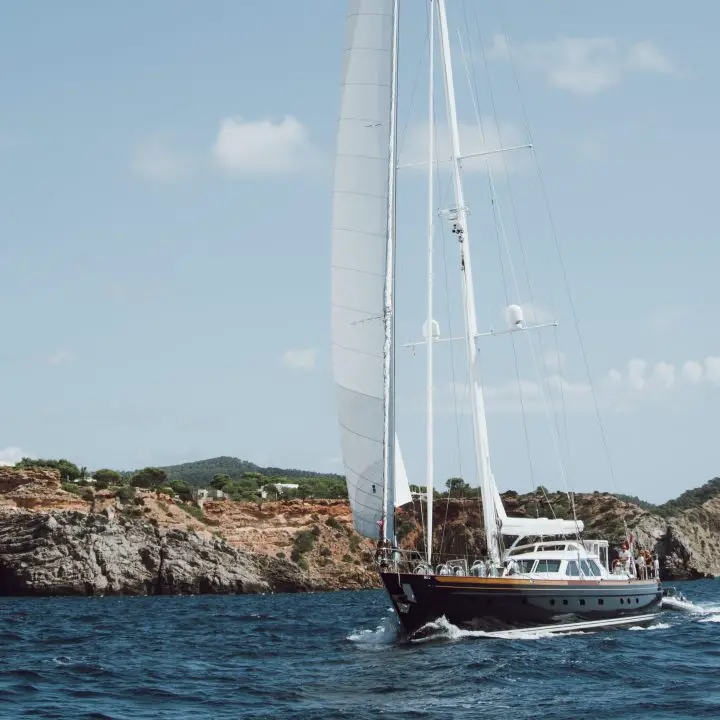
Table of Contents
17 best sailboats to live on, pros of living aboard a sailboat, cons of boat life.
- Find Your Type of Boat
Set Your Boat Budget
What size boat to pick, best liveaboard sailboats under 35 feet (< 35 feet), best liveaboard sailboats under 40 feet (35–40 feet), best liveaboard sailboats under 45 feet (40–45 feet), best liveaboard sailboats under 50 feet (45–50 feet), best liveaboard sailboats under 60 feet (50–60 feet), want to live on a sailboat, best sailboats to live on faqs.
- Catalina 34/35
- Panda/Baba 35, Tashiba 36a
- Gemini 105MC
- Islander Freeport 36
- Passport 40
- Jeanneau Sun Odyssey 42DS
- Leopard 42/43
- Beneteau Oceanis 473
- Hallberg Rassy 46/48
- Leopard 46/Moorings
- Amel Super Maramu 2000
- Privilege 585
What to Know First
So, boat shopping is a challenge, to say the least. Understanding where to start and what to look for comes down to understanding what you want to do with your boat.
Here’s a look at some pros and cons of living aboard to get you started.
- Seaside living at a fraction of the cost of a waterfront home
- Ability to travel anywhere by water
- Ability to move anytime—not tied to one location/town
- Different liveaboard lifestyle options to choose from: at a dock, mooring, anchoring, cruising (traveling)—tired of one, mix it up for a different experience
- Small living space lacks storage and privacy
- Limited resources: you must meter your fuel, water, and electricity use when not at a dock
- More exposed to the elements and more affected by weather events
- Seating and furnishings are less comfortable than in a house
- Constant maintenance to keep the boat seaworthy and clean
How to Find the Best Boat to Live on Year Round
At first, you might think boat shopping is like looking for a new car. But when shopping for a car, you have a small pool of manufacturers and models to choose from. In the end, you might have five choices and already have an opinion about each maker’s quality and reputation.
Boats are different. We’re usually shopping for boats that are a decade or more old. The manufacturers may have gone out of business years ago. When you total up all the possible makes and models of each type of boat, you might have dozens of choices with brands you’ve never heard of. Yikes!
Find Your Type of Boat
There are dozens of types of boats you could live on, depending on where you want to live and where you want to take it. Most people shopping for a sailboat will choose between coastal cruisers, bluewater boats, and sailing catamarans.
Here are some of the pros and cons of these sailboat types.
The Coastal Cruiser
- Inexpensive compared to bluewater and catamarans
- Perfect for dock living or near-shore hops
- With modifications and the right outfitting, many have island-hopped the Caribbean
- Many to choose from, and often they are lightly used
- Designs are often race-inspired and faster than typical heavy bluewater boats
- Newer, bigger boat for your money
- Often production boats have low-quality, lightweight builds
Related: Best Trailerable Sailboats
The Bluewater Sailboat
- The best bluewater cruising sailboats are capable of going anywhere
- Built to last and take anything
- Give the most comfortable ride in rough conditions
- Newer examples are expensive
- Good ones sell quickly
- Older vessels may be tired and in need of an extensive refit
- Often lack the living space that coastal cruisers have—narrower beams and transoms
The Catamaran
- Cruising cats have the maximum living space, especially cockpit dining and upper salon
- Light-filled with plenty of airflow, perfect for the tropics and living at anchor
- Larger models (40+ feet) are bluewater boats capable of going nearly anywhere
- A shallower draft than most monohulls allows for more cruising and anchoring choices
- More expensive to purchase, keep, and maintain than similar-sized monohulls
- The most in-demand vessels, prices are high and good ones sell fast
- Sometimes hard or expensive to find dock space and boatyards that can haul it out for maintenance
Still unsure which side of the monohull vs. catamaran debate you’re on? Try to get aboard some boats and experience the living space first-hand.
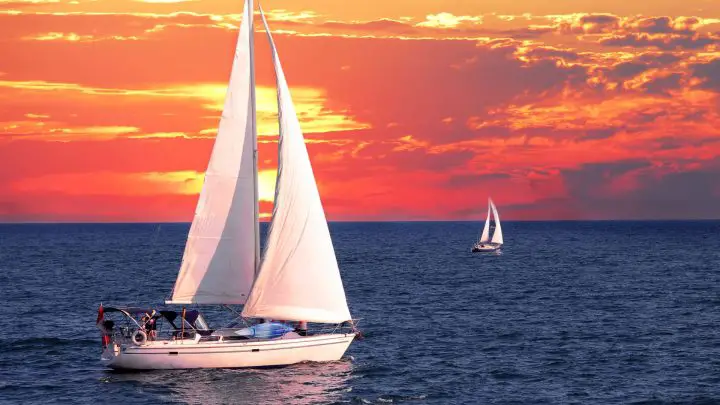
Everyone has a budget when going boat shopping, even if you’re Jeff Bezos or Elon Musk. Establishing how much you can spend on your boat is the biggest factor that will affect your decision, and it’s the backbone for all other decisions.
You must understand just how much boat costs increase as the size of boat increases. Boats are already expensive, and the average cost of owning and buying a liveaboard sailboat varies dramatically. But when the boat gets bigger, it needs bigger hardware, lines, rigging, sails, motors…everything. And bigger means more expensive, so these costs add up fast.
And then there are your storage and boat maintenance costs, all of which are charged per foot. The marina might charge you $15 per foot/per month for a dock slip, and the boatyard will similarly charge you per foot to haul and store the boat. Divers charge per foot for bottom cleaning, as do detailers for annual compounding and waxing of the hull.
When it comes to budgeting, there are two rules of thumb.
- Always pick the smallest boat you can comfortably live on.
- If you have an amount budgeted for your boat purchase, spend half on the boat and save the other half for outfitting and maintenance.
As you’ll see below, boats can be grouped by price and size. When you go up in size, you go up in price—often by a lot.
The size of the boat is a factor of your budget, but also of how big a boat you can handle. Most people believe this means driving it and maneuvering it, which is true to some extent. But a good training captain can teach you what you need to know to drive any size boat in just a few sessions.
No, the size of the boat you can manage refers more to how much maintenance you want to do. The bigger the boat, the more complex and plentiful its systems. There’s more to break on a bigger boat, and more things broken means more time fixing things.
Catamarans compound this by doubling a lot of the systems. Two engines, two saildrives, two hulls to wax, two hulls to bottom paint—you get the idea.
Another factor you should consider early on is getting insurance. Yacht insurance has gotten harder and harder to get in recent years. If you’ve never owned a boat and have no experience, you might be forced to get something small (think an under 30-foot daysailor) to get some experience on before you move up. It’s also difficult because many underwriters won’t write policies for liveaboards.
As a general rule of thumb, most people will find boats under 35 feet too small to live on full-time. Most of these vessels don’t even have standing headroom. There is often only a “wet head,” one where you take showers while sitting on the toilet.
Boats 35 to 40 feet are good for solo travelers or couples who don’t mind living in small quarters. The beds will be small and accessed only from one side, as in a v-berth or a Pullman-style berth. If there is one, the second bunk is likely only for the occasional guest.
You’ll get better accommodations when you move up to 40 to 45 footers. The second bunk may be in its own stateroom. The main suite will have an island-style berth that can be accessed from both sides—a huge upgrade for most couples. The head will likely have a separate, enclosed shower. This size sailing yacht makes a good liveaboard sailboat for most boaters.
Boats bigger than 45 feet are best for bigger families. If you often travel with kids or guests, these are the boats for you. They’re extremely spacious and make boat living easy, but the extra maintenance and cost may not be worth it.
The List — Best Sailboats to Live Aboard
All lists, whether found in internet blogs or international sailing magazines, have issues. There’s no one list to rule them all because there are simply too many different boats out there. And everyone uses their boat differently, so the “best” for you might be a terrible choice for me. Different boats for different folks, so to say.
So, what’s the deal with this list? It’s made from personal experience of having seen a lot of boats out cruising. And it’s a list that tries to put aside the fantasies—Oysters and Gunboats are pretty in magazines, but like Ferraris, not many of us will ever own one. So let’s look at some practical boats that fill each size category.
For every boat on this list, a dozen or more could’ve been included. Use these models to research brands and see which sizes suit your needs.
Boats under 35 feet tend to be best suited for solo travelers or couples comfortable living in small spaces. As always, coastal cruisers in this class have much more space than bluewater boats do. Catamarans in this class are also coastal cruisers—you need more length and volume to get real bluewater performance out of a cat. No matter which type of boat you’re looking at here, storage space on this size of liveaboard boat will be limited.
View this post on Instagram A post shared by Wilderness Of Waves (@wildernessofwaves)
Coastal Cruiser Under 35 — Catalina 34/35
If you want to move aboard, you’re on a budget, and you want the most space you can get, it’s really hard to beat an older Catalina. Starting with the Catalina 30, these beamy boats have a surprising interior volume. They make great first liveaboards.
Bluewater Sailor Under 35 — Panda/Baba 35, Tashiba 36
The famous yacht designer Bob Perry drew these Taiwanese-built boats, all tracing their lineage to the older Tayana 37 . They’re updated slightly and built by different yards, but all full keels with cutaways and built for bluewater cruising. They all have gorgeous teak joinery and are comfortable and forgiving at sea.
Catamaran Under 35 — Gemini 105MC
The Gemini 105M and 105MC were arguably the most popular cat models ever. They’re American-built, with a single diesel engine and a narrow beam that allows them to be parked in a standard boat slip. In the US, this means many more marina choices if that’s how you roll. The boat has centerboards and kick-up rudders, so the board-up draft is a scant 18 inches—gunkholing perfection.
While some Geminis have crossed oceans, they aren’t made for it. They have average (sometimes below-average) build quality and fiberglass work. However, they’re perfect coastal cruisers and capable of heading into The Bahamas.
The Gemini should be on your shortlist if you’re looking for a cheap catamaran .
Runner Up: PDQ 32
Are you looking for a small cat with better build quality? They didn’t make many of them, but the PDQ 32 is what you seek. It’s an attractive small catamaran with a wider beam. It came with twin outboards in wells, but the LRC (long-range cruiser) option had inboard diesels.

Forty feet is the sweet spot for most cruising couples—big enough to be comfortable and carry enough provisions but small enough that handling and maintenance are manageable. This class of boat has a lot of excellent choices in both coastal cruiser and bluewater boats, making it a good size range to find the perfect affordable liveaboard sailboat.
The catamaran group from 35 to 40 feet has a few very popular choices, but they are right on the edge of being too small for most cruisers. Counterintuitively, these cats are perfect for couples who don’t mind downsizing and traveling lightly. These shorter cats are prone to hobby horsing and don’t provide as comfortable a ride in bluewater as slightly longer cats do.
Coastal Cruiser Under 40 — Islander Freeport 36
The Islander brand is no longer around, but these California-built production boats from the 1970s and 80s were well-built and well-liked. The I32 and I36 were very popular cruising boats designed by Bob Perry. The Freeport 36 is a before-its-time European deck salon with enormous windows. The swing-down swim platform is another bonus for a boat from this era, as are the Pullman-style berth and forepeak-located head (some layouts). If you can find one in good condition, these boats make excellent liveaboards.
Bluewater Sailor Under 40 — Passport 40
Yet another boat from the desk of Bob Perry, the Passport 40, is a sharp-looking aft-cockpit bluewater cruiser from one of the best yards in Taiwan. They feature a long fin keel and skeg-mounted rudder. Everything about this sloop is just right for long-term cruising.
Catamaran Under 40 — Prout 38
The Prout 38 traces its heritage back to the earlier Prout Snowgoose. The boat is still being made, now under the Broadblue brand. It’s a sturdy British-built cat made for serious offshoring. While it lacks some of the open feeling that newer charter boats have, it more than makes up for it with its robust and high-quality build.
Runner Up: Leopard 40 (2005-2009)
This early L40 (don’t get confused with the newer ones built around 2020) was designed by famous multihull designers Morelli and Melvin. It’s got more of the things you might expect from your typical charter cat: a sliding salon door, galley-up layout, and a huge walk-through cockpit.
While this seems a small step up from the size of boats above, prices increase rapidly above the 40-foot mark. At this point, the boat’s gear needs to be bigger and heavier, from all the lines and rigging to each block and winch. Engines are now larger four-cylinder diesels, and there’s much more hull area to clean and paint.
A 45-foot coastal cruiser has enough space to keep a small family happy for short trips or a couple happy for any length of time. These boats usually have island berths in a spacious master bedroom, so no more crawling over each other just to go to the bathroom! Bluewater boats in this class are a little smaller inside, making them just right for most couples doing a long-term cruise.
As far as catamarans go, the 40 to 45-foot range is the perfect sweet spot for most cruising couples. A spacious interior plus excellent seakeeping abilities make these top picks. There are tons of boat choices out there, and most of the best cruising catamarans come from this size group.
View this post on Instagram A post shared by Tara Smith (@minofmine)
Coastal Cruiser Under 45 — Jeanneau Sun Odyssey 42DS
Jeanneau is part of Groupe Beneteau , but their boats often have a more refined finish than Beneteaus. The DS stands for “deck salon.” They feature larger windows that let in more light and have better visibility than a standard cruiser. This is especially welcome if you’re attracted to the living space in a catamaran but need something smaller and more affordable.
The 42DS also has an enormous island berth, plus a huge twin-helm cockpit with lots of space for entertaining.
Bluewater Sailor Under 45 — Hylas 44
The Hylass 44 is regularly picked as one of the best offshore cruising boats. It’s a center cockpit boat designed by German Frers. It has a wonderful layout with tons of living space and a large, usable galley. The aft cabin has a large island berth with an en suite head.
Catamaran Under 45 — Leopard 42/43 (2001-2006)
These early Leopard charter cats are highly sought after on the used market. Like all charter cats, the best finds are the “owners versions” with one hull dedicated to the master stateroom with en suite head and shower. The Leopard 42, which came out in 2002, had a soft canvas cover over the cockpit and was updated to the Leopard 43 with a hardtop.
Above 45 feet is another big price jump. For beginners, these big boats will require some training and experience before you head out on your own.
Related: Best Boat for Beginners
View this post on Instagram A post shared by Leopard 46 "Shanties" (@leopard46shanties)
Coastal Cruiser Under 50 — Beneteau Oceanis 473
This big Beneteau came with either 2, 3, or 4 staterooms. Finding the right layout is as important as finding the right boat. The two-stateroom version has enormous berths and lots of storage, perfect for couples with occasional guests or families of three. Most have the standard keel with less than a six-foot draft, making this fin keel/spade rudder boat a rare find. They were built from 2000 to 2005.
Bluewater Sailor Under 50 — Hallberg Rassy 46/48
Hallberg Rassys are well-regarded boats built in Sweden, mostly designed by German Frers. These are high-end boats of the best quality, so don’t expect to find one available cheaply. They’re gorgeous, however, and make wonderful world cruisers.
Catamaran Under 50 — Leopard 46/Moorings 4600 (2006)
If you want a big catamaran, it’s hard to go wrong with the 2006 Leopard 46. Where modern Lagoon and Leopards have tall profiles with tons of windage, this is one of the newest, largest boats that still have single-level living. It has distinctive hull chines that increase living space without increasing wetted surface and plenty of sail area for good performance. In true Leopard fashion, all lines are led to the helm for easy short-handed cruising despite the boat’s large size.
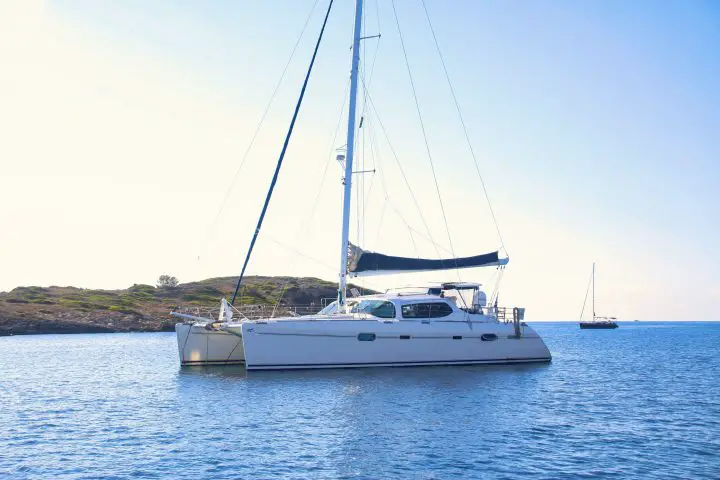
Boats in this class are borderline yachts based on their sheer size. If you were to charter these boats, they’d usually come with a crew. That size means they’re more expensive and more of a handful to manage daily.
Coastal Cruiser Under 60 — Irwin 54
The Irwin brand is long gone, but many examples are available on the used market. They were known especially for their large center cockpit ketches, like this 54-footer. This is a spacious, big water boat that certainly meets the qualifications of most bluewater boats. They can go anywhere, but they may need maintenance and refit given their ages.
Don’t get to lured by the low prices of these boats. You’ll have to lay out some serious cash to get one ready to cruise long-range. But if you aren’t opposed to some hard work and projecting, the Irwin can get you a lot of boat for not much money.
Bluewater Sailor Under 60 — Amel Super Maramu 2000 (53′)
Made famous by the Delos YouTube channel, the Amel is a French-built brand of high-quality bluewater boats. Today, this brand’s new models look like many others—wide sterned, flat-bottomed sloops. But the Maramus that made them famous were unique—ketch rigged and ruggedly built, designed to take a cruising couple anywhere. Electric winches were standard on everything to keep such a large boat easy to operate.
Catamaran Under 60 — Privilege 585
Privilege is the French-made catamaran that you don’t hear enough about. Unlike Lagoon and Fountaine Pajot, these are beefy cruising boats ready to take you anywhere. Their construction and fit-and-finish are first-rate, as is the joinery down below.
Living on a sailboat is an adventure—it’s not for everyone. Finding the right boat is an important part of doing it successfully, but it’s not the only step in preparing for the lifestyle.
You should also consider checking my post on liveaboard catamaran options, to make sure you research thoroughly enough!
What makes a great liveaboard sailboat?
Everyone’s priorities for a liveaboard sailboat are different—a bluewater cruiser looking to sail around the world might pick a very different boat from someone who lives full-time dock life. In general terms, you need to find a boat that is safely capable of taking you where you want to go and has enough living space to be comfortable while doing it.
Sailing catamarans are some of the most popular liveaboard sailboats because their living space is unmatched. Most are also bluewater-capable cruisers that can go pretty much anywhere.
What is the best size sailboat to live on?
The size of the boat you’ll be comfortable on long term is a personal choice that depends on your personality and the number of people you’ll be traveling with. Solo travelers may be content with a sailboat around 30 feet, while most couples are comfortable on something around 40 feet. Forty-five to fifty feet is more realistic if you often have guests or kind on board.
With all of this in mind, however, it’s really important to remember that the costs of buying and maintaining a sailboat increase exponentially with length. Getting the smallest boat you are comfortable living on is always better because that will be easier to manage and keep in the long run.
What are the negatives of living on a sailboat?
People live on their sailboats differently, so it’s difficult to narrow down the biggest negatives. Everyone struggles with the small living space that a boat affords. You’ll have to downsize your possessions to the absolute minimum you need. And getting personal space away from your spouse or family is pretty much impossible on a small boat.
Why are sailboats so expensive?
New boats require a massive investment in time and resources to produce. The nicer the boat, the more time and skill it takes to build, which makes costs soar. Some production companies, like Beneteau, have found ways to reduce production costs and keep the price of new boats more reasonable. But these boats pale compared to other yachts in terms of overall quality.
Older used boats can be found pretty cheaply. In fact, it’s often possible to find free or nearly-free boats that are on their way to the junkyard or dumpster. The key is understanding how much work and money it will take to get these boats ready to go again.
Is it a good idea to live on a sailboat?
Living on a boat is an amazing way to experience seaside living or traveling the world by water. But it’s also a unique, out-of-the-ordinary lifestyle choice that’s not without challenges.
Before you move onto a sailboat, you’ll want to research the topic carefully and talk to some folks who already to it. Many people start with occasional boating, spending a week or more onboard to try it out. With a little experience, it’s easy to see if it’s something you could do for the long term or if it’s best to keep a land house and enjoy the water occasionally.
Can you live comfortably on a sailboat?
Many people live comfortably on sailboats, but a lot depends on the size of the sailboat and your tolerance for living in a small space. Even the largest sailboats can feel cramped, while some folks love the cozy feeling of living on the tiniest boats.
Matt has been boating around Florida for over 25 years in everything from small powerboats to large cruising catamarans. He currently lives aboard a 38-foot Cabo Rico sailboat with his wife Lucy and adventure dog Chelsea. Together, they cruise between winters in The Bahamas and summers in the Chesapeake Bay.
Leave a comment
Your email address will not be published. Required fields are marked *
Save my name, email, and website in this browser for the next time I comment.
- Types of Sailboats
- Parts of a Sailboat
- Cruising Boats
- Small Sailboats
- Design Basics
- Sailboats under 30'
- Sailboats 30'-35
- Sailboats 35'-40'
- Sailboats 40'-45'
- Sailboats 45'-50'
- Sailboats 50'-55'
- Sailboats over 55'
- Masts & Spars
- Knots, Bends & Hitches
- The 12v Energy Equation
- Electronics & Instrumentation
- Build Your Own Boat
- Buying a Used Boat
- Choosing Accessories
- Living on a Boat
- Cruising Offshore
- Sailing in the Caribbean
- Anchoring Skills
- Sailing Authors & Their Writings
- Mary's Journal
- Nautical Terms
- Cruising Sailboats for Sale
- List your Boat for Sale Here!
- Used Sailing Equipment for Sale
- Sell Your Unwanted Gear
- Sailing eBooks: Download them here!
- Your Sailboats
- Your Sailing Stories
- Your Fishing Stories
- Advertising
- What's New?
- Chartering a Sailboat
- Cruising Yachts 30' to 35'
Popular Cruising Yachts from 30 to 35 Feet Long Overall Their Physical Properties & Key Performance Indicators
Welcome to this ever-growing gallery of some of the most popular cruising yachts between 30 and 35 feet (9.1m to 10.7m) long overall.
30'-35' Cruising Yachts featured on this page...
| |
| |
Medium sized cruising yachts like these are capable of serious offshore passage making, whilst being reasonably economic to maintain and operate.
And for competitive types, 30-35 foot cruising yachts are a popular size for club racing under handicap rating rules.
Behind each of the cruising yacht images there's a lot more information, including:
- Dimensions & Specifications;
- Design Ratios;
- A summary analysis of the boat's predicted sailing characteristics in terms of performance, stiffness, heaviness, comfort in a seaway and resistance to capsize.
To see it all, just click on the relevant image...
Wauquiez Centurion 32
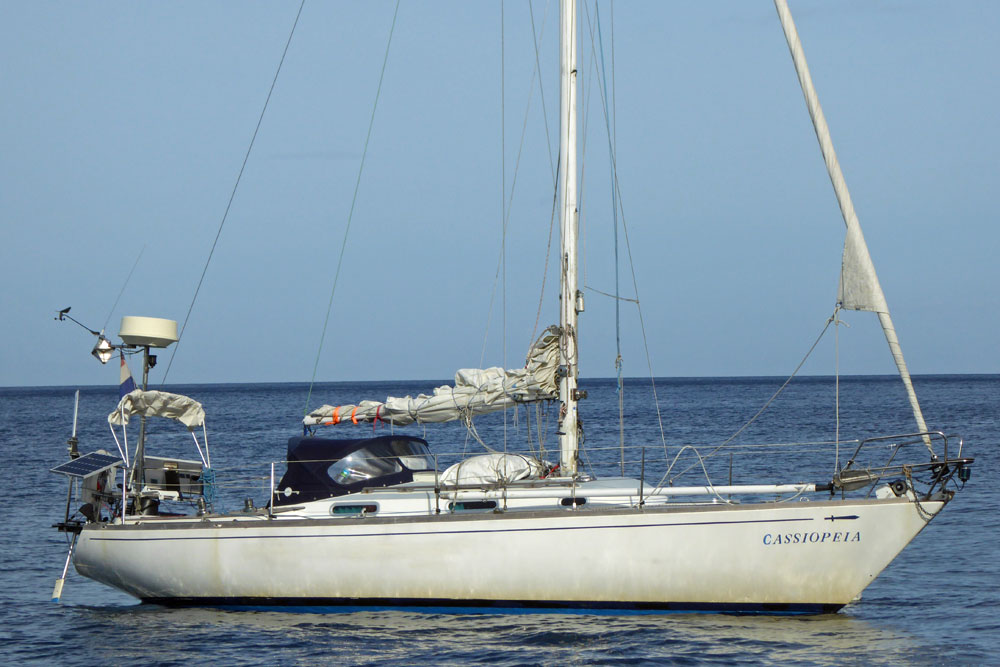
Beneteau Oceanis Clipper 311
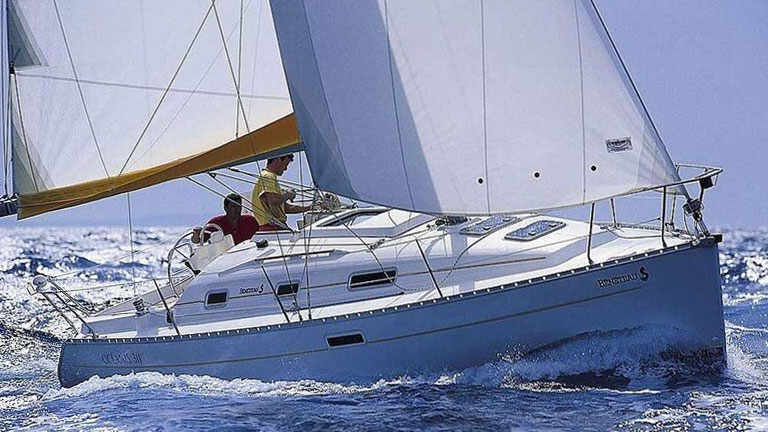
Pearson 303
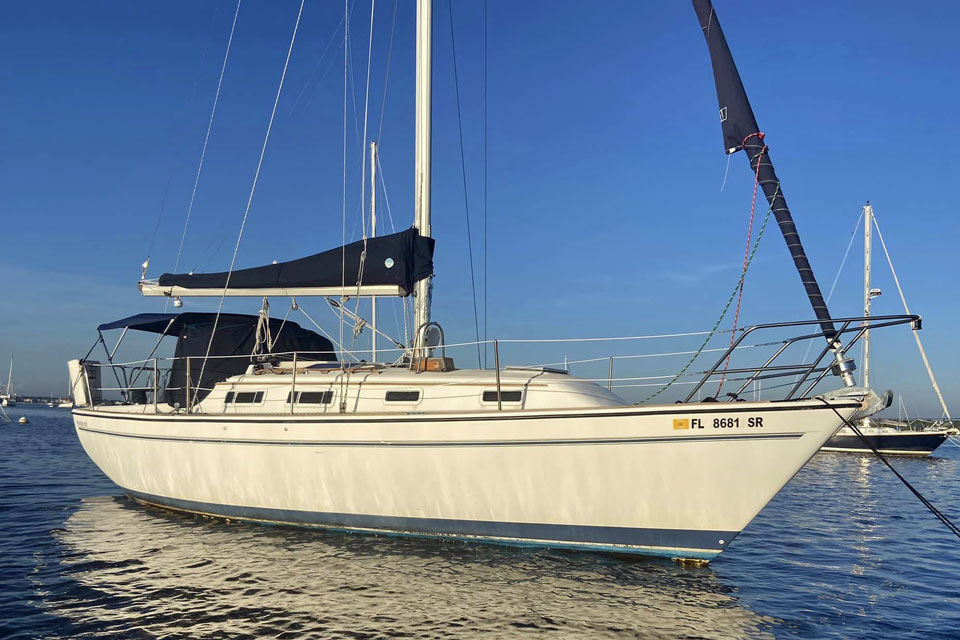
Pearson 323
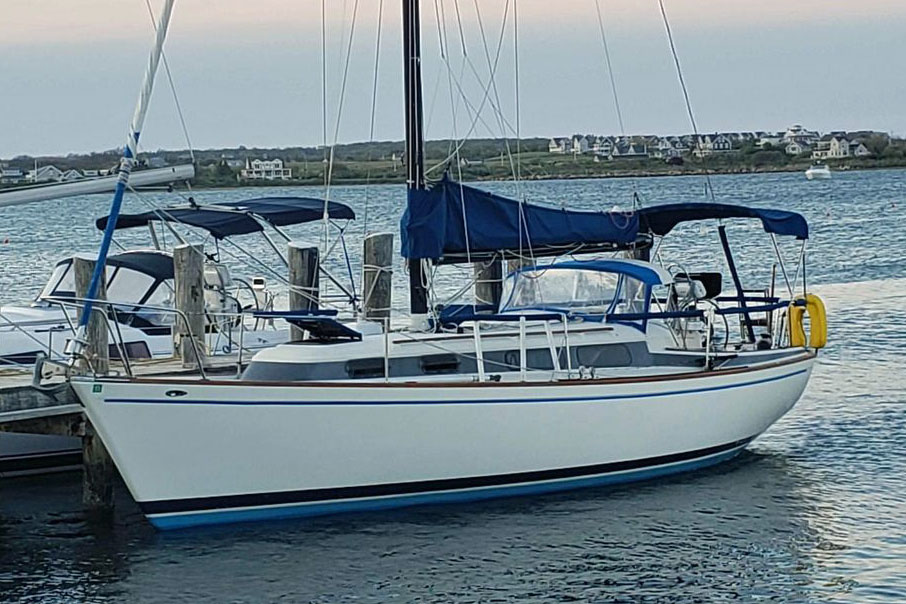
Allied Seawind MkII Cutter
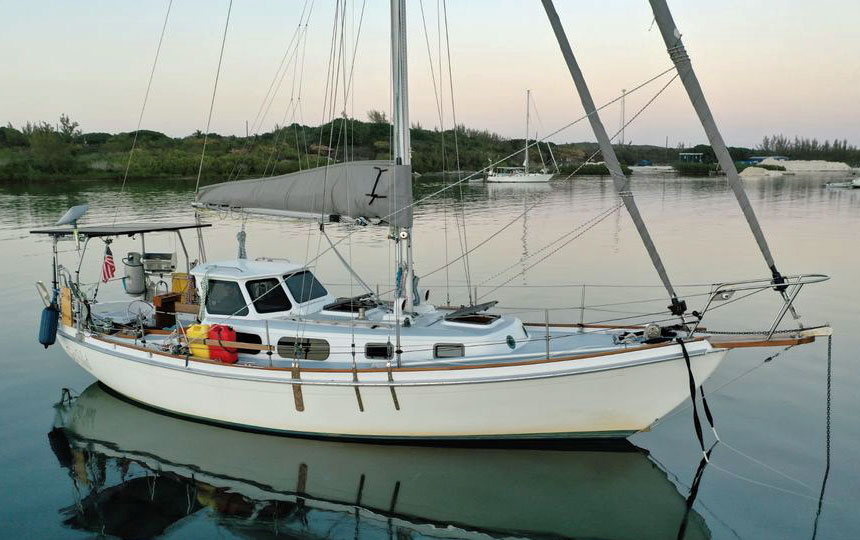
Jeanneau Sun Light 30
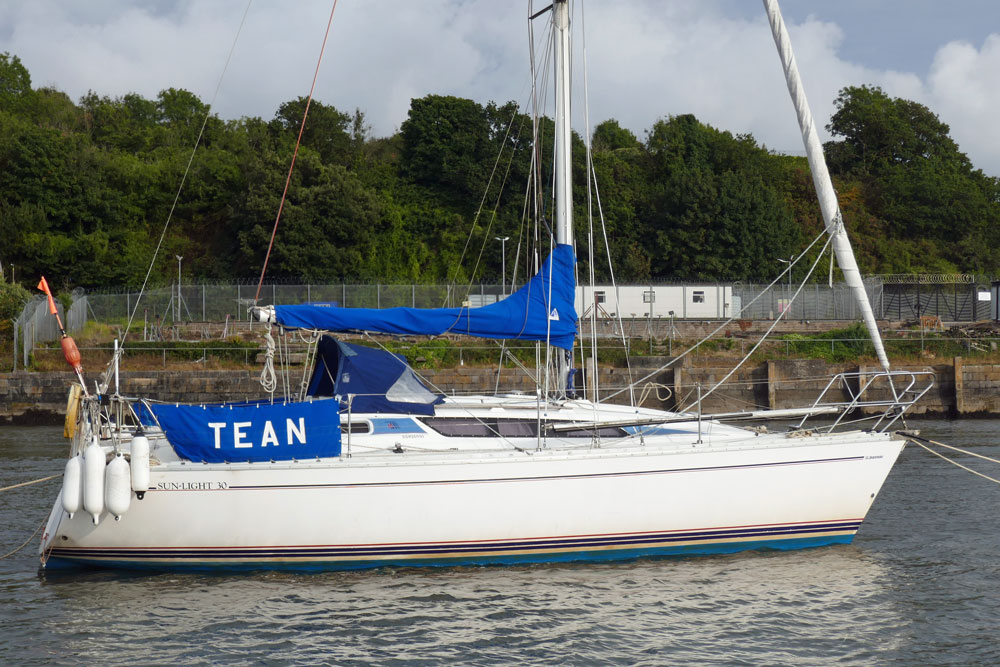
Grand Soleil 343
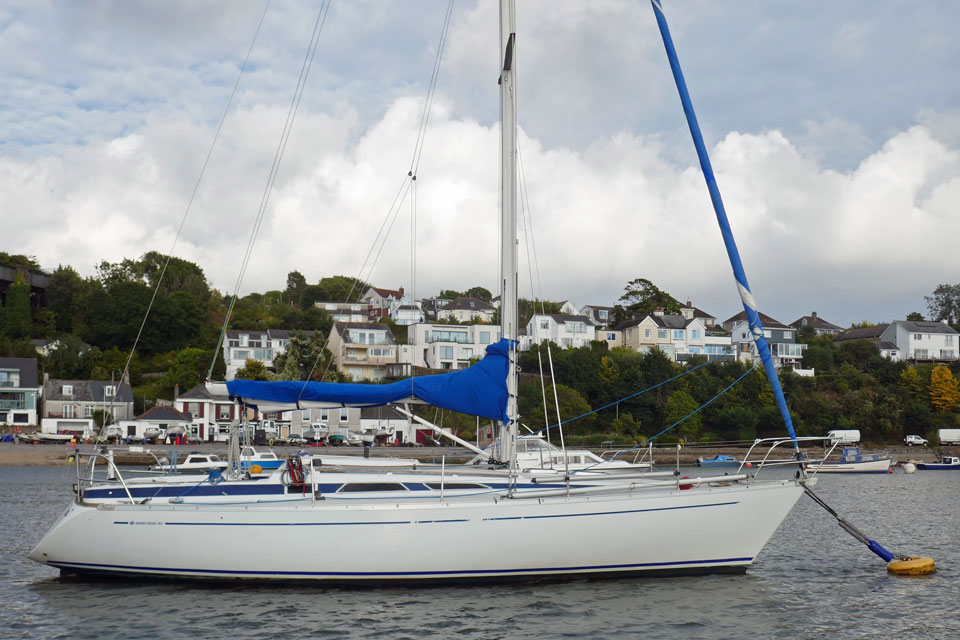
Feeling 850
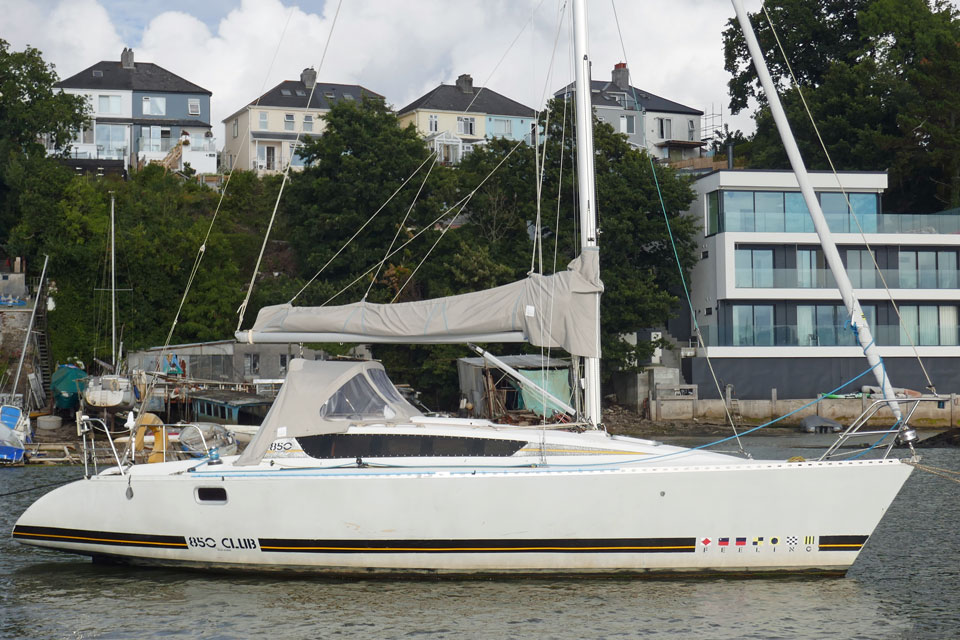
Westerly Tempest 31
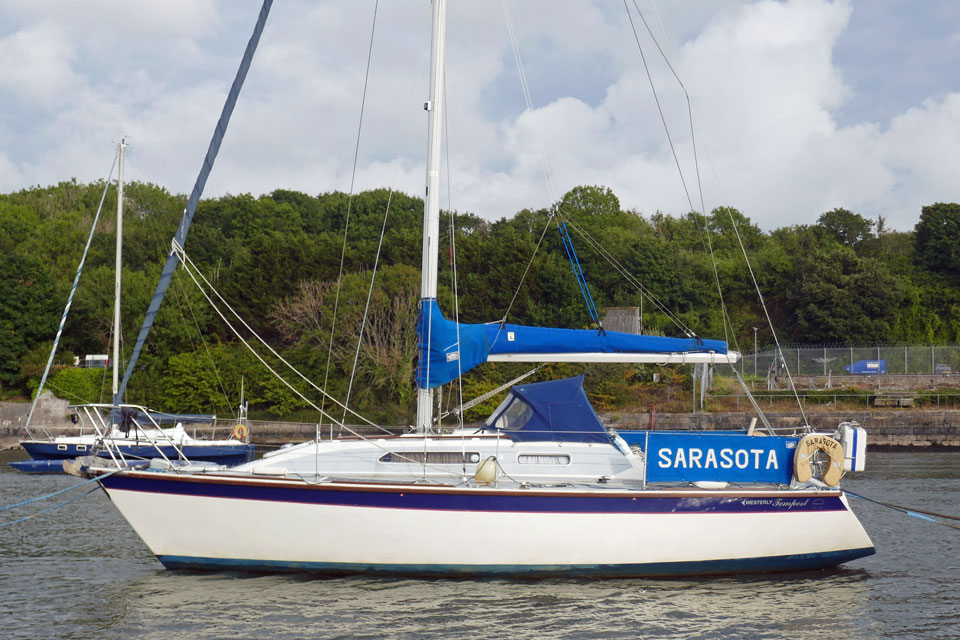
Bavaria 31 Cruiser
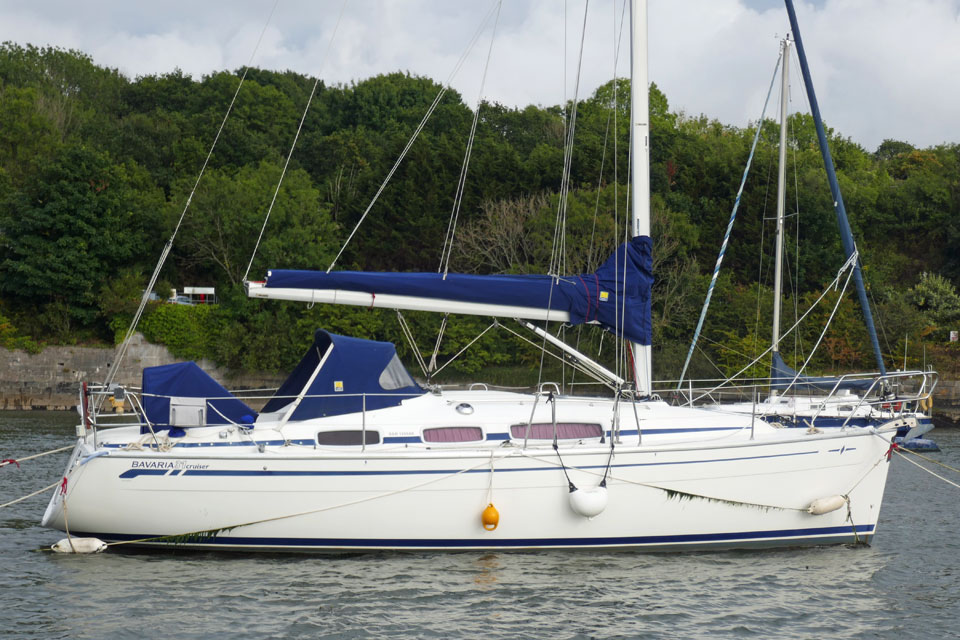
Westerly Kestrel 35
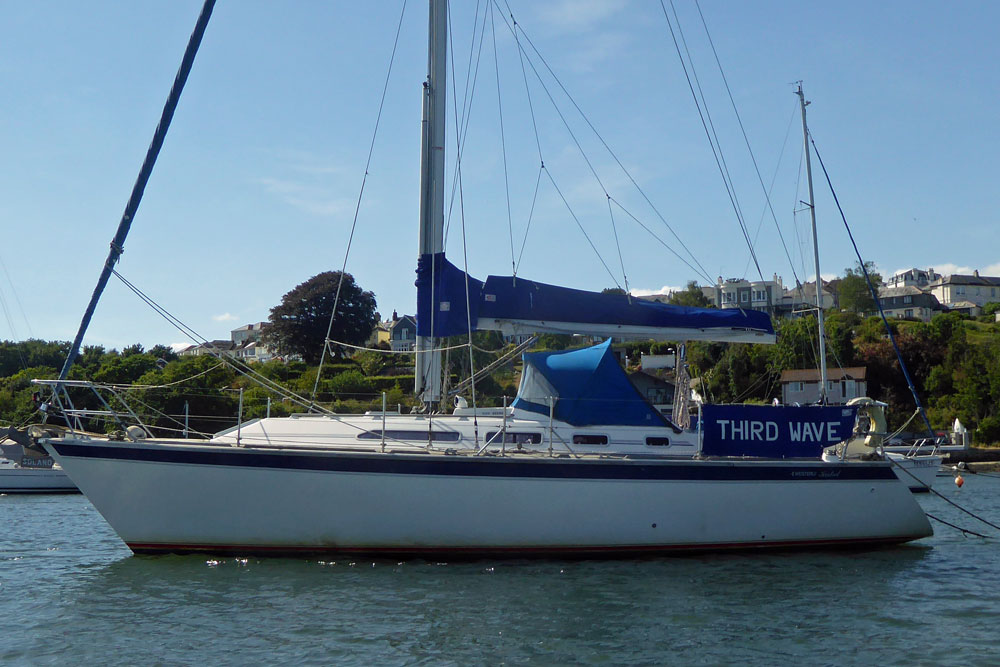
Westerly Berwick 31
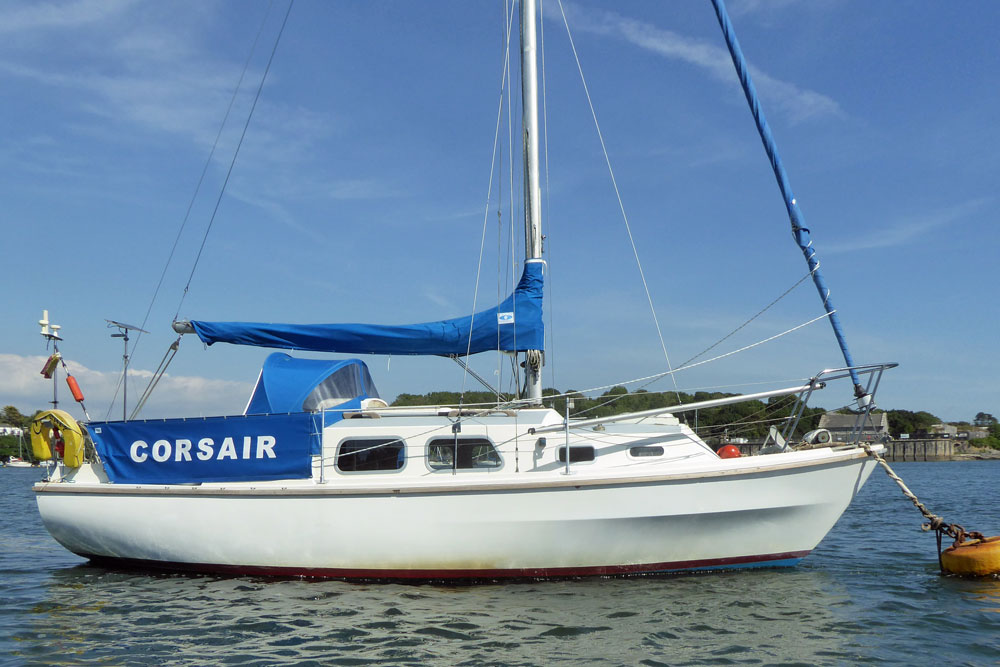
Dehler 35 CWS
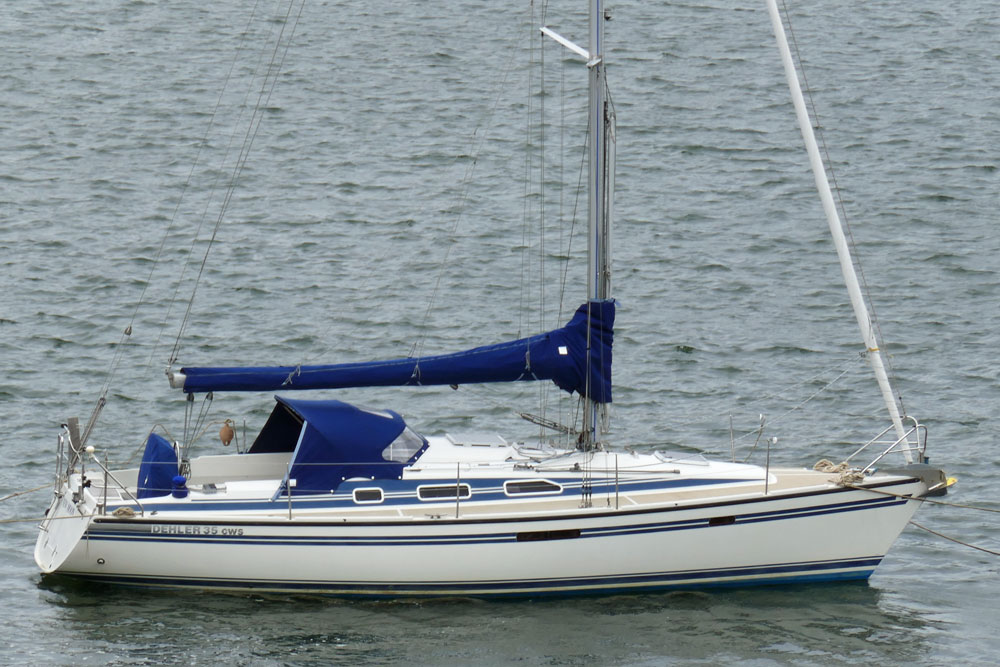
Westerly Vulcan 34
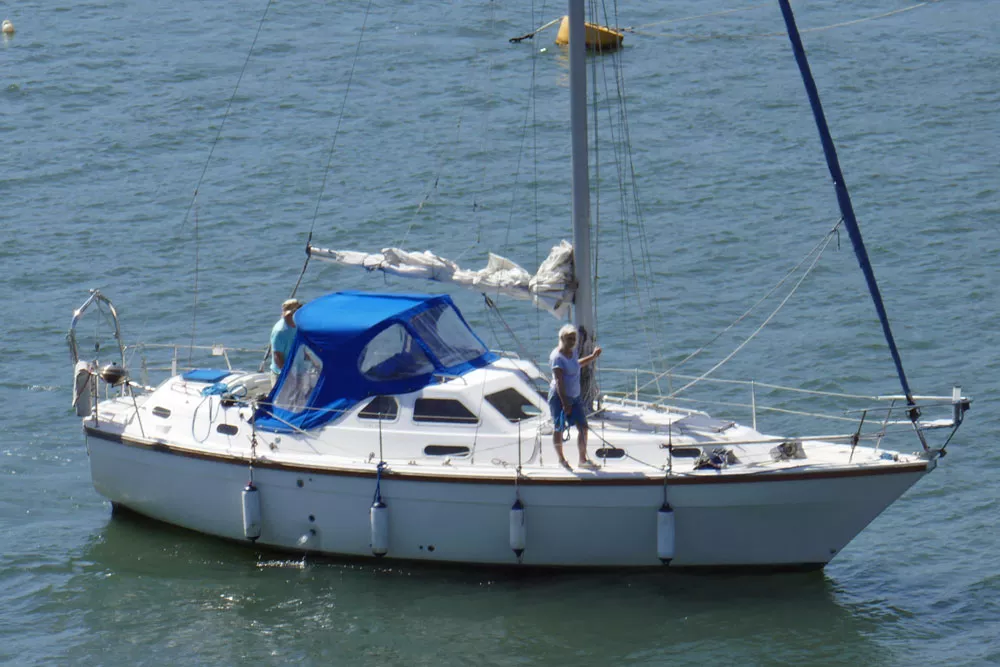
Jeanneau Sun Odyssey 32-1
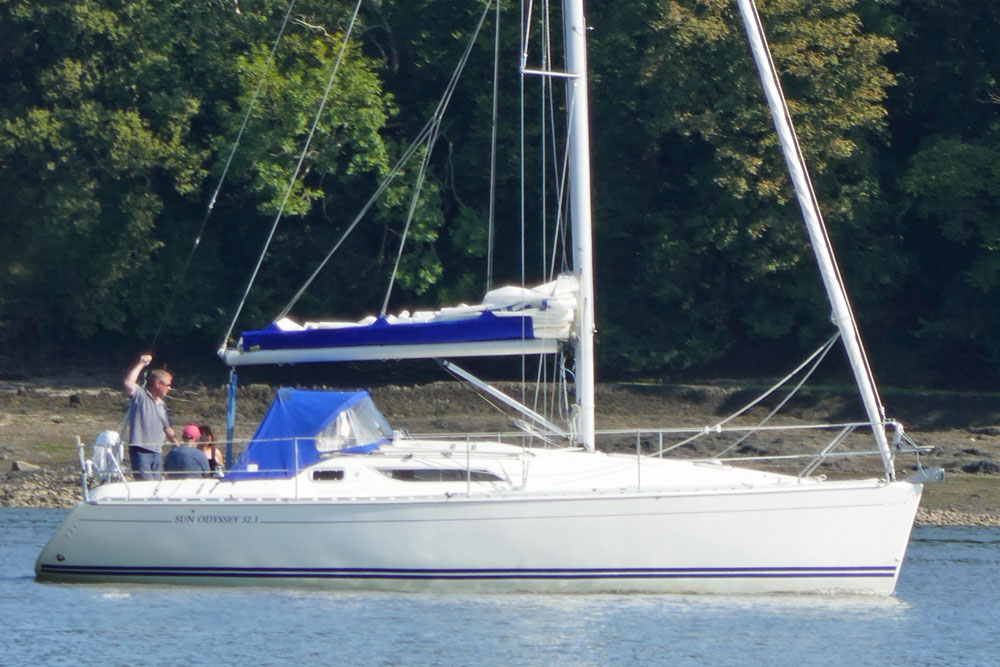
Elizabethan 33
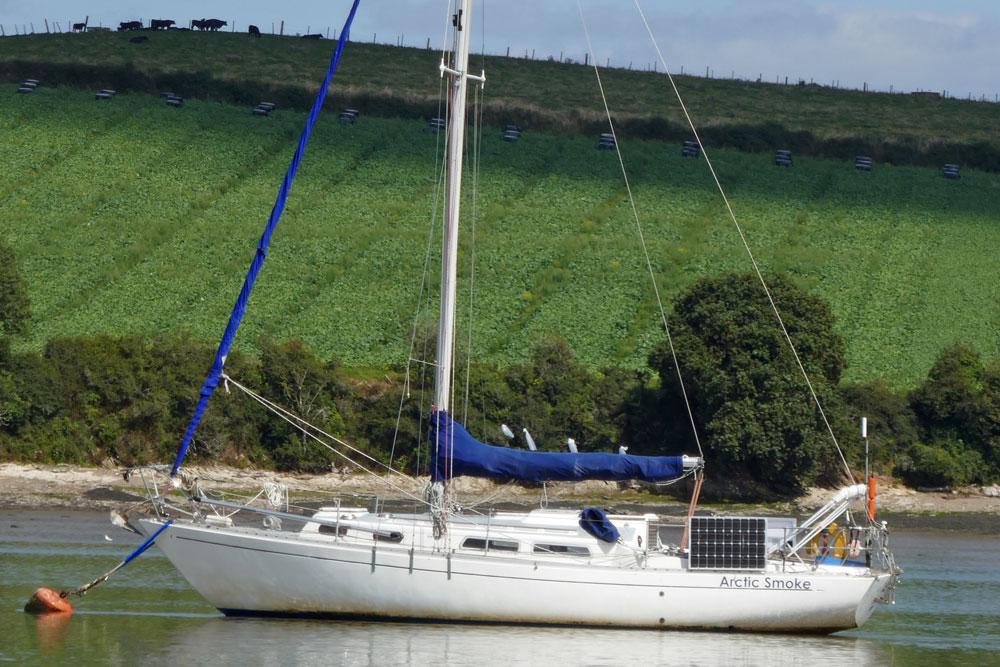
Westerly Seahawk 35
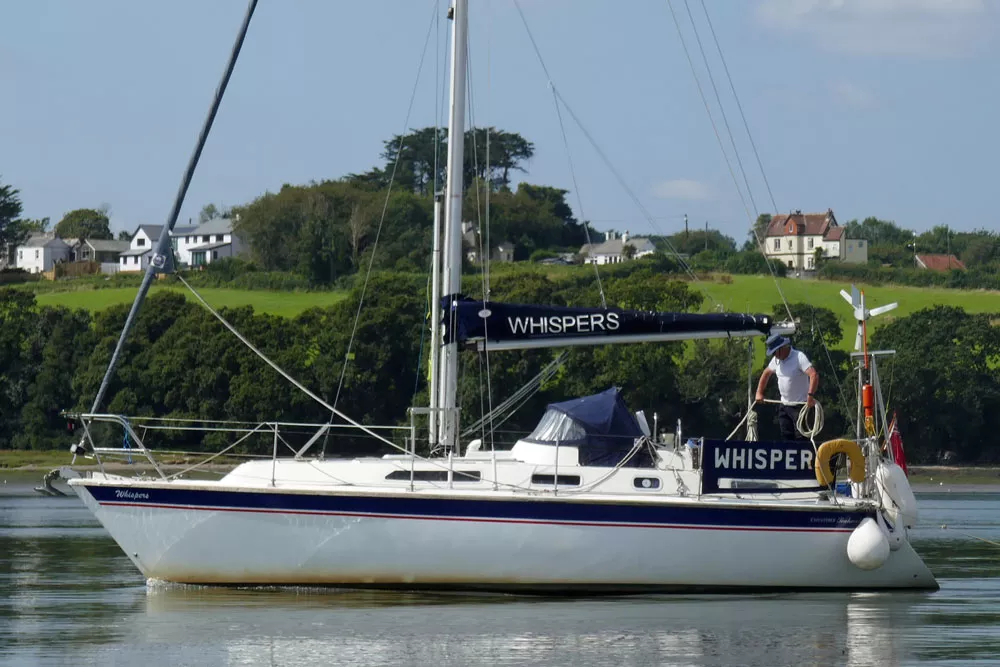
Nicholson 32
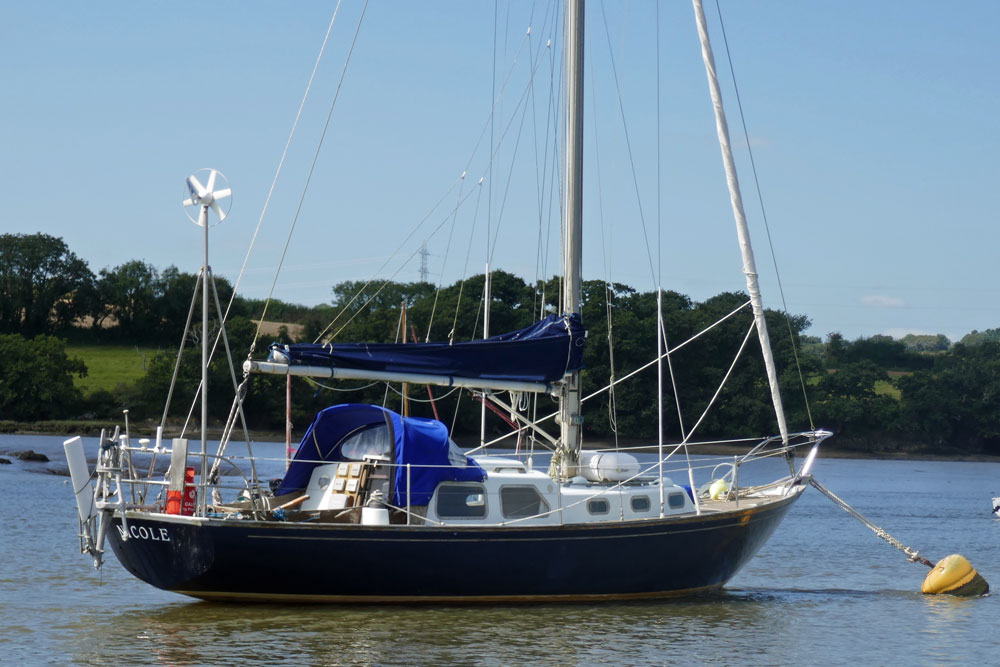
Westerly Ocean 33
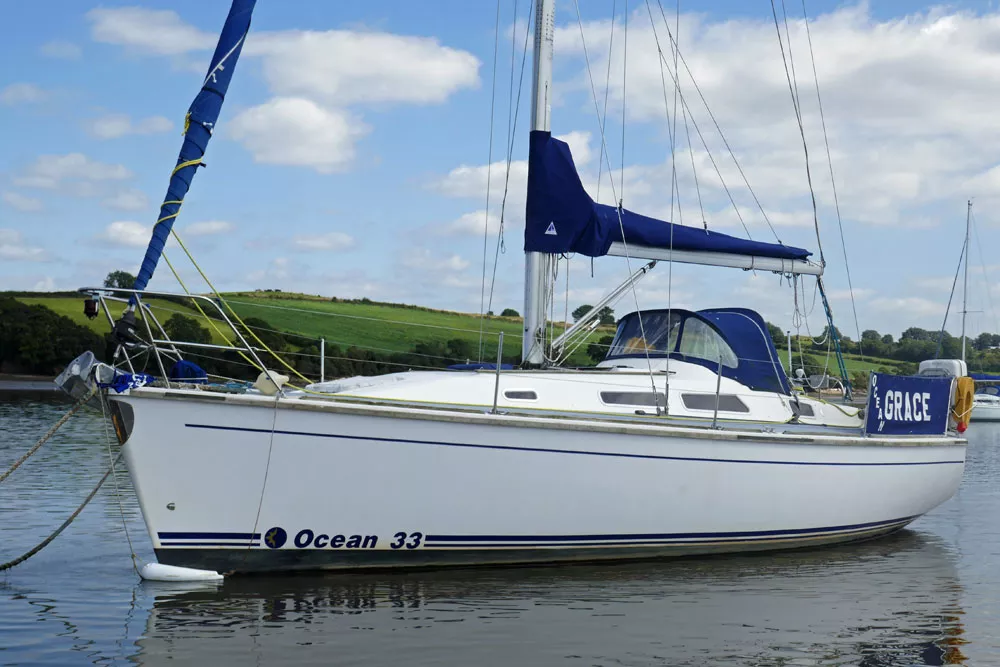
Hunter Channel 323
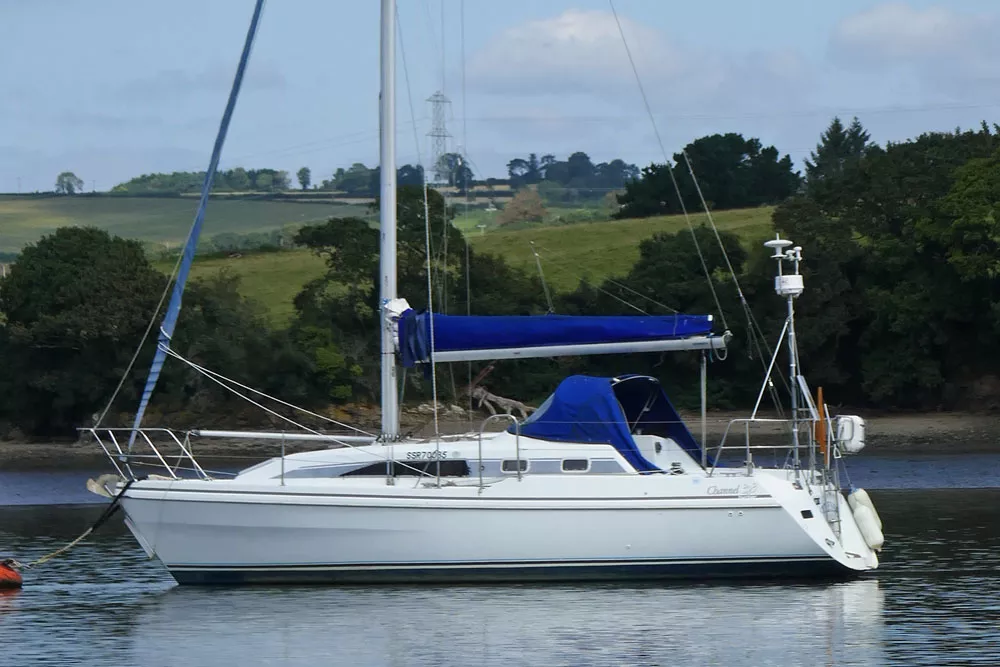
Island Packet 350
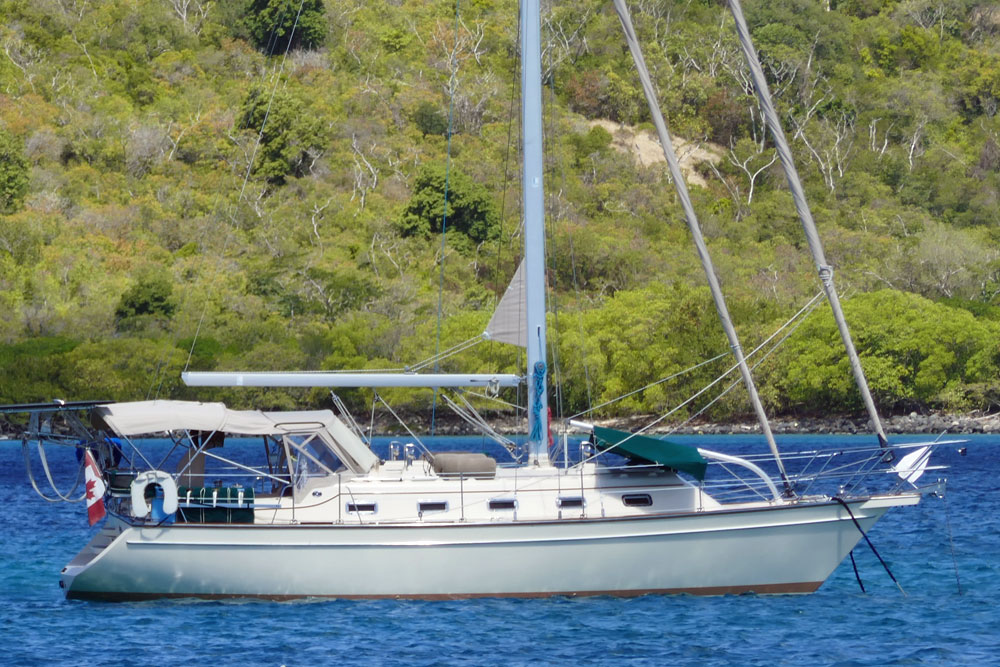
Corvette 31
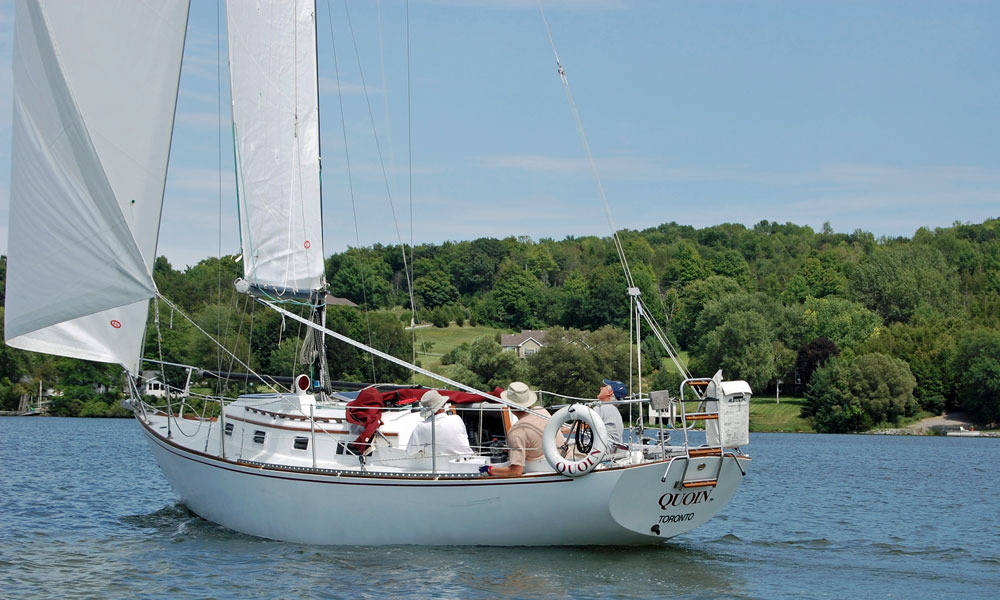
Beneteau Oceanis Clipper 343
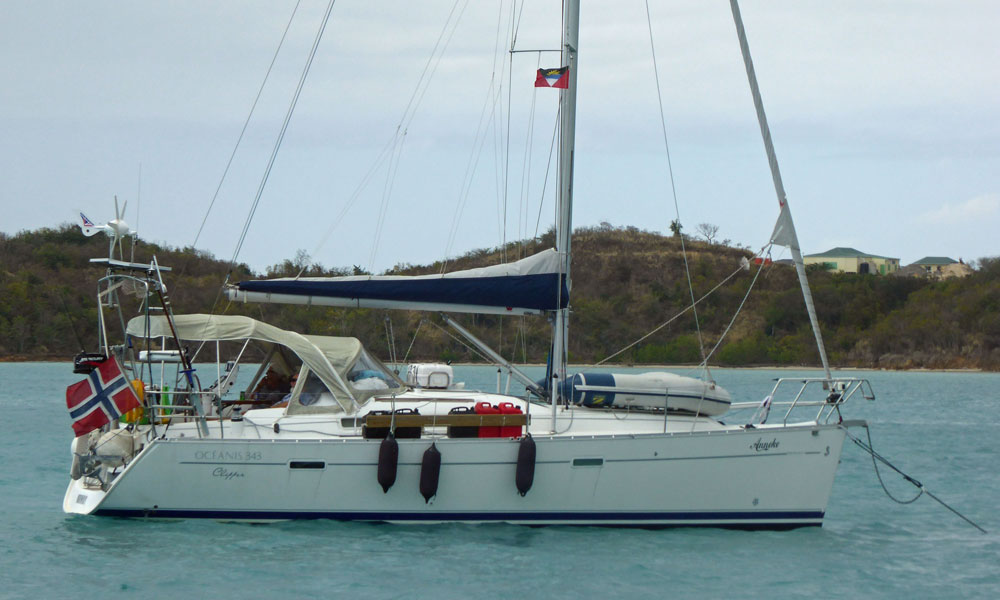
Hallberg-Rassy 94
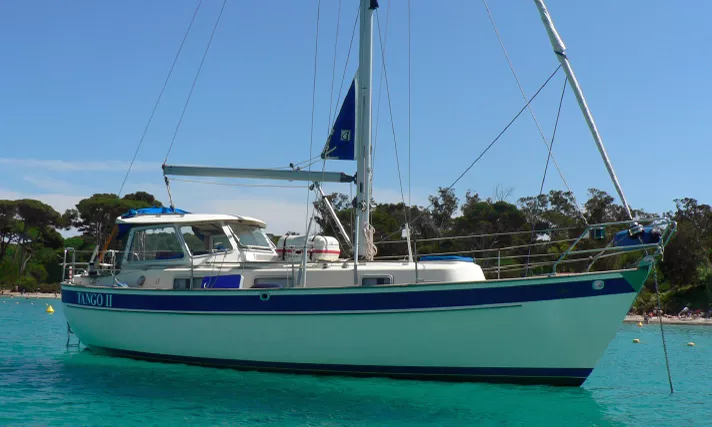
Many thanks to Richard Stuckey for the great pic of his cruising yacht 'Tango II' , shown here at anchor off Porqeurolles Island in the Mediterranean South of France.
Wauquiez Gladiateur 33
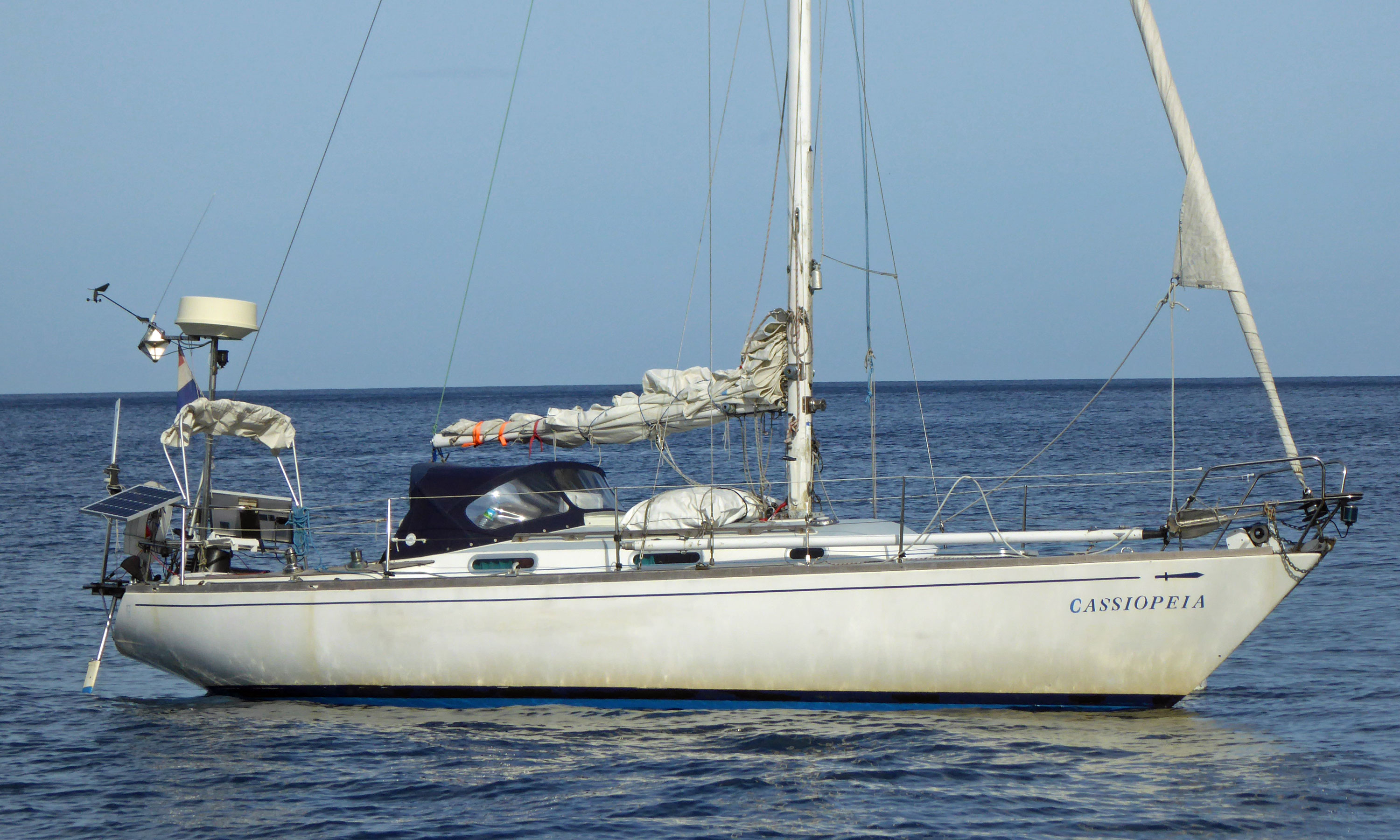
Jeanneau Attalia 32
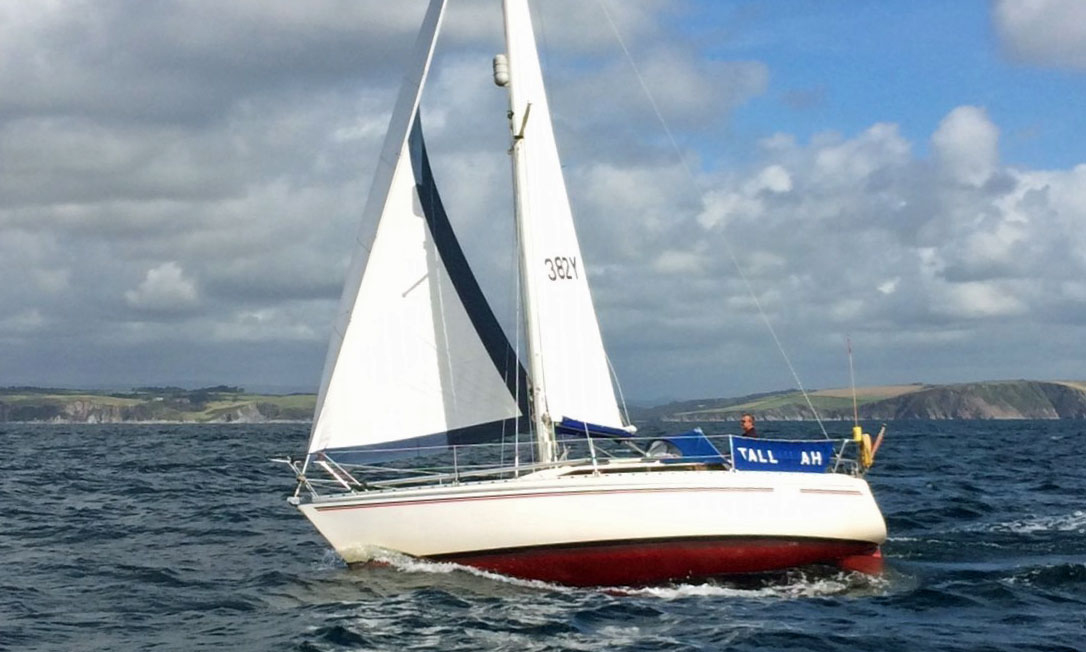
Thank you Paul Wright , for submitting this pic of your cruising yacht 'Tallulah'.
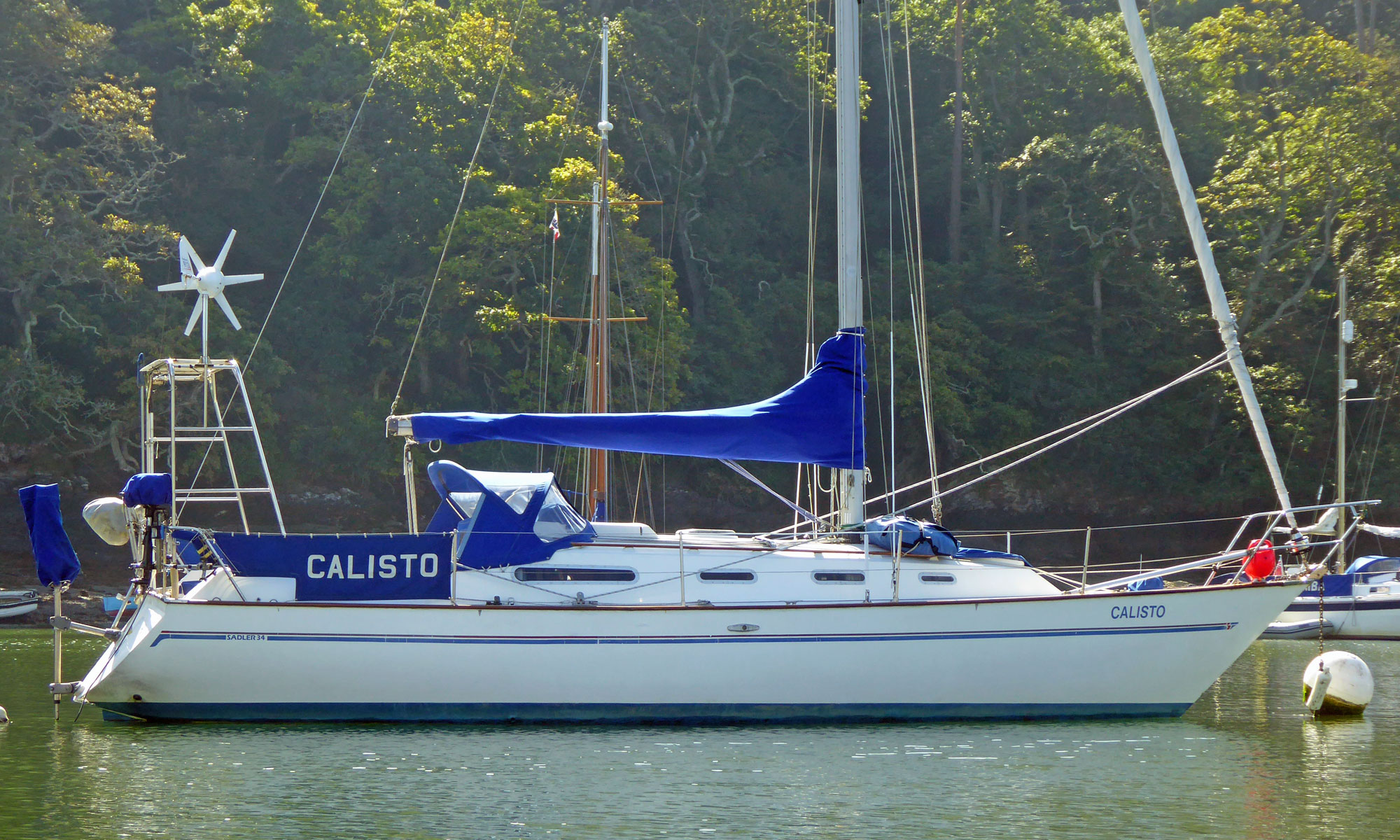
The owner of 'Second Star' tells us...
"This one is my Hunter 33e (now Marlow-Hunter 33e) "Second Star". The "e" stands for extended cockpit. It has a drop-down, walk-through transom that opens up the cockpit significantly and serves as a helm seat when up. I bought the boat new in 2014 and my longest cruise to date was from Annapolis MD to its slip in Alexandria, VA with my daughter. Of course, my intent is to take it on longer cruises like circling the DELMARVA peninsula, which would give me offshore time off the Delaware coast. It's a very comfortable cruising yacht of moderate size."
Aphrodite 101
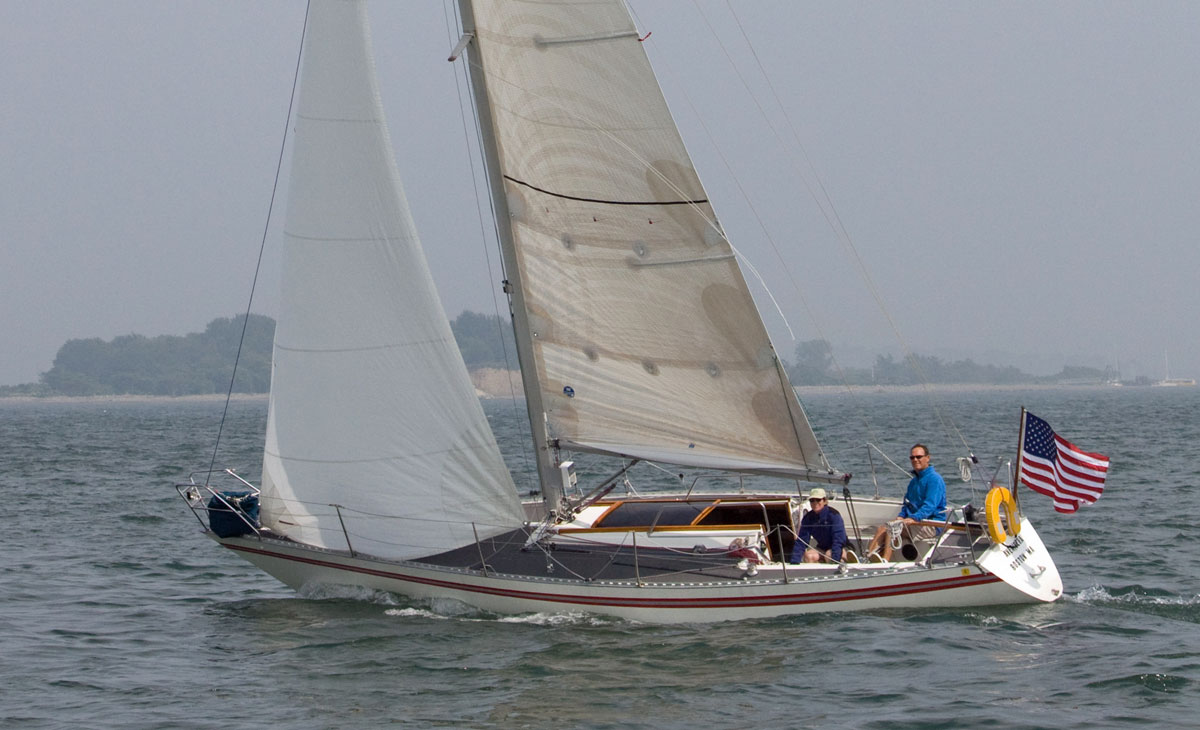
With their long, narrow and light hull and tall fractional rig these elegant sailboats have had many successful single and double-handed victories in distance races both coastal and offshore.
The owner of 'Averisera ' tells us:
"She has a very narrow hull with two good sea berths amidships. The galley is just aft of the berths, sink to starboard and cooker to port. Step down from companionway just aft of galley; seating to change into or out of wet gear without making sleeping area wet. Head all the way forward is OK but not great. Low free board means sink does not drain on port tack. Hull form is very, very sea kindly. Beautiful sailor, easy to steer in wide range of conditions and points of sail. For a small boat she is a competent cruising yacht."
Beneteau First 30E
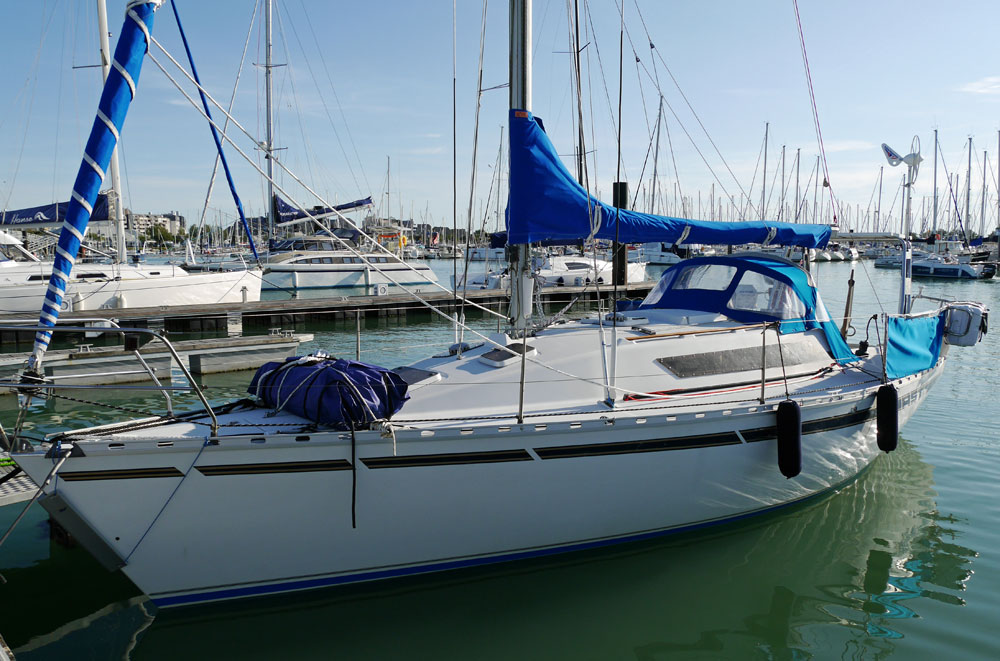
Westerly 33
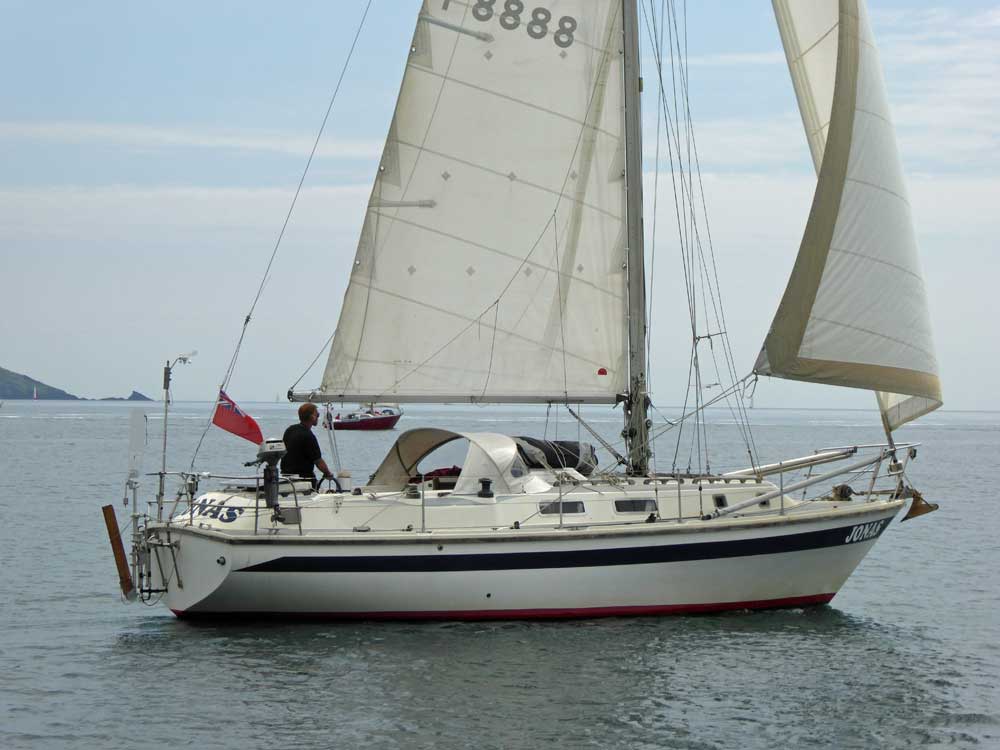
Have you got a cruising yacht in this size range?
If so, and you'd like to see an image of her on this page, please click here to send your pic to sailboat cruising.com and we'll do the rest.
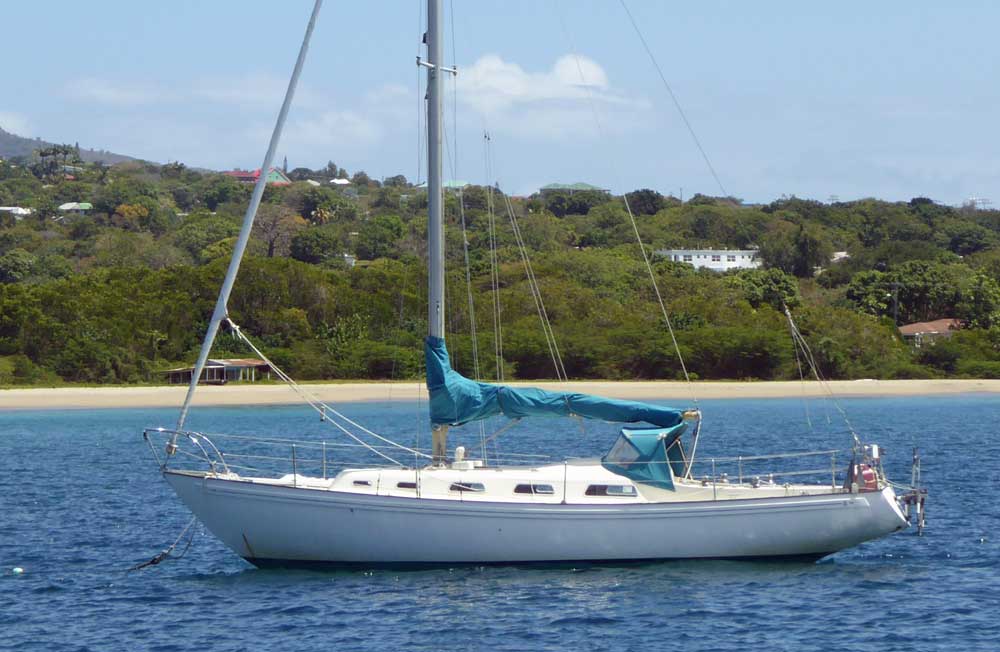
Albin Nova 32
Contessa 32.
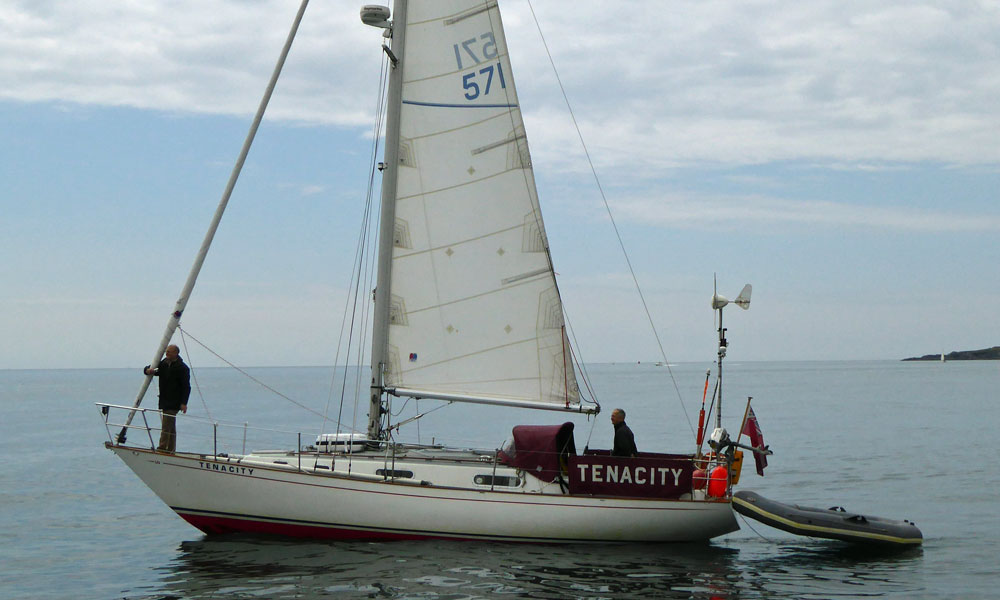
Nicholson 32 (Mark 10)
The Nicholson 32 Mk 10 cruising yacht in the pic is very dear to me; 'Jalingo 2' she's called - and I used to own her. Dick McClary, previous owner.
Westsail 32
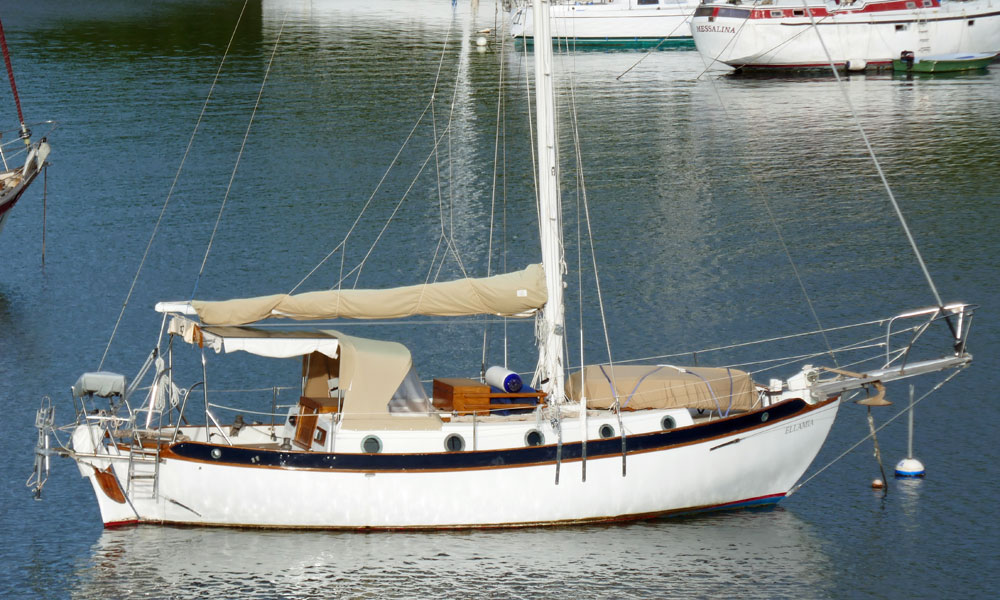
Southern Cross 31
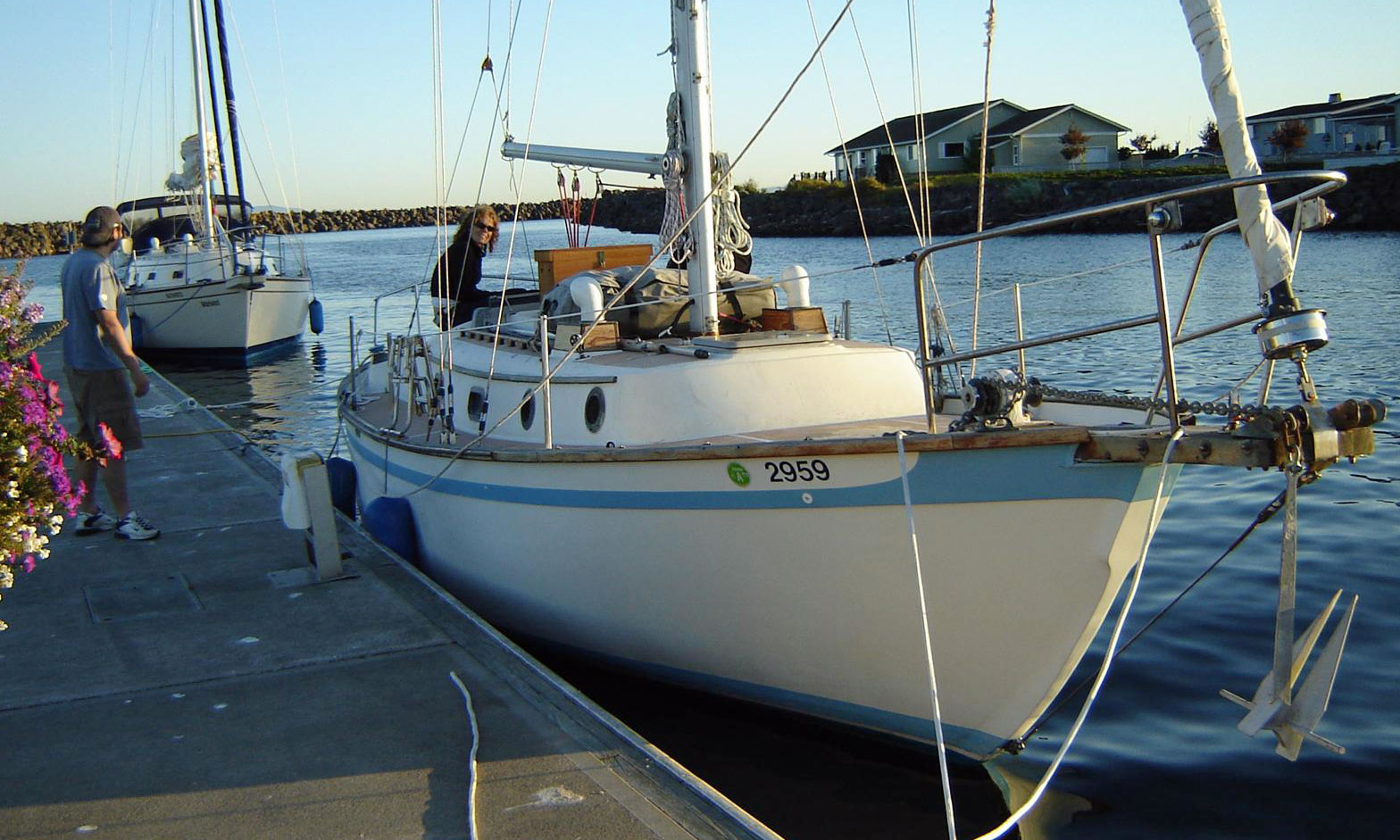
Thank you, Vern Bastable , for submitting this pic of your cruising yacht 'Mischief'.
Willard 30/8t
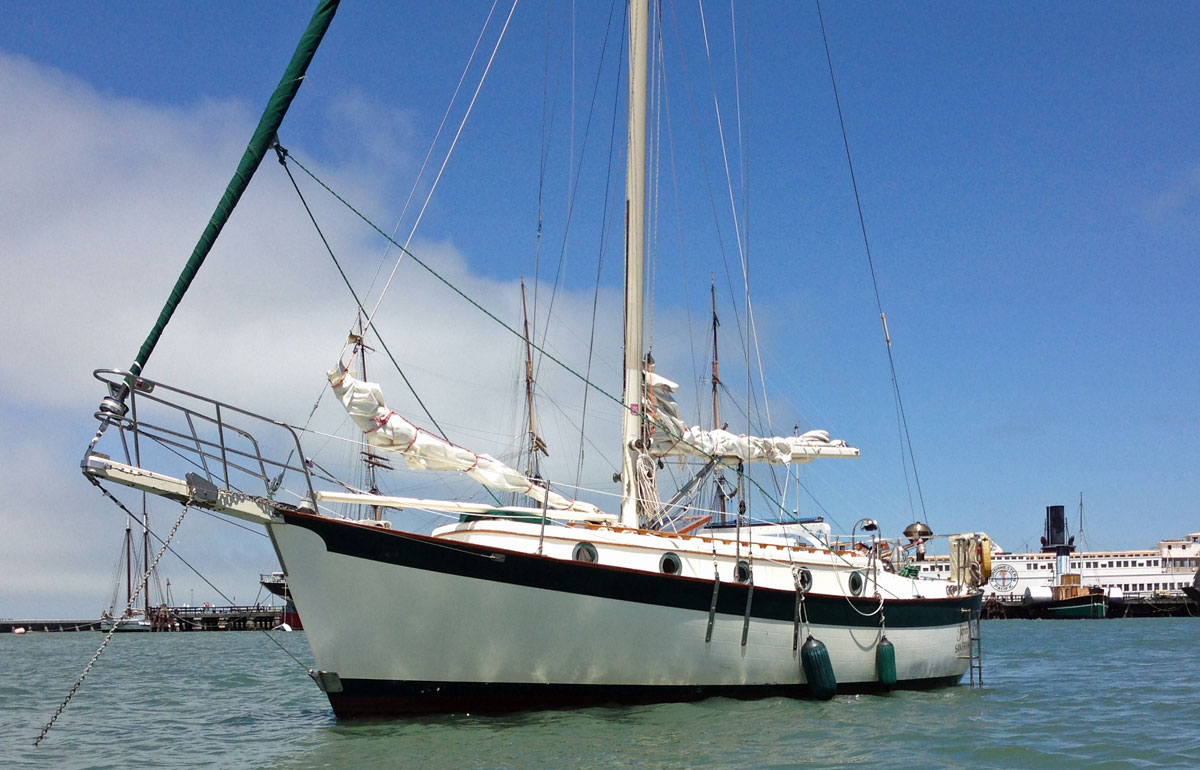
Vancouver 32
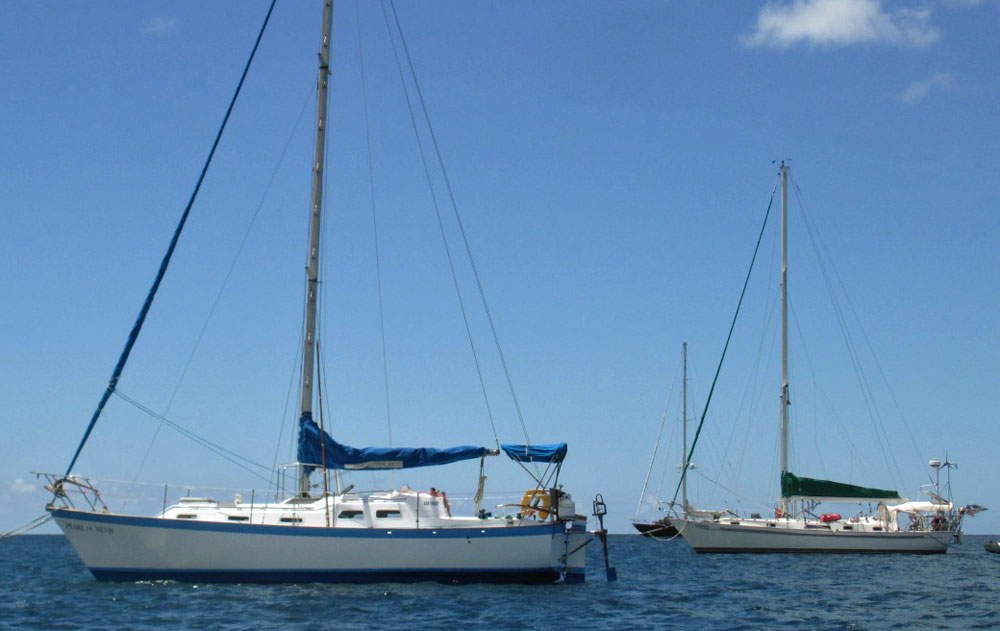
Nauticat 33
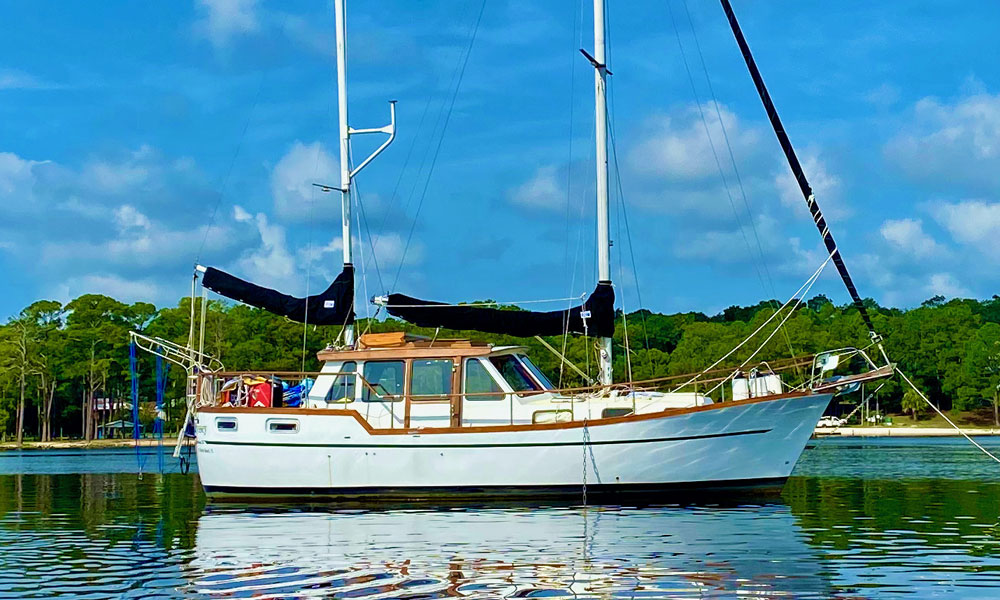
Thank you Phillip Caputo , for submitting this pic of your cruising yacht ' See Life ' .
Allied Seawind 30
Recent articles.
Island Packet 37 Specs
Aug 23, 24 03:17 PM
Jeanneau Sun Odyssey 40 Specs
Aug 23, 24 04:18 AM
Jeanneau Sun Odyssey 409 Specs
Aug 22, 24 11:02 AM
Here's where to:
- Find Used Sailboats for Sale...
- Find Used Sailing Gear for Sale...
- List your Sailboat for Sale...
- List your Used Sailing Gear...
Our eBooks...

A few of our Most Popular Pages...

Just a headsail and a mainsail - simple and efficient.
Read more...
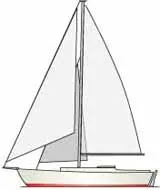
A smaller headsail and a staysail makes sail handling easier.
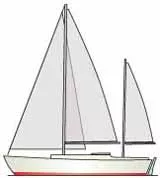
A second mast with a mizzen sail, for greater versatility.
Copyright © 2024 Dick McClary Sailboat-Cruising.com

9 Small Sailboats Under 30 Ft We Love
Our editorial staff selected 9 small sailboats under 30′ from all over the world. Today small sailboats have electronics for navigation and entertainment, an engine for light wind and accomodations to sleep onboard. Which is your preferred one between these 9 small sailboats?
Albin Vega 27

The Albin Vega 27 is a fiberglass sailboat that was produced by the Albin Motor Boat Company in the 1970s. It is a small, versatile vessel that is popular with sailors due to its good performance and comfortable interior. The Albin Vega 27 has a length of 27 feet (8.2 meters) and a beam (width) of 8.1 feet (2.46 meters). It is designed to be sailed single-handed, but can accommodate up to six people.
- Hull Type: Long fin keel
- Hull Material: GRP (fibreglass)
- Length Overall: 27′ 1″ / 8.25m
- Waterline Length: 23′ 0″ / 7.01m
- Beam: 8′ 1″ / 2.46m
- Draft: 3′ 8″ / 1.12m
- Rig Type: Masthead sloop
- Displacement: 5,070lb / 2,300kg
- Designer: Per Brohall
- Builder: Albin Marine AB (Sweden)
- Year First Built: 1965
- Year Last Built: 1979
- Number Built: 3,450
Alpin Ballad

- Hull Type: Fin with skeg-hung rudder
- Length Overall: 29′ 11″ / 9.12m
- Waterline Length: 22′ 7″ / 6.88m
- Beam: 9′ 8″ / 2.95m
- Draft: 5′ 1″ / 1.55m
- Rig Type: Masthead Sloop
- Displacement: 7,276lb / 3,300kg
- Designer: Rolf Magnusson
- Builder: Albin Marine (Sweden)
- Year First Built: 1971
- Year Last Built: 1982
- Number Built: 1500

The Bristol 24 has a length of 24.6 feet (7.5 meters) and a beam (width) of 8 feet (2.4 meters). It is designed to be sailed by a small crew, but can accommodate up to four people. The boat has a displacement of 4,920 lb (2,685 kilograms) and is equipped with a standard keel.
- Hull Type: Long Keel
- Hull Material: GRP (Fibreglass)
- Length Overall: 24′ 6″ / 7.5m
- Waterline Length: 18′ 1″ / 5.5m
- Beam: 8′ 0″ / 2.4m
- Draft: 3′ 5″ / 1.0m
- Displacement: 5,920lb / 2,685kg
- Designer: Paul Coble
- Builder: Bristol Yachts inc (US)
- Year First Built: 1969
- Year Last Built: 1972
- Number Built: 800
Contessa 28

The Contessa 24 is a fiberglass sailboat that was designed by David Sadler and produced by the Contessa Yachts company in the 1970s. The Contessa 24 has a length of 27.8 feet (8.43 meters) and a beam (width) of 9.5 feet (2.87 meters). It is designed to be sailed by a small crew, but can accommodate up to four people. The boat has a displacement of 3,162 kilograms and is equipped with a fin keel, which provides stability and improves its performance in a range of wind and sea conditions.
- Hull Type: fin keel with spade rudder
- Hull Material: GRP (Fiberglass)
- Length Overall: 27′ 8″ / 8.43m
- Waterline Length: 22′ 0″ / 6.71m
- Beam: 9′ 5″ / 2.87m
- Draft: 4′ 10″ / 1.47m
- Rig Type: Masthead sloop
- Displacement: 6,970lb / 3,162kg
- Designer: Doug Peterson
- Builder: Jeremy Rogers
- Year First Built: 1977

The Dufour 29 is a fiberglass sailboat that was produced by the Dufour Yachts company in the 1970s. The Dufour 29 has a length of 29.4 feet (8.94 meters) and a beam (width) of 9.8 feet (2.95 meters). It is designed to be sailed by a small crew but can accommodate up to six people. The boat has a displacement of 7,250 pounds (3,289 kilograms) and is equipped with a fin keel.
- Length Overall: 29′ 4″ / 8.94m
- Waterline Length: 25′ 1″ / 7.64m
- Draft: 5′ 3″ / 1.60m
- Displacement: 7,250lb / 3,289kg
- Designer: Michael Dufour
- Builder: Dufour (France)
- Year First Built: 1975
- Year Last Built: 1984
Great Dane 28

The Great Dane 28 is a fiberglass sailboat that was produced by the Great Dane Yachts company in the 1970s. The Great Dane 28 has a length of 28 feet (8.5 meters) and a beam (width) of 10.4 feet (3.2 meters). It is designed to be sailed by a small crew, but can accommodate up to six people. The boat has a displacement of 8,500 pounds (3,856 kilograms) and is equipped with a fin keel.
- Hull Type: Long keel with transom-hung rudder
- Length Overall: 28′ 0″ / 8.5m
- Waterline Length: 21′ 4″ / 6.5m
- Beam: 10′ 4″ / 3.2m
- Draft: 4′ 6″ / 1.4m
- Displacement: 8,500lb / 3,856kg
- Designer: Aage Utzon in conjunction with Klaus Baess
- Builder: Klauss Baess, Copenhagen (Denmark)
- Year Last Built: 1989
- Number Built: 300

The Sabre 27 is a fiberglass sailboat that was produced by the Sabre Yachts company in the 1970s. The Sabre 27 has a length of 27 feet (8.2 meters) and a beam (width) of 9 feet (2.6 meters). The boat has a displacement of 6,800 pounds (3,084 kilograms) and is equipped with a fin keel.
- Hull Type: Fin and skeg-hung rudder
- Hull Material: GRP (fibreglass)
- Length Overall: 27′ 0″ / 8.2m
- Waterline Length: 22′ 2″ / 6.8m
- Beam: 9′ 0″ / 2.7m
- Displacement: 6,800lb / 3,084kg
- Designer: Alan Hill
- Builder: Marine Construction Ltd (UK)
- Number Built: 400

- Hull Type: Long keel with transom-hung rudder
- Length Overall: 28′ 3″ / 8.6m
- Waterline Length: 21′ 6″ / 6.6m
- Beam: 8′ 1″ / 2.5m
- Draft: 5′ 0″ / 1.5m
- Rig Type: masthead sloop
- Displacement: 9,968lb / 4,521kg
- Designer: Kim Holman
- Builder: Uphams (UK) and Tyler (UK)
- Year First Built: 1964
- Year Last Built: 1983
- Number Built: 200
Westerly 22

The Westerly 22 is a fiberglass sailboat that was produced by the Westerly Yachts company in the 1970s. The Westerly 22 has a length of 22 feet (6.8 meters) and a beam (width) of 7.6 feet (2.3 meters).
- Hull Type:~ Bilge keel and skeg-hung rudder
- Hull Material:~ GRP (fibreglass)
- Length Overall:~ 22′ 3″ / 6.8m
- Waterline Length:~ 18′ 4″ / 5.6m
- Beam:~ 7′ 6″ / 2.3m
- Draft:~ 2′ 3″ / 0.7m
- Rig Type:~ Masthead Sloop
- Displacement:~ 4,150lb / 1,429kg
- Sail Area/Displacement Ratio: ~ 16.95
- Displacement/Length Ratio: ~ 228
- Designer:~ Denis Rayner
- Builder:~ Westerly Marine Ltd (UK)
- Year First Built:~ 1963
- Year Last Built:~ 1967
- Number Built:~ 332
Nautor Swan Merges With Sanlorenzo Group
Top 15 places sailing around mediterranean sea this summer, royal huisman project 410, ready to roll the hull, the first wallywind110 to debut at the monaco yacht show 2024, live your passion, subscribe to our mailing list.
WTH?!? why there is no boat which started it all? Pearson Triton 1959 first GRP production boat? many circumnavigated I with mine singlehandedly crossed Atlantic few times.
And no Westsail 28? :O who made this list must do better homework! ! your list is garbage!
13 Popular Full Keel Sailboats Worth Considering
Full keel sailboats are very stable and durable - they are great for cruising long distances. But there are disadvantages too. Let's look at what models to consider, and why.
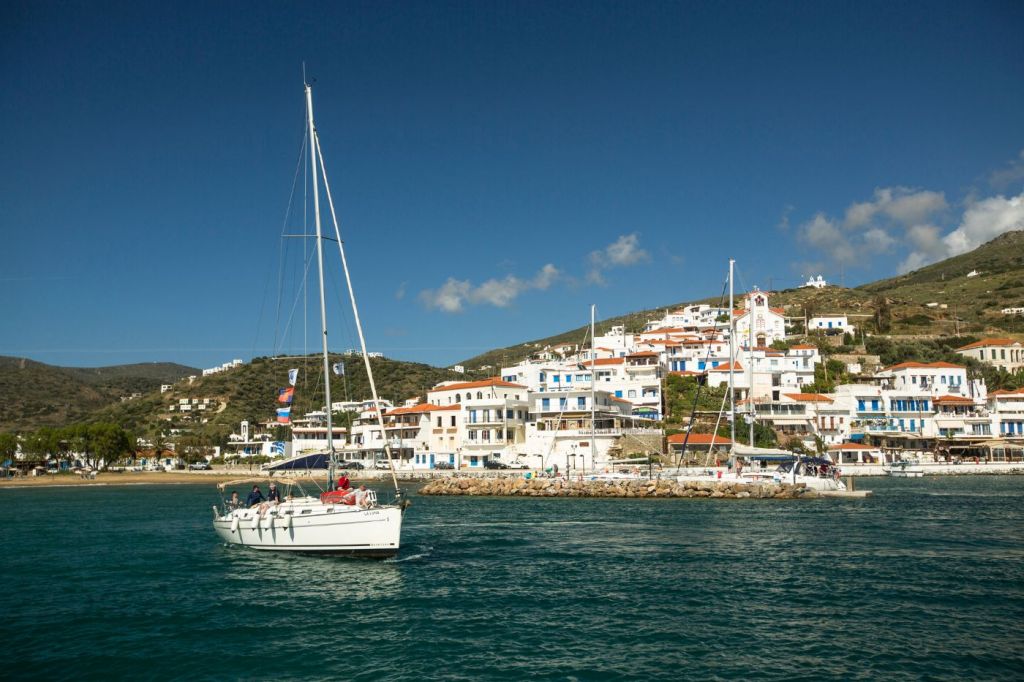
Here are 13 good full keel sailboats that are worth considering:
Nicholson 32
Island packet 380, folkboat 25, cape dory 36, vancouver 32, tradewind 33, endurance 50, westsail 32, hans christian 52.
First of all let's have a look at why you should even be preferring full keel sailboats to a more traditional, widespread classical fin keel design.
Full Keel Advantages
As with everything, there are plenty of pros and cons on each side. Full keels generally provide better handling if the weather gets tricky, they track better, provide more stability downwind, and generally stabilize the boat movements better.
Furthermore, they are way more robust, thus less prone to damage. Running ashore isn't as big of a deal as it is with a fin keel and your rudder and propeller will be more protected with the mass of the keel in front of them.
Full Keel Disadvantages
With more mass and drag comes less speed. Plus the large surface area underwater holding the direction will result in a wider turning radius, which might be annoying in smaller spaces.
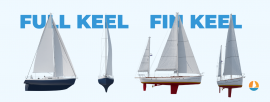
Fin Keel vs Full Keel: Pros and Cons & When to Choose Which
Fin keel advantages.
The largest advantage of fin keels is their speed. They also provide better maneuvering and a better turning radius.
Fin Keel Disadvantages
It is inevitably more prone to damage though, wear and tear will be a way bigger issue than a full keel. They won't have your back when a gust comes since the water-resistance to the side will be smaller.
It seems then that for serious longer passages, liveaboards, and long-term sailing, full keels are better. As long as you don't care for speed as much, but are concerned about the boat having your back, this is the answer. So let's now look at the superstars of the full keel universe.
The very prototype of a long-distance tough cruiser. It has been with us since 1963 and happens to be among the first fiberglass boat models produced on a mass scale. Nicholson 32 went out of production in 1981 and it was a model approved for the 2018 Golden Globe Race, proving that even older Nicholsons are still standing strong due to their toughness and ease of repair.
They were supposedly as durable as if made out of steel. Though I'll leave up to you whether you want to see that as a marketing claim or reality, such a statement can not be made without some base.
Plus the newer models have a lot of interior space, are manageable for solo sailing, and provide a sturdy ride to take one around the world.
The story here is similar to the above Nicholson - meaning that we are looking at one long-lasting high-quality cruiser. Not just because of this specific model's build - Island Packet in general was always known for this. And it is among the very few companies that, in the modern era, keep making full keel boats.
In other words, you don't see many shipyards focusing on full keels these days, so if you want one and you would rather go with a new boat, Island Packet will be one of the stops you will very probably make when doing your research.
If you are looking for reliable cruisers, you will like this one, since cruising is what it was built for, even if it meant sacrificing some performance aspects. It has a wide beam, a lot of interior space, all of the amenities a comfy cruiser should have, such as a big refrigerator with a freezer, as well as a fully equipped kitchen. The long keel here serves as a comfort helper, since, as mentioned before, it adds to the stability and reduces motion.
Not to sound repetitive, but the word 'reliability' has to be mentioned again. It seems that boat builders who choose the full keel design have something in common.
But since this particular boat was born during the Second World War and has been going strong to this very day, what other words to describe it? It has the Nordic blood in its veins since it was thought into existence by the Scandinavian Yacht Racing Union and since it prefers just about everything over comfort.
The boat is very stable, not just because of its full keel, but also because of its insane 55% ballast ratio. For those who haven't come across this before, the ballast ratio is the ratio of the ballast weight relative to the boat weight. So for instance the nearly 9 tonne Bavaria 40 with its almost 3 tonne ballast has a ballast ratio around 30 percent.
Thus you can imagine that a boat that 'wastes' more than half of its weight on ballast is serious about rigidity. These are performance racer numbers. But of course, if you are designing a boat that has to withstand the Scandinavian storms, you don't have a choice than to go overboard with specs. So if this toughness is what you seek, look no further.
...although as far as I know, all Cape Dory boats have full keels, regardless of their length. Their 36-foot model is just their most popular one. Cape Dories are known for their sturdiness, ability to cross the oceans because of their stability, and relative ease of handling.
They were engineered by Carl Alberg, who was inspired by the Scandinavian Folkboat, where reliability is worth more than comfort, or the interior space. This boat rocks a heavy rig for hardcore traveling, but its 1.5-meter draft makes it ideal for coastal cruising as well.
What's quite interesting about this particular model is that during its lifespan it went through very few changes. Boats usually evolve, sailors' feedback is taken into consideration for upgrades, but Cape Dory 36 remained relatively unchanged inside or out. This is a big compliment, since the brand started out in 1963, stopped production in 1991, and sold its blueprints so that they could be built further. Talk about longevity.
Let's progress in technology! Just because a long keel is an old-fashioned or more traditional approach, it doesn't mean it remains monolithic in its ideology. There were innovations in the concept, such as cutaways in the keel, to reduce the biggest drawback of this design, the drag.
So it only makes sense that Vancouver, a company that had distinctiveness and innovation in its mission and vision, would take part in this. Their 32-foot model that begun its lifespan in the early eighties, had a deeply cutaway forefoot, plus a rudder that was wider the deeper it was underwater, meaning its widest point was at its lowest point. This was to increase efficiency, and rudder response.
Technicalities aside, this boat was very well made, no corners cut, no expenses spared. This resulted in quite pricey vessels, out of reach of many, but much time has passed since, so today it can be yours for around 40 000 USD and up. And since the build quality was so high back then, you can still enjoy a proper boat, usually at a higher quality than boats equal its age.
The great thing about Australian sailboat makers is that they design their boats for long passages. How else would they get off of the continent? Freya 39 is a good example of this since it has not only circled the globe many times but also won the Sydney-Hobart Yacht Race three times consecutively. And that's a famously hard race.
The boat is built like a tank, with thicker fiberglass walls than you would find in its rivals. Despite that, its owners claim to have crossed over two hundred miles per day on it, a figure that is well known when it comes to this model. Which sounds plausible with its 7.8 kts of hull speed.
Its construction makes her one stable boat since it has been noted that during races, it was able to carry a spinnaker longer than its competitors, well into the 30 knots of wind speed.
The only drawback here is that if you fancy it, since it is so highly valued, and in demand, it will be tricky to find one to buy. And once you do, prepare to pay around 60 000 - 90 000 USD for it.
This one comes with a story attached to it. Once upon a time, a naval engineer Nick attempted to sail around the world. Halfway through, his boat gave up, which meant a lot of trouble for Nick, but he exited this disaster with a pretty precise idea for what his next project would be. He set on to design a boat that would be so sturdy that his sailing misfortune would never repeat.
Out of this incident paired with a smart brain, Wylo 2 was born. To make sure his design stands, after putting this boat on the water, he proceeded to live on it, while circling the globe a few times.
Others, seeing this success, bought his designs and they became quite widespread. As you might have guessed, this boat has a lot of space for living, for storing equipment and provisions, so it is comfy to live on, not only for your body but because of its sturdiness, for your mind too. These designs have accomplished some astonishing feats in all corners of the world, so if you put your trust in this design, you won't be making a mistake.
If I said this boat is sturdy and ready for just about any destination, I'd really be repeating myself now. So while that's true, let's talk about what's special about Tradewinds 33.
It has a rather small cockpit, so on-deck dinners while watching the sunset with the whole crew might be a bit improvised, but the space saved is used for an impressively spacious interior as well as a nearly flat deck. So moving about is a pleasure.
For liveaboards, this is a good idea, since storage space will be plentiful. Plus it's an elegant looking boat, with a forestaysail as a default setup. So rock on.
Time for a larger boat. So that if you want something that won't lack anything you might wish for, including space, I have something for you too. All Endurances are full keels, so if you fancy a smaller model, there is a way.
Even though it is relatively new, (you will find models from around 1995) it will make you feel like a medieval pirate, with its old-school helm, wooden interior, and a spacious aft cabin that has large windows facing back!
It is a proper bluewater cruiser, built in South Africa based on a famous Peter Ibold's Endurance blueprint. It sleeps a whole family, so if a circumnavigation with a few friends is what you seek, this is one for you.
If you are up for some single-handed sailing, pause here for a bit. Small sailboats are usually nimble, on the top of it, this one is also quite sturdy and stable, as full keels are.
You won't find much space below the deck, so don't expect to have a party of more than around two people, but at least it's a good looking interior, with charming round windows and many of the usual amenities.
They say that Mason sailboats are premium quality for a non-premium price. I wonder whether them being built in Taiwan has something to do with it.
Here is a quote by an owner of a 1986 model that says it all: "I am absolutely captivated by the boat and am not objective at all in my feelings toward her. The general construction is of the highest standard. Like an Irish hunter, she is a workhorse and a lady-maybe not quite as fast around six furlongs as a racehorse, but for the long pull, through timber, brush, and over walls, she is really something."
Now although this owner admits subjectivity, this boat indeed was built with quality in mind. Sturdiness too - not only is its fiberglass hull properly solid, but it also features longitudinal stringers to add further rigidity.
There is a lot of brightwork, which might sound nice at first glance, but since it requires quite a lot of maintenance, some owners even said they could do with less wood if it meant less upkeep.
All in all though, when it comes to getting a lot of boat for not a lot of money, this is it.
Does it make sense to even praise how heavy and sturdy this boat is built? Probably not at this point. Just know it ticks all the boxes. It is made of 12 layered fiberglass for Pete's sake.
The design was based on ideas of the Norwegian engineer Colin Archer, who made his boats such that they could withstand the northern seas. Pair that with the fact that the interior here is surprisingly spacious with 6 ft 2 in of headroom and you've got yourself one comfortable circumnavigator.
The issue stemming from the heavy build and a full keel, which is a slower pace, applies here more than usual though. This boat is absolutely reliable, but don't expect winning speed races.
Sadly, Westsail 32 was in production only for some 9 years. Sales were booming, they made over 800 boats, but bad business practices and cash flow issues resulted in its demise.
Not the author, the boat. If beauty and elegance are what you are after, this one will catch your eye. Just as was the case with Mason, these boats were produced in Taiwan. But since the goal of the engineers was to create the 'ultimate cruising sailboat' and they spared no expense, expect to pay hundreds of thousands of dollars for these boats, even though decades old.
The gorgeous classical design paired with the high build quality makes these exclusive pieces of work, plus quite a modern one since they ceased production in the 90s. So if you don't mind the higher price mark and are looking for something relatively new, that will, thanks to the build quality, last you for many years to come, this might be your choice.
Full keel sailboats are sturdy. Not only is that because of the full keel which itself provides a lot of structural integrity. But also because the choice of putting the full keel in means you are building something that prefers ruggedness and reliability over anything else. So it is logical that the rest of the boat will be built in the same fashion.
So if you don't mind sacrificing the few knots of extra speed, if you don't mind the smaller pool to choose from, if you want a boat that will have your back in pretty much any situation and place you will choose to go to, if you want to sail the Scandinavian design, go for it.
Arthur Rushlow
What a great page. Both my wife and I sailed Faulk Boats out of Canada prior to our moving to Florida. Once we arrived in Florida we had a Soveral 26 built we raced for three years prior to my returning to College and now 5 degrees later I am an Anglican Bishop with no boat.
Leave a comment
You may also like, 5 surprising advantages of a full keel sailboat.
Modern keel designs favor fin keels, with the high-performance boats using bulbs with narrow chord sections and deep drafts. Very few full keel designs are being …

Fin Keel vs Full Keel: Pros and Cons & When to Choose Which
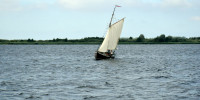
7 Legendary Solo Bluewater Sailboats Worth Considering
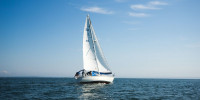
13 World-Famous Bluewater Sailboats Under 40 Feet

17 Legendary Bluewater Sailboats Under 50 Feet (with Photos)

IMAGES
COMMENTS
The Pardeys are icons of small sailboat cruising. Having sailed over 200,000 nautical miles and circumnavigated both east and westbound on their home-built, engine-free, sub-30-feet cutters, they are among the most recognized sailors in the world. They're also known as "America's first couple of cruising.".
Vancouver 28. Photo credit: YachtFathom.co.uk. A sensible small boat with a "go-anywhere" attitude, this pocket cruiser was designed with ocean sailors in mind. One of the best cruising sailboats under 40 feet, the Vancouver 28 is great sailing in a small package. Hull Type:Full keel with transom hung rudder.
The 10 best bluewater boats. 1. Westsail 32. Photo credit: SailboatData.com. The Westsail 32 is one of the most iconic bluewater cruisers and 19 have set out to cross the Pacific in the PPJ rally since 2009. In 1973, this small cruising sailboat garnered a 4-page spread in Time magazine.
When making their 28-foot bluewater sailboat, Sabre Yachts took every aspect into consideration when designing her. ... Best Bluewater Sailboats Under $50K. Daniel Wade. December 28, 2023. Popular Posts. Best Liveaboard Catamaran Sailboats. Daniel Wade. December 28, 2023. Can a Novice Sail Around the World? Elizabeth O'Malley. June 15, 2022. 4 ...
Length: 35′. Courtesy Gemini Catamarans. The Gemini Legacy 35 is a bluewater sailboat under 40 feet designed with a focus on stability, safety, and ease of handling. Its catamaran design, with a beam of 14 feet, provides remarkable stability both at anchor and underway.
The best bluewater sailboats under 40 feet. 1. The Westsail 32. Westsail 32. Photo credit: sailboat data.com. The Westsail 32 is one of the most iconic bluewater cruisers. Built by the Westsail Corporation in the 1970s, this plucky, small sailboat has developed a cult following over the decades. Since 2009, 19 have set out to cross the Pacific ...
With these considerations in mind, here are my picks—five top choices for affordable bluewater cruising sailboats (in alphabetical order). Caliber 40 LRC. The Caliber 40 design appeared in 1991 and through its evolution into the 40 LRC, remains a very attractive cutter. It has a fully encapsulated, elongated fin keel, and the ballast to ...
What Are The Best Bluewater Sailing Boats? Generally, a blue water sailboat should be a minimum of 30-35 feet in length to be able to safely traverse common wave lengths in the open ocean (i.e. the length of one wave crest to the next), self-righting (or extremely sea-worthy like a large catamaran) and feature a protected and enclosed helm and ...
Comfort Ratio and Ride Quality. Flexible Sailplan for All Types of Weather. Handholds and Safe Decks. 10 Best Offshore Bluewater Sailboats. Tayana 37. Pacific Seacraft/Crealock 37/40/44. Baba/Tashiba/Panda 40. Valiant 40/42/47/50. Norseman 447.
This 53-footer is idiosyncratically French, and it's also a superbly focused bluewater cruiser. Designed to be handled by a couple, its ketch rig is docile yet effective, with sails set on electric furling gears and some ingenious sail handling systems. Nearly 500 of these boats were built before Amel replaced it with the 54.
Here are the best liveaboard sailboats for bluewater cruising. 1. Pacific Seacraft Flicka 20. cdmech. The Flicka 20 is the smallest and most interesting sailboat on our list. At only 20 feet overall in length, the interior accommodations of this vessel are spartan at best and suitable for minimalist living.
Allures 51.9 price: €766,000. The Ovni 370 is another cunning new aluminum centreboard offering, a true deck saloon cruiser for two. The designers say the biggest challenge was to create a ...
Dufour Grand Large 360. Dufour Grand Large 360 Jon Whittle. Dufour Yachts introduced its new 360 Grand Large model to CW's Boat of the Year team in 2018 as a coastal cruiser intended for a couple or perhaps a small family. With that in mind, judge Alvah Simon found numerous clever elements to praise within the boat's 35-foot-2-inch hull—a ...
An ideal length for a bluewater sailboat is at least 30-35 feet in length, but boats such as the Dana 24 and Flicka 20 provide the same excellent stability as others despite being smaller. One common feature of the best bluewater sailboats is having a protected helm and accommodation that is well-protected from the elements.
With these considerations in mind, here are my picks—five top choices for affordable bluewater cruisers (in alphabetical order). Caliber 40 LRC. The Caliber 40 design appeared in 1991 and through its evolution into the 40 LRC, remains a very attractive cutter. It has a fully encapsulated, elongated fin keel, and the ballast to displacement ...
Today's pocket cruisers make the best use of fiberglass technology and offer much beamier and voluminous hull shapes with longer and thus faster waterlines. Boats like the Hanse 315, Beneteau 31, Jeanneau 349 or the Catalina 315 have the space inside of 40 footers from the old days. And the modern designs sail so much better, too.
Below, the Tartan 3700 has two cabins and one head with a stall shower. The saloon has the space of a much bigger boat and there's a full-sized nav station which is perfect for long-distance cruising. A new 3700 will set you back around $400,000, and 10 to 12 year-old Tartan 3700s list for between $170, 000 and $220,000.
Top Ten Affordable Bluewater Cruisers (according to SailFarLiveFree.com) 10. CSY 33: With a production run of only 57 boats, it's not surprising that many people aren't familiar with CSY's smallest sailboat. Her swoopy sheerline and sharp bow beckon me.
Additionally, the Prout Snowgoose 37 can fit into a single-hull marina, reducing berthing costs when compared to most other catamarans. If you have never considered a catamaran in the past, the Prout Snowgoose 37 may change your mind. Prices start near $45,000, with later models reaching over $100,000.
Bluewater Sailor Under 35 — Panda/Baba 35, Tashiba 36. ... Best Liveaboard Sailboats Under 40 Feet (35-40 Feet) Forty feet is the sweet spot for most cruising couples—big enough to be comfortable and carry enough provisions but small enough that handling and maintenance are manageable. This class of boat has a lot of excellent choices in ...
Westerly Seahawk 35; Westerly Kestrel 35; Westsail 32; Willard 30/8t; X-332; X-342; Medium sized cruising yachts like these are capable of serious offshore passage making, whilst being reasonably economic to maintain and operate. And for competitive types, 30-35 foot cruising yachts are a popular size for club racing under handicap rating rules.
The Sabre 27 is a fiberglass sailboat that was produced by the Sabre Yachts company in the 1970s. The Sabre 27 has a length of 27 feet (8.2 meters) and a beam (width) of 9 feet (2.6 meters). The boat has a displacement of 6,800 pounds (3,084 kilograms) and is equipped with a fin keel. Hull Type: Fin and skeg-hung rudder.
Here are 13 good full keel sailboats that are worth considering: Nicholson 32. Island Packet 380. Folkboat 25. Cape Dory 36. Vancouver 32. Freya 39. Wylo 2. Tradewind 33.